| |  |  IMMEDIATE ASSIGNMENTS: IMMEDIATE ASSIGNMENTS:• For TH, 3/24: Indians in Unexpected Places: "Athletics" (109-135)
—ALL students: mark 2-3 "significant" passages
—"selected students" (T-W): Response #4; uploaded to Canvas by W, March 23rd, by midnight • Reminder: Quizzes will always/only involve the readings assigned for that day. •
(Moreover, the make-up is a lot more work—for both of us!• For TU, 3/29: Indians in Unexpected Places: 136-223
—ALL students: mark 2-3 "significant" passages for each assigned chapter;
—"selected students" (E-K, L-Ph): Response #4; uploaded to Canvas by M, March 28th, by midnight • For TH, 3/31: Indians in Unexpected Places: 224-240 (Conclusion)
—ALL students: mark 2-3 "significant" passages
| Extra Credit Opportunity: Write a one-page-or more summary of/response to this lecture, for a max of 10 extra credit points (due as email attachment by SU, April 20th, midnight). Note that register to attend the webinar:::: | -=- The E.N. THOMPSON FORUM ON WORLD ISSUES -=-
Walter Echo-Hawk: "Reckoning and Reconciliation on the Great Plains": April 6, 7:00 p.m., Lied Center for Performing Arts"Echo-Hawk is an author, attorney, and well-renowned legal scholar. Echo-Hawk's wealth of experience and knowledge will inform Nebraskans not only about the histories of injustice against Pawnee people and other Indian nations, but also about how we can all take steps to heal from and repair the abuses of the past to build a society based on dignity and respect for all. Walter Echo-Hawk will share his deep knowledge of the UN Declaration on the Rights of Indigenous Peoples and truth and reconciliation efforts to bring justice and healing to Indigenous peoples in Nebraska, and worldwide. For more information, to reserve free tickets, to watch the livestream, or to access recorded lectures, visit https://enthompson.unl.edu." [My note:] Echo-Hawk's role in recent Native activist legislation is seminal:
• "As a staff attorney of the Native American Rights Fund (1973-2009), he represented Indian Tribes, Alaska Natives, and Native Hawaiians on significant legal issues in the modern era of federal Indian law, during the rise of modern Indian Nations in the tribal sovereignty movement. He litigated indigenous rights pertaining to religious freedom, prisoner rights, water rights, treaty rights, and reburial/repatriation rights."
• "1986-1990: He represented tribal clients to obtain repatriation legislation: (a) precedent-setting legislation in Nebraska (1989) and Kansas (1988) directing museums to return and rebury dead bodies and grave objects to Tribes of origin; (b) the 1989 reburial agreement with the Smithsonian Institution enacted into the National Museum of the American Indian Act; (c) the 1986-1990 legislative campaign culminating in the passage of Native American Grave Protection and Repatriation Act (NAGPRA)."
• "1990-1994: He represented the Native American Church of North America to obtain passage of the American Indian Religious Freedom Act Amendments of 1994.
• "In 2010, he represented the Klamath Tribes in a trial to quantify treaty-protected Indian water rights for hunting, fishing, and gathering purposes; and various Tlingit tribes to repatriate sacred objects and cultural patrimony." |
 The 1491s: "I'm an Indian, Too" (YouTube) The 1491s: "I'm an Indian, Too" (YouTube) |
|---|
| —The 1491s are a Native comedy troupe, and in case it's not obvious, this vid is, in part, another satire on "Pretendians" and Indian wanna-be's. But more generally, it's "theme" is—"Hey, there are all kinds of Indians"?! (Oh, I just found out that this is a satire of an old show tune!—see next.) |
|
|---|
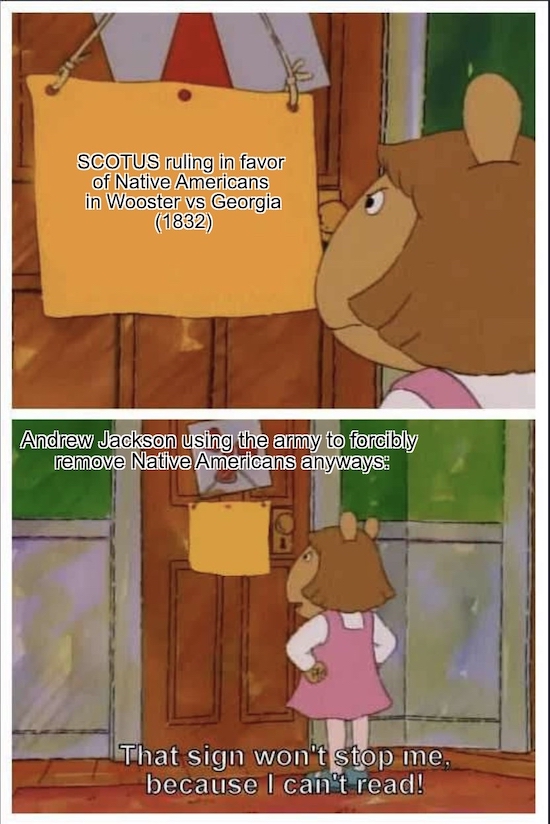 |
|---|
| —Meme just shared w/ me by a student (thanks!); if you don't get it, see K&V 64-65. (Of course, "Wooster" should be "Worcester.") |
|
|---|
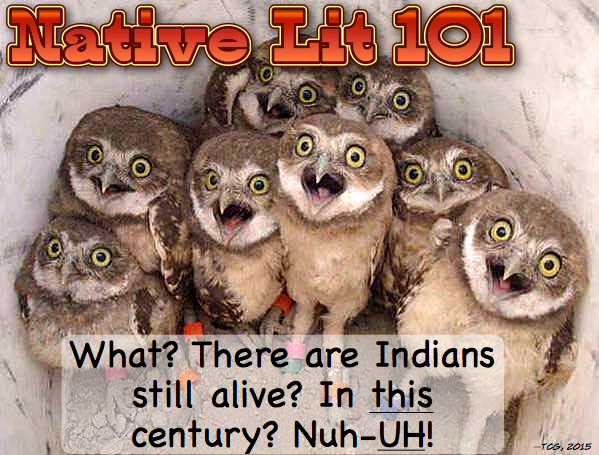 |
|---|
| One might say that P. Deloria's entire book is "simply" about proving this stereotype false. |
|
|---|
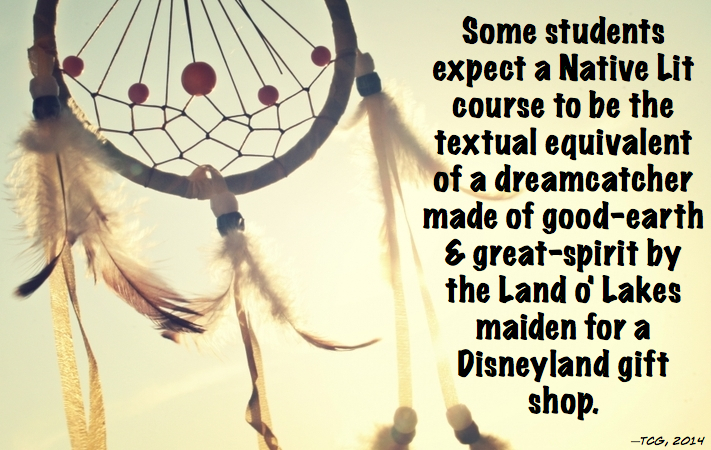 |
|---|
| —a common reaction to my Native Lit courses |
|
|---|
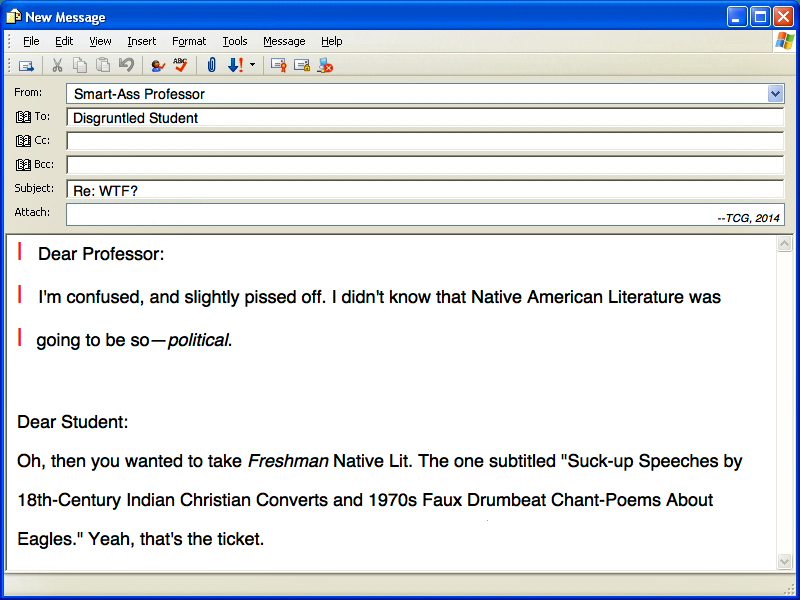 |
|---|
| —another common reaction to my Native Lit courses |
|
NOTE: I am intentionally brief, even abbreviatory, in the following NOTES because I mean them to function as reminders & sources of review rather than to serve in lieu of coming to class: they DON'T. However, this page has a further usefulness: by "Commentary," I mean that some points in these class notes are expanded upon (and re-organized) in ways that our limited class time—and my rather manic teaching style—disallowed. . . .
| = = = = PRESENTATION GROUPS = = = = |
|---|
• I have created RANDOM groups for the final class presentations via Canvas's randomize function. (In Canvas, go to "People"=>"Presentation Groups." You can also email the rest of your group, if need be, via Canvas's Inbox.)
• I will adjust these groups only to address inequities in group sizes due to student drops or chronic truancies.
• Don't worry, Group #1, we'll draw lots to see who goes first! | | | #1: Andrew Brandt, Nicholas Burbach, Karley Coday, Laekyn Collins, Jonathan Harrah | | | #2: Violet Hudson, Isabelle Kripps, Shay Parlier, Wakinyan Running Bear Strecker, Caitlyn Thomas | | | #3: Alexie Logue, Jacob Newburn, Helen Philbrick, Bella Syslo | | | #4: Breanna Armstrong, Kalli Kilgore, Faithleigh Podzimek, Susie Welker | | | #5: Evelyn English, Viangri Sontay Lopez, Rianna Wells, Brittney White |
 TU, Jan. 18th:: Syllabus, etc.; incl. my Native American History "Outline" (PDF, in the "00 Intro Materials" folder on Canvas) TU, Jan. 18th:: Syllabus, etc.; incl. my Native American History "Outline" (PDF, in the "00 Intro Materials" folder on Canvas)
 TH, Jan. 20th:: Healy's "American Indians" chapter (my PDF summary in the "00 Intro Materials" folder on Canvas); Burns poem: TH, Jan. 20th:: Healy's "American Indians" chapter (my PDF summary in the "00 Intro Materials" folder on Canvas); Burns poem:
SURE YOU CAN ASK ME A PERSONAL QUESTION How do you do?
No, I am not Chinese.
No, not Spanish.
No, I am American Indi—Native American.
No, not from India.
No, not Apache.
No, not Navajo.
No, not Sioux.
No, we are not extinct.
Yes, Indin.
Oh?
So that's where you got those high cheekbones.
Your great grandmother, huh?
An Indian Princess, huh?
Hair down to there?
Let me guess. Cherokee?
Oh, so you've had an Indian friend?
That close?
Oh, so you've had an Indian lover?
That tight?
Oh, so you've had an Indian servant?
That much?
Yeah, it was awful what you guys did to us.
It's real decent of you to apologize.
No, I don't know where you can get peyote.
No, I don't know where you can get Navajo rugs real cheap.
No, I didn't make this. I bought it at Bloomingdales.
Thank you. I like your hair too.
I don't know if anyone knows whether or not Cher is really Indian.
No, I didn't make it rain tonight.
Yeah. Uh-huh. Spirituality.
Uh-huh. Yeah. Spirituality. Uh-huh. Mother
Earth. Yeah. Uh-huh. Uh-huh. Spirituality.
No, I didn't major in archery.
Yeah, a lot of us drink too much.
Some of us can't drink enough.
This ain't no stoic look.
This is my face. —Diane Burns, c. 1989 |
' * VINE DELORIA, JR.: "Indian Humor" (Trout 654-62) 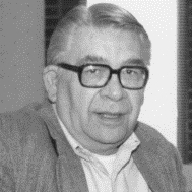 |
|---|
| | * humor => a people's "collective psyche" (655) | | | | —NatAmer. the "opposite," really, of the "wooden Indian"/"Kawliga" stereotype (655); key reason for humor?: survival! (662) | | | * JOKES: Columbus; Custer; Christian missionaries; nationalism, and . . . | | | | —"militancy" (656, 660-662): note date of essay (1969); indeed, Deloria's sometimes strident tone of protest approaches that of the A.I.M. (the American Indian Movement) of the late 1960's & early 70's. . . . |
| | À propos of Native "militancy,"
here is my version of the
popular bumper-sticker/t-shirt
slogan (replacing an armed
Geronimo & company with
Tatanka Iyotanka [Sitting Bull]) | 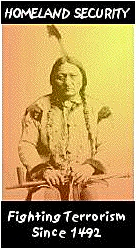 |
| • Vis-à-vis Vine Deloria, Jr. on Custer: | 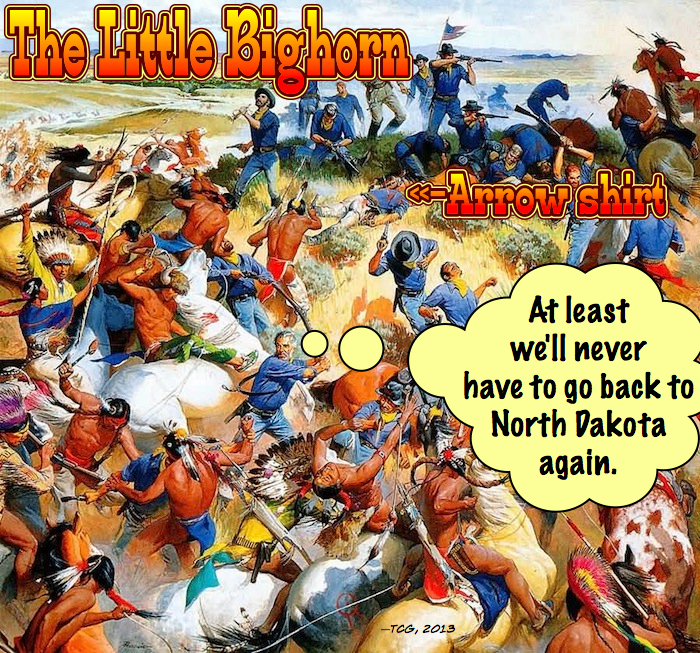 | 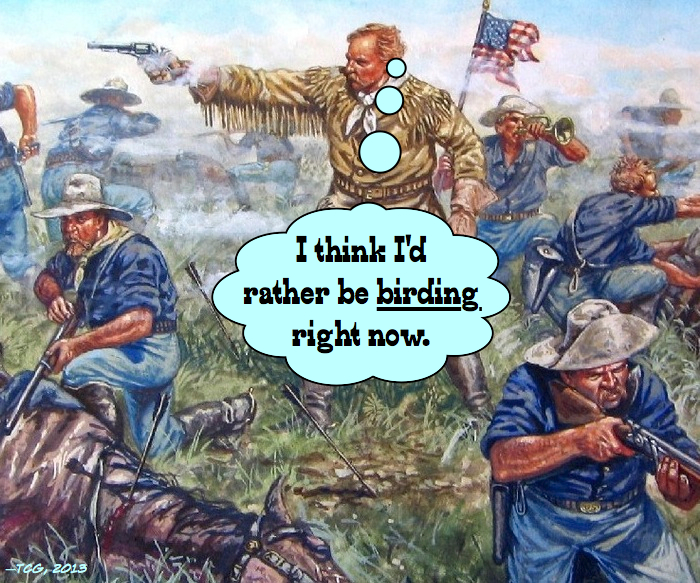 |
|---|
| (painting by William Reusswig; jokes stolen from Vine Deloria, Jr.) | (graphic "borrowed" from Google Images) |
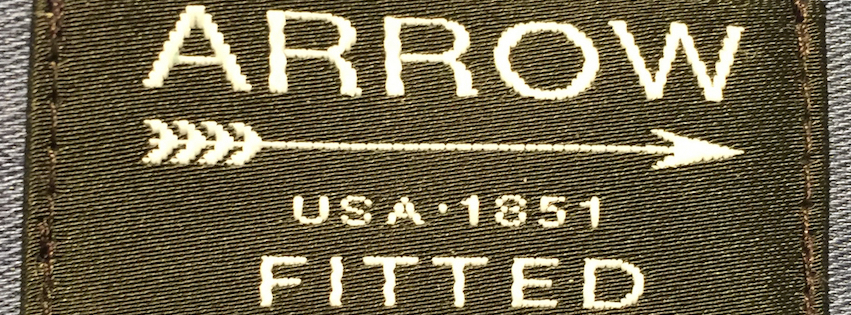 |
|---|
Regarding Deloria's joke about Custer being a
"well-dressed" fellow at the Little Big Horn—
a photo of the neck tag of my
almost brand new ARROW shirt |
 TU, Jan. 25th:: TU, Jan. 25th::
 * Vine Deloria, Jr.: "Indians Today, The Real and Unreal" (Trout 7-15) * Vine Deloria, Jr.: "Indians Today, The Real and Unreal" (Trout 7-15) |
|---|
| | * "Indians," above all, PROJECTIONS of a Western colonial MYTHOLOGY, "mythical Indians of stereotype-land" (7-8) | | | | —early colonial myths from Columbus, on—often of a (positive) "noble savage" (8-9, 10) | | | | —but also incl. negative conflation with other animals, as (a wild/non-human) "savage" and a "wild species" (9-11, 12) | | | * Indeed, whites (often claim to) "understand Indians"—largely based on pop. stereotypes, however (10). | | | * White Americans' NEED to IDENTIFY with/as Native American (8-9)—Why?: | | | | —"Indian-grandmother"/"descendent of Pocahontas" complex: female (less threatening), a New World "royalty" (9) | | | | —need for "some blood tie with the frontier," with the American soil? (9) | | | | —an avoidance of "facing the guilt" of white culture's abusive treatment of Native Americans? (9) | | | * Legal/social status, contrasted with historical plight of African-Americans (11-13) | | | | —Natives not "recognized" as human until the colonizers' realization: "they got land!" (11) | | | | —African-Americans traditionally segregated [as the OTHER], NatAmer assimilated [as the SAME] (12) | | | * NatAmer vs. Western WORLDVIEW [fairly essentialist] (13) | | | —NatAmer "simplicity and mystery" vs. Western "knowledge"?! (13) (Elsewhere, Deloria says, "The white man . . . has ideas; Indians have visions." As for Western religion: "The Christian environment is always a ruined and destroyed, a totally exploited, environment.") | | | | | | | —NatAmer pre-Columbian political history also laudable in its democratic structure (13) | | | * Final CALL TO ACTION: "What we need is a cultural leave-us-alone agreement" (14). (Any problems with this assertion?) |
 "Take a Picture with a Real Indian" (James Luna [YouTube]) "Take a Picture with a Real Indian" (James Luna [YouTube]) |
|---|
—Related to Deloria's point that most Americans only "know" (and want) the 19th-century "Indian"?
(See K&V 126-127 on Native performance art, of which this a good example!) |
• Note that I have a PowerPoint for the Preface & Chpt. 1 on CANVAS (Kidwell&Velie--Preface&Chpt1--hilited.pptx, in the "00 INTRO MATERIALS" folder)
• For my detailed K&V notes & commentary, see my outline of Chpts. 2-8 on CANVAS (K&Voutline--CH2thru8.docx, in the "00 INTRO MATERIALS" folder)
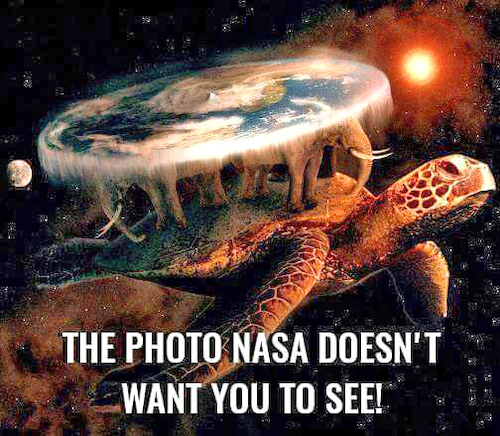 |
|---|
| "Turtle Island"?! (Kidwell and Velie 25) |
 Note on the TRICKSTER archetype/NatAmer deity-motif (K&V 32-33, 108-109): In NatAmer folklore/myth in general, Coyote is the most common Trickster, a cosmic & natural force blessed with both sheer animal "stupidity" and uncanny animal cunning. In Lakota stories, for instance, he is forever losing his tail, getting chopped up into bits, and generally making a mess of the cosmic order. But he always comes back to life, and the world is better off for his shenanigans. (Also prominent as a Trickster in Lakota myth is Iktomi, the spider. In the Pacific Northwest, Raven [or Crow, or even Blue Jay] is Trickster.) The function of these tricksters has long been debated. My own reading relies on Jungian psychology, Bakhtinian dialogism, and ecology/ecocriticism. Jung reads the trickster as an aspect of the Shadow archetype—that "dark" complex of the unconscious psyche whose real role is to make the ego realize that it is out of balance, through its sheer repression of that "dark" side. The literary theorist Bakhtin claimed that the dominant social discourse towards order and reason necessarily entails a "polyphonic" (multi-voiced) reaction, in myth, literature, and society itself. Regarding this latter, he points to various cultural manifestations of "Carnival," wherein the common folk go "crazy" in an established ritual that is directed against the (repressive) social order. (Cf. Mardi Gras!) Finally, in a purely naturalist/ecological sense, the Trickster is "raw" instinctual animal, always erupting into "civilized" (and repressed) human consciousness as a magical & numinous force—again, as a corrective against an oh-so-blind ego-faith in order and rationalism: a reminder at last that WE are animals, that cosmic evolution needs entropy and chaos, that to remain in any blithe condition of stasis is a psychological and cultural death. Note on the TRICKSTER archetype/NatAmer deity-motif (K&V 32-33, 108-109): In NatAmer folklore/myth in general, Coyote is the most common Trickster, a cosmic & natural force blessed with both sheer animal "stupidity" and uncanny animal cunning. In Lakota stories, for instance, he is forever losing his tail, getting chopped up into bits, and generally making a mess of the cosmic order. But he always comes back to life, and the world is better off for his shenanigans. (Also prominent as a Trickster in Lakota myth is Iktomi, the spider. In the Pacific Northwest, Raven [or Crow, or even Blue Jay] is Trickster.) The function of these tricksters has long been debated. My own reading relies on Jungian psychology, Bakhtinian dialogism, and ecology/ecocriticism. Jung reads the trickster as an aspect of the Shadow archetype—that "dark" complex of the unconscious psyche whose real role is to make the ego realize that it is out of balance, through its sheer repression of that "dark" side. The literary theorist Bakhtin claimed that the dominant social discourse towards order and reason necessarily entails a "polyphonic" (multi-voiced) reaction, in myth, literature, and society itself. Regarding this latter, he points to various cultural manifestations of "Carnival," wherein the common folk go "crazy" in an established ritual that is directed against the (repressive) social order. (Cf. Mardi Gras!) Finally, in a purely naturalist/ecological sense, the Trickster is "raw" instinctual animal, always erupting into "civilized" (and repressed) human consciousness as a magical & numinous force—again, as a corrective against an oh-so-blind ego-faith in order and rationalism: a reminder at last that WE are animals, that cosmic evolution needs entropy and chaos, that to remain in any blithe condition of stasis is a psychological and cultural death. |
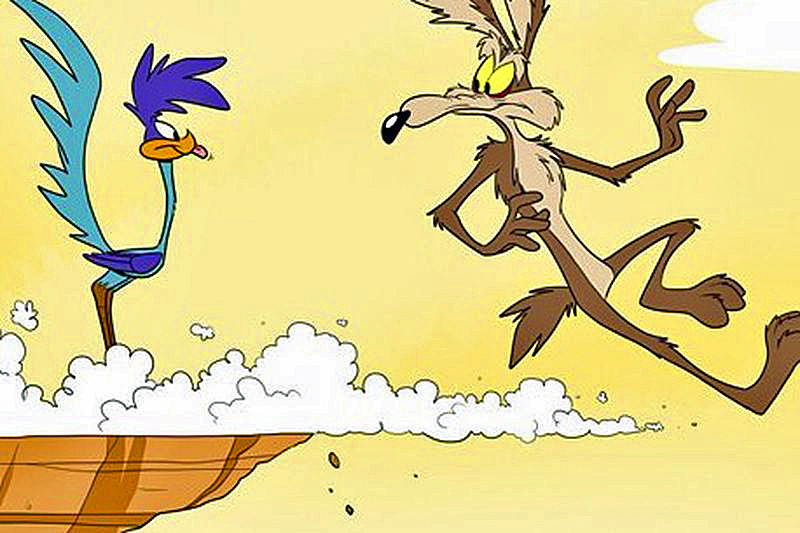 |
|---|
Wile E. Coyote—the Trickster
as Warner Bros. cartoon? |
 TH, Jan. 27th:: TH, Jan. 27th::
• For my detailed K&V notes & commentary, see my outline of Chpts. 2-8 on CANVAS (K&Voutline--CH2thru8.docx, in the "00 INTRO MATERIALS" folder)
| *—Some Crucial LEGISLATIVE & LEGAL DECISIONS regarding Native regarding Native Religious Freedom—* |
|---|
| 1883-1934: | Federal ban on the Lakota Sun Dance (comparable restrictions on other tribes' major ceremonies standard during this same period) | | 1887: | Dawes Act: allotment (division) of Natives' lands in Oklahoma; similar laws regarding other Indian lands soon followed, the negative ramifications of which included a de facto repression of Native traditionalism | | 1892: | Church of the Holy Trinity v. United States: U.S. Supreme Court decision that included the declaration that "this is a Christian nation" | | 1934: | Indian Reorganization Act: as with the Dawes Act, this restructuring of reservation tribal governments further diminished Native traditionalism | | 1978: | American Indian Religious Freedom Act (AIRFA, which Vine Deloria, Jr., claimed is toothless) [K&V 75-76] | | 1978: | Indian Child Welfare Act (ICWA) [K&V 78] | | 1988: | Lyng decision: Supreme Court rules against Native rights to sacred/ceremonial sites on public lands (in favor, instead, of land developers [or rather/supposedly: the "greater good" of the public interest]) [K&V 76] | | 1990: | Native American Graves Protection and Repatriation Act (NAGPRA) [K&V 77; see V. Deloria's "A Simple Question of Humanity," written the year before] | | 1990: | Oregon v. Smith: Supreme Court ruling that state laws override any purported Native rights to use peyote for religious purposes (ergo illegal) [K&V 76] | | 1993: | Supreme Court allows/protects Native religious use of peyote; 1994: Congress agrees/"ratifies" [K&V 76; I don't have the whole background on this one, but I imagine that some version of the government's "proof of [Native] faith" prescription that Deloria often discusses has rendered this legalization nearly as problematic as the 1978 legislation.] |
|
|---|
 |
|---|
| —Meme just shared w/ me by a student (thanks!); if you don't get it, see K&V 64-65. (Of course, "Wooster" should be "Worcester.") |
 TU, Feb. 1st:: TU, Feb. 1st::
• Again, my detailed K&V notes & commentary, see my outline of Chpts. 2-8 on CANVAS (K&Voutline--CH2thru8.docx, in the "00 INTRO MATERIALS" folder)
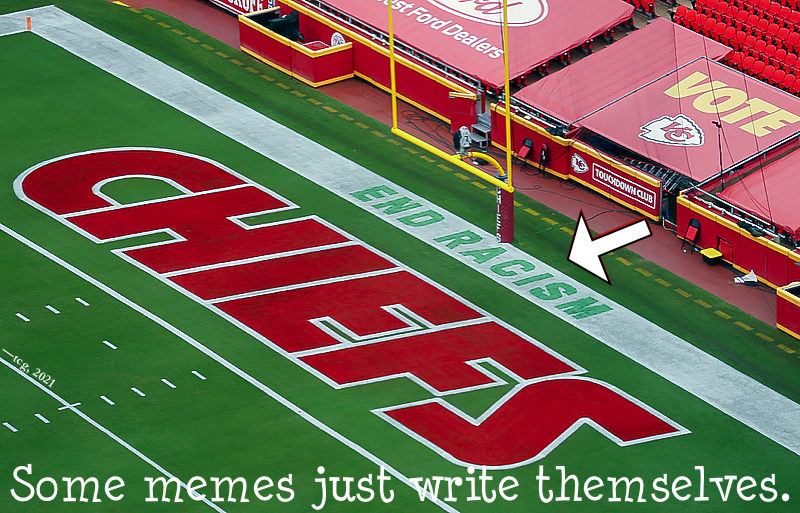 |
|---|
| —about the time of the 2021 Super Bowl . . . (Yeah, I know, I'm sorry: there are a lot of CHIEFS fans in Nebraska! But sooner or later, people are going to realize that "Chiefs" is damn near as racist as "Redskins," especially given the arrowhead iconography.) |
 "Keep America Beautiful" (YouTube) "Keep America Beautiful" (YouTube) |
|---|
| —The "Crying Indian" (or the Eco-Indian)—the famous Earth Day PSA, 1971: both the tears and the Indian were fake. ("Iron Eyes Cody" was Italian; the "tear" was glycerin.) |
 TH, Feb. 3rd:: TH, Feb. 3rd::
• One last time!: for my detailed K&V notes & commentary, see my outline of Chpts. 2-8 on CANVAS (K&Voutline--CH2thru8.docx, in the "00 INTRO MATERIALS" folder)
 RESPONSE #1—Due TUES., 2/8 (uploaded to Canvas by midnight)—CHOOSE ONE (2 or more pages): RESPONSE #1—Due TUES., 2/8 (uploaded to Canvas by midnight)—CHOOSE ONE (2 or more pages):
—Don't worry about MLA formatting, headers, etc.; but do indicate which option you're doing, please.
a) Respond to K&V's Native American Studies by devising your own summary of what "Native American Studies" actually is, or should be. (As your OWN summary, it will necessarily highlight some of K&V's central points and de-emphasize, if not even denigrate, others.) Refer to various passages from the book in making your argument. (I can imagine this as a tongue-in-cheek response, if you're so inclined, as long as you maintain a proper respect for the subject!)
b) Evaluate K&V's text as an introductory textbook. That is, is it a good or bad example thereof? Why? If if it is bad or only pretty good example, what would you change to make students more engaged with Native American Studies? Again, refer to various passages from the book in making your argument.
c) Free (but focused) Response: develop your own topic-choice as a focused response on some aspect or related aspects of K&V—for example, some specific issue or event or phenomenon that you found especially interesting.
d) As mentioned on the syllabus, another option is to turn in a do-your-own-thing "READER'S JOURNAL" that addresses a "goodly" range of the K&V chapters (and earlier readings?), including via creative responses. (These should ideally be responses you wrote immediately after reading, so there's no danger of simply rehashing class ideas [see final caveat below]!)
e) Use K&V (again, in a concerted fashion!) in your reaction to a current "Indian Country" controversy or issue. (See, for example, my "In the News" links above. (For example, how does students wearing Native regalia at a graduation ceremony relate to the "grander issues" discussed by K&V?! Or: how about non-Natives going on vision quests [the Yellowstone article linked above]?)
f) Use K&V (again, in a concerted fashion!) to respond to our last President's Columbus Day pronouncement. (Don't worry if you're a fan of the Donald: I severely doubt that he wrote the proclamation himself.)
—Note: For all responses, please include p#'s in parentheses for any specific references to K&V. (This also demonstrates that you BOUGHT the BOOK!) Also, please avoid simply rehashing ideas brought up in class or in my outlines of K&V provided only. Feel free to object to/expand upon these, of course, but above all, try to do "something else" that still demonstrates that you've done the reading.
|
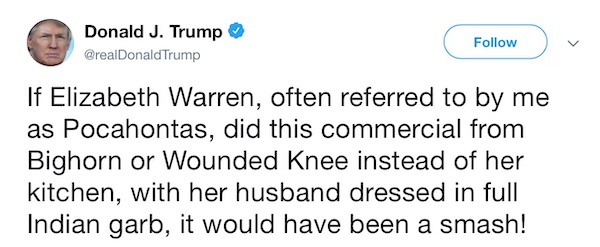 |
|---|
"I'm glad Native American Studies doesn't have to combat stereotypes anymore!"
(For starters, what does Pocahontas's east-coast Powhatan tribe have to do, at all, with Wounded Knee or the Little Bighorn?And of course, nor does Warren's claim of Cherokee blood have any relation to Pocahontas.) |
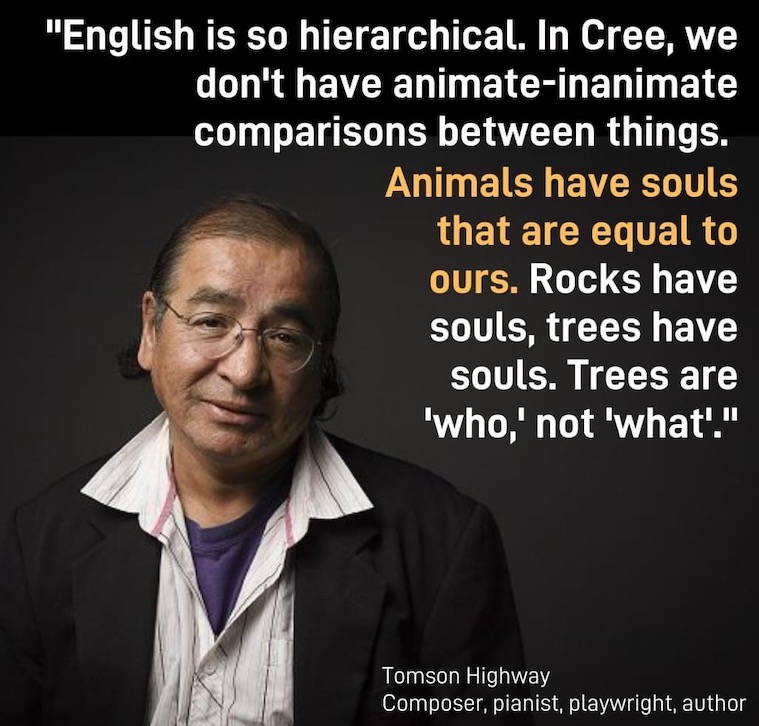 |
|---|
| Language = epistemology. |
 TU, Feb. 8th:: TU, Feb. 8th::
 Newcombe: "500 Years of Injustice" (Native American Voices 101-104) Newcombe: "500 Years of Injustice" (Native American Voices 101-104) |
|---|
| | • Newcombe traces a series of causes and effects: Euro-colonizers' 15th-century Doctrine of Discovery led to Justice Marshall's Supreme Court decisions of 1823 (which basically rehearsed the DofD) and of 1831 (which claimed the U.S.'s "plenary" [absolute] power over tribes); this led to the breaking of treaties (incl. Fort Laramie Treaty of 1868) & land theft. Newcombe calls for an end to this "unconstitutional" series of legal precedents, in part through an appeal to the "separation of church and state" clause in the Constitution (103B). | | | • Note also the date of the essay: 1992 (500 years after Columbus "sailed the ocean blue"); thus the powerful indictment in the ¶ beginning "During this quincentennial" (101B-102A). |
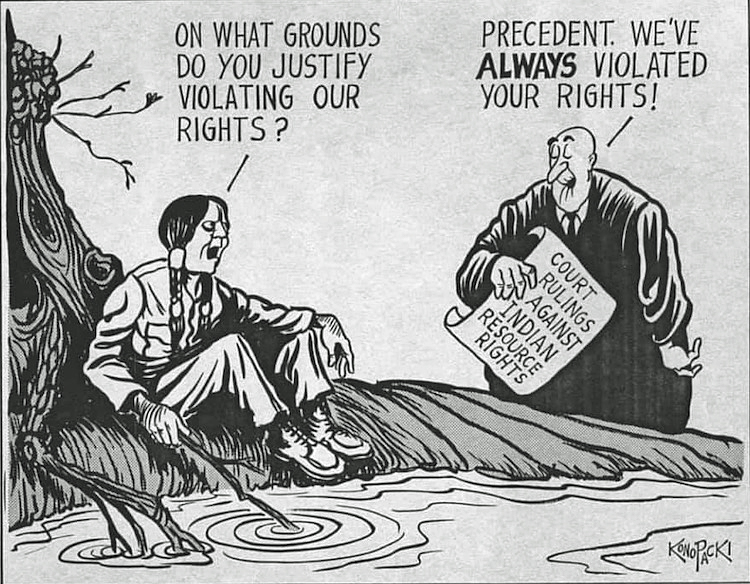 |
|---|
| —Ha! Pretty much in accord with the Newcombe & Wilkins essays, etc. |
 |
|---|
| —The headline is real; I just changed the list in the photo. |
 Wilkins: "A History of Federal Indian Policy" (NAV 104-112) Wilkins: "A History of Federal Indian Policy" (NAV 104-112) |
|---|
| | • A well-organized & detailed intro to its topic by an obviously serious academic historian; the essay/chapter covers a lot of dates & events "we already know," but no source so far is as comprehensive in its historical/legal coverage. For example, see the two ¶s on the pros and then the cons of the Indian Reorganization Act (110). | | | • While the tone seems much more "objective, fair and balanced" here (as is the case w/ most academic historians), note that Wilkins agrees with Newcombe that Marshall's 1823 decision is based on the old "Doctrine of Discovery" (and is thus questionable) (106B) and that the Constitution's "separation of church and state" clause is apparently a crock in its (lack of) application to Native Americans (107B-108A). | | | • Oops: The Trail of Broken Treaties protest march took place in 1972, not 1973 (111A). | | | • Wilkins' conclusion seems right on about the "ambivalence" of U.S. federal policy regarding Native sovereignty, et al.: "The policy ambivalence evident in the conflicting goals of sometimes recognizing tribal self-determination and sometimes seeking to terminate that governing status has lessened only slightly over time. Tribal nations and their citizens find that their efforts to exercise inherent sovereignty are rarely unchallenged, despite their treaty relationship with the United States" (112B). |
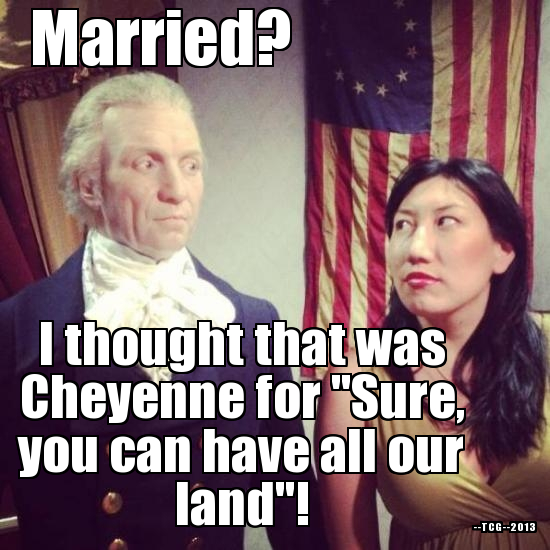 |
|---|
| Something close to this almost happened after Custer's massacre of Black Kettle's Cheyenne band at the Washita. |
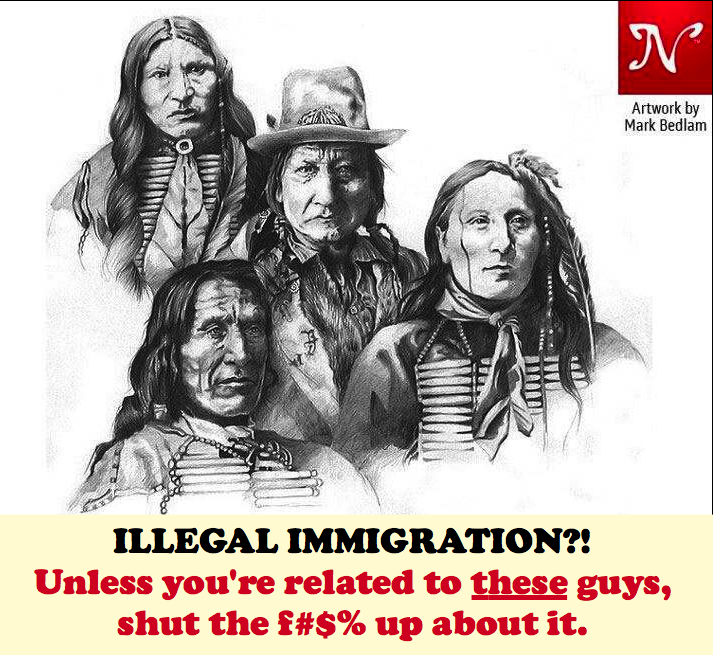 |
|---|
| —my text/design-edit of a Facebook-shared meme |
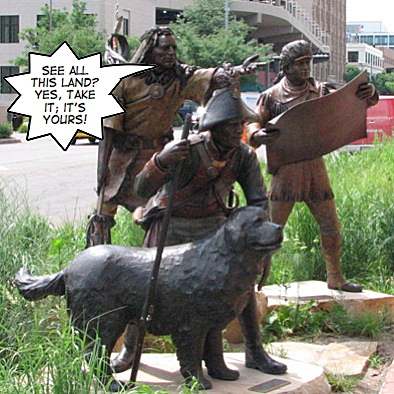 |
|---|
| —my (old, bad) photo of the Lewis & Clark statues—w/ a satirically accommodating Native dude—down by the Great Plains Art Museum |
 Floyd Red Crow Westerman (w/ Trevy Felix): "Missionary" (Hen House Studios [YouTube]) Floyd Red Crow Westerman (w/ Trevy Felix): "Missionary" (Hen House Studios [YouTube]) |
|---|
| —Written soon after Vine Deloria, Jr.'s Custer Died for Your Sins, this song's lyrics could have been ghost-written by Deloria, I swear! (In fact, Westerman's 1969 album was also called—Custer Died for Your Sins!) |
 TH, Feb. 10th:: TH, Feb. 10th::
 Gonzales: "The Black Hills" (NAV 113-119) Gonzales: "The Black Hills" (NAV 113-119) |
|---|
| | • Like Newcombe's essay, this is certainly written from a position of activism & advocacy. (See especially the ¶ about "plunder" [116B]; the ¶ on "the Spirit of Crazy Horse" [117A]; and the ¶ w/ the phrase "officious intermeddlers" [118A].) Gonzales's essay is certainly the most "pro-Indian" of the three, but his evidence regarding the breaking of the Fort Laramie Treaty in the U.S.'s "land grab" of the Black Hills (114) is pretty damning. (But so was the U.S. Supreme Court's own 1980 decision that found the U.S.'s seizing of the Black Hills to be the most "ripe and rank case of dishonorable dealings . . . in our history" (114B). | | | • The "Powder River War" is better known (by me, at least!) as Red Cloud's War—which, according to Gonzales, "was the first military conflict that the United States ever lost" (114). By "conflict," G. obviously means an entire war, not a single battle. Other sources have claimed the War of 1812 (against Great Britain) as the U.S.'s first lost war; it seems at least a draw? In any case, partisans who claim that the Vietnam War was "our" first loss seem pretty short-sighted. | | | • Note: the long Brown Hat quot. is confusing—"I went to the Black Hills and cried, and cried, and cried"—unless you know that it refers to Brown Hat going on a vision quest, which, in one Lakota formulaic expression, is "to cry for a vision." | | | • Newcombe's final calls to action regarding Bear Butte incl. appeals to the religious freedom clause of the 1st Amendment and to the 1978 American Indian Religious Freedom Act of 1978 (118B). | | | • In conclusion: "The Lakota tribes' rejection of the $100 million ICC [Indian Claims Commission] award for the Black Hills in 1980 has come to symbolize Native American resistance in North America" (119A); and indeed, "the long-term survival of the Lakota people depends on how the Black Hills claim is ultimately resolved" (119B). | | | • Hey, w/ "compound interest," the $100 million is now—er, was when the essay was written, in 1996!—$380 million (119B). Hmmm. . . . |
 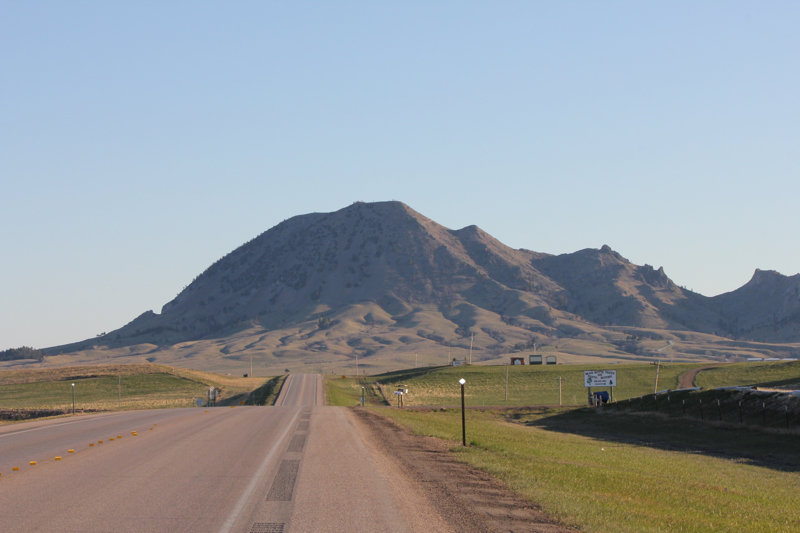 Bear Butte, SD (TCG, 2009, 2011; select thumbnail for larger photo)
| |  Charles A. EASTMAN—(from From the Deep Woods to Civilization:) "The Ghost Dance War" (Trout 266-76)— Charles A. EASTMAN—(from From the Deep Woods to Civilization:) "The Ghost Dance War" (Trout 266-76)—
—tone/attitude/word choices—"whose side is he on?!" (par. 3: "wild Indians"; par. 8: "wilder element"; par. 12: "ghost dance craze"; par. 22: "wilder Sioux"); par. 13: "malcontents" [incl. Big Foot, Kicking Bear (who had, by the way, travelled out West to meet with Wovoka), and the son of Red Cloud]—vs. par. 13, par. 15: "Friendly"'s [incl. American Horse; Red Cloud?!] . . . [BUT—par. 12: "poor natives" vs. white "politicians"; par. 25, 35: "so-called" hostiles; after massacre: par. 29: "poor creatures" (a change in tone/attitude after massacre?)] . . . You might also the ponder the perhaps greater import, in terms of Eastman's assimilation, of the following words of a white woman back East: "'I know one Sioux who has not been conquered, and I shall not rest till I hear of his capture!'" (par. 21)—the irony of which escaped Eastman himself!?
—Consider the statement towards end (par. 34): "All this [the slaughter] was a severe ordeal for one [Eastman] who had so lately put all his faith in the Christian love and lofty ideals of the white man." HOWEVER, he immediately continues: "Yet I passed no hasty judgment. . . ."!?
—ironic contrasts: "Christmas season"! (par. 20); E.'s white intended, who's half "Puritan," half Tory! . . . betrothal: "Christmas day of 1890" (par. 22) (massacre: Dec. 29th—the morning of which was "sunny and pleasant"! [par. 25])
—à la today?: note the deleterious role of the press (par. 17, par. 30)
—results/description of massacre per se: par. 31-32 (no comment); incl. survival of 1-yr.-old baby . . . cavalry: 25 dead, too—but mostly from friendly fire!*—Black Elk, in Black Elk Speaks, also describes a pathetic scene, of "Dead and women and children and little babies"; "I saw a little baby trying to suck its mother, but she was bloody and dead." —telling final two words of essay: "superior force"
—Finally, note the Christian ground springs of the (therefore syncretic) Ghost Dance religion: Wovoka not only called himself a "messiah" and the "Indian Jesus," but referred to Christ frequently; the GD movement therefore both thoroughly messianistic and millennialist (that 1,000 or 2,000-year thing, in which "a new day will dawn" [Led Zep!])—two notions fairly alien to traditional Native thought. (Indeed, the 1st paragraph of Eastman's chapter—omitted by Trout—begins: "A religious craze such as that of 1890-1891 was a thing foreign to the Indian philosophy" [From the Deep Woods 92].) |
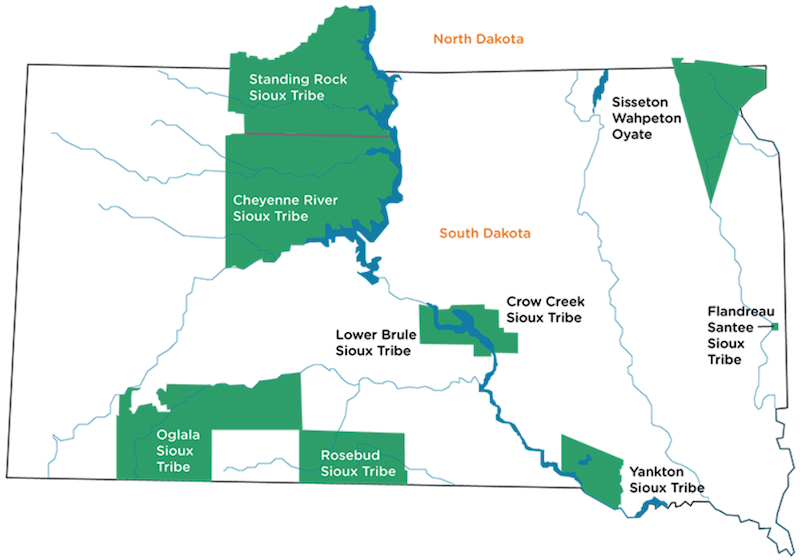 |
|---|
| —South Dakota reservations (for Eastman essay, etc.) |
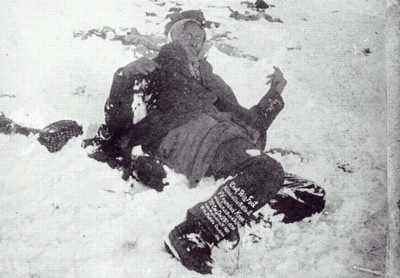
Famous photo of slain Mnikoju Lakota chief Big Foot (Si Tanka) at Wounded Knee.
* more Images of Wounded Knee, incl. the open mass-grave trench (or see my meme, below)
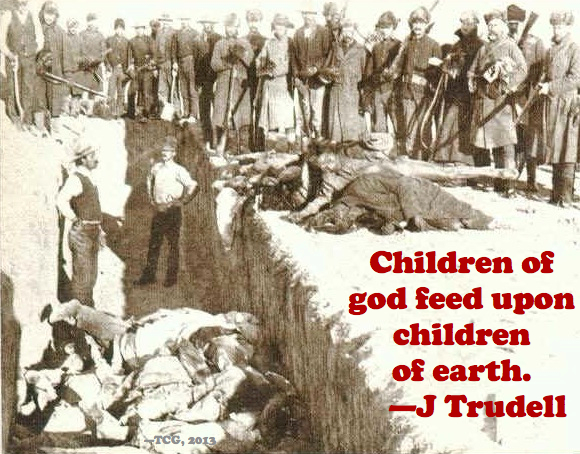 |
|---|
—photo "borrowed" from Google Images
(Wounded Knee mass burial) |
 Elizabeth Cook-Lynn: "New Indians, Old Wars" (NAV 194-198) Elizabeth Cook-Lynn: "New Indians, Old Wars" (NAV 194-198) |
|---|
| | • 9/11/2001—the U.S.'s response to the Twin Towers attack: C.-L. finds "a connection between this defensive act and the U.S. response to the killing of . . . Custer [at the Little Bighorn] in 1876" (194A). (Wow. Pretty incendiary stuff?! Indeed, her "angry," in-your-face tone far surpasses that of, say, Newcombe or Gonzales, to the point of being a bit too heavy-handed at times?) | | | • Speaking of Native history—C.-L. turns to the Black Hills land/suit "issue" (194-195A), noting (as Gonzales did) that $ "compensation has been the only remedy available . . . a remedy rejected by the entire Sioux Nation for many decades" (194B). (Uh, the Lakota Nation[s], specifically; maybe only a Dakota writer like C.-L. would use "Sioux" here?! [Okay, she is from an older generation. . . .]) Also, as with Gonzales, C.-L. notes that even the U.S. Supreme Court admitted it to be land "theft" in 1980 (195A). | | | • Regarding the 1950s "relocation laws," C.-L.'s claim that "two-thirds of the entire Indian population" of the U.S. "was relocated to cities in the West" seems a bit high (195B)! (See my Healey PowerPoint.) | | | • Now as for the essay/book title: These are the matters of "old wars" taken up by "new Indians" who know and remember that thousands have died terrible deaths on this unlucky journey" of Euro-colonization (195B). (And now her numbers estimate might be a bit low!?) | | | • The U.S. dilemma (oh, "sweet land of liberty" and high-blown ideals): the historical treatment of Natives is difficult fact to handle for "a powerful nation claiming an honorable place [indeed, the highest place of idealistic values!] among nations throughout the globe." C.-L. even dares to use the word "genocide": it's an historical fact that the U.S. "has pursued policies throughout the generations that led to the decimation of the first nations on this continent" (195B). | | | • "Anti-Indianism" is C.-L.'s term (from a previous book of hers) for racism against Native Americans; here she claims it to be a basic "concept in American Christian life, just as Islamophobia and anti-Semitism are concepts in Christian Europe" (196A; wow). | | | • Now she turns to the [doctrine of] "'discovery period'"—when the colonizers refused to really know the Native Americans, but instead projected such qualities as "simple and good," or "savage and cruel, or "ignorant and deficient," or—"not human" (196B). | | | • Back to the Native history/current Middle East analogy that began the essay: the new U.S.-enforced Iraqi constitution "is much like the illegal, colonial IRA constitutions written for and by" Native American reservations "eighty years ago, charts for democracy that have, unfortunately, failed to meet the needs of the people." Indeed, unless the U.S. "begins to understand that its victims will no longer accept the idea begun [in] 1492 that 'inferior' races and civilizations can be wiped off the face of the earth, it will face constant war" (196B). | | | • Why this "repeat of history"? It "may be that the ideology of civilizing and Christianizing negatives so deeply embedded in the Euro-American experience is a consistent" reflection of Euro-Americans' "continuing social needs and aspirations" (197A; a rather vague statement in need of unpacking, no doubt). | | | • The crux: "The people in the Middle East" now invaded by the West "are not uncivilized, and neither were the Indigenous peoples of North America. They are not savages, and neither were" Native Americans. "Iraqis are not without god, language, or culture. Neither were the peoples of the Americas" (197B). (And yet, after the 9/11 attacks—and supporting C.-L.'s argument—the Bush Administration consistently employed a binary rhetoric of "civilization" versus "barbarism.") | | | • Conclusion & Thesis: "the unfortunate people called the 'terrorists' of the twenty-first century in Baghdad have become what the 'savages' of the northern Plains were thought to be so long ago" (197B). | | | • Ultimately what matters is who controls the message (and who gets to call the other side "terrorists"!?): "who controls the language by which the stories are told is still the ultimate power" (197B). And so: "New Indians must tell the new history about the old wars because they have been witness to savagery and terrorism—and continue to be" (198A). (Note C.-L.'s re-inscription/reversal of "savage" & terrorist" throughout this essay—a move anticipated by our next author, Zitkala-Ša, when she basically asks out loud, regarding some rude white students, "Who are the real barbarians here?!") | | | • Finally—"Make no mistake: a holocaust happened here in our own lands and it continues here and elsewhere" (198). |
| | 
Joy Harjo: "I Give You Back"(from How We Became Human 50-51) |
|---|
| | —As in other famous poems of hers, like "Remember" and "She Had Some Horses," note the characteristic "oral"-repetition style; this poem is often read as JH.'s own reply, her own "getting over," the personal demons/complexes of "She Had Some Horses," via a powerful personification of—and inner dialogue with—her own "fear": "I release you." | | | —[Old student question:] What does the stanza beginning "Oh you have choked me, but I gave you the leash" mean? | | | —[My question:] The "I am not afraid" repetitions often combine opposites, "black" & "white," etc.—an all-encompassing interrelatedness, as it were. Does this include, then, forgiving/accepting the cruel facts of colonization ("raped and sodomized," etc.)? | | | —[My question:] Aside from the "oral" repetition, does the number FOUR work its way into this poem? [Yes, in the 4x refrains of "I release you" (50) and, even, "my heart" (51).] |
 Joy Harjo: "Fear Song" (YouTube) Joy Harjo: "Fear Song" (YouTube) |
|---|
| —A later set-to-music version of "I Give You Back," from Joy's CD Native Joy for Real (2004) |
| | 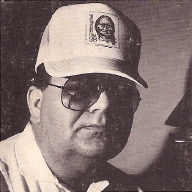
Adrian C. Louis: "Red Blues in a White Town the Day We Bomb Iraqi Women and Children"(from Among the Dog Eaters, 1992) |
|---|
| | —Epigraph/quot. of Iraqi widow: the tables turned, the Orientalization of the Native American by "Orientals"! . . . middle section of poem: the bullying of the Native boy by three white boys—note the "muddying" of the history book!—until he fights back, to the admiration of the narrator . . . then the political shift in the final strophe, a protest against U.S. policies during the first Iraqi war—carried out by "Long distance killers with college degrees"—and the clear parallel between such a war and government policies towards the Native American (see Cook-Lynn's essay): they are a "sand tribe," after all; and the strange conclusion: what/which "God" is this?—when "a sand tribe's blood splashed up / to white clouds / to blue sky / to God's face" (invoking again the red-white-and-blue mock-patriotism of the poem's title)? |
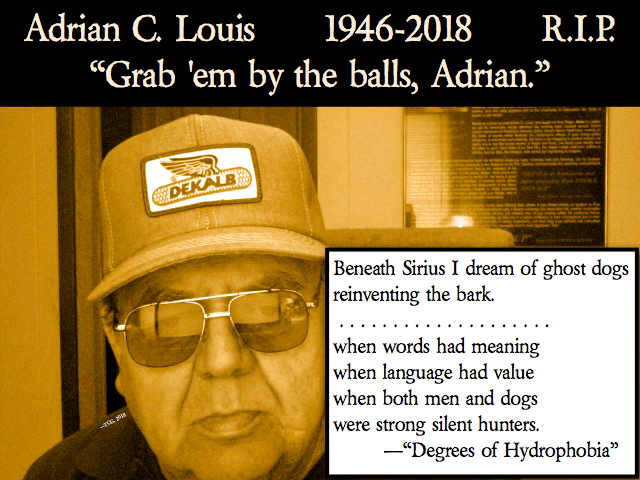 |
|---|
| —my meme-tribute to Adrian when he died a few years ago (2018) |
 John Trudell: "Rich Man's War" (YouTube) John Trudell: "Rich Man's War" (YouTube) |
|---|
| —After a stint as the President of A.I.M., Trudell went on to become a poet-songwriter, whose lyrics were quite in accord w/ A.I.M.'s "radicalism." |
 TU, Feb. 15th:: TU, Feb. 15th::
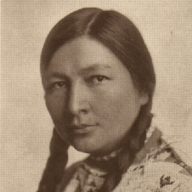 | Zi[n]tkala-Ša [zee(n)t-KAH-lah SHAH] = "bird-red" (Red Bird) |
|---|
| * TRIBE: "Yankton Sioux" (the Yankton & Yanktonais bands of SE SoDak) = Nakota tribe ([see Dominguez xix (the intro in our edition)], though usually called Dakota, even by Zitkala-Ša herself); blood quantum!: "one half Sioux" (Fisher xix) | | * LIFE: | | | 1876: born Gertrude Simmons (her step-father's last name), on the Yankton Reservation (SE SoDak)—the same year, by the way, as the Battle of the Little Bighorn | | | 1884: missionaries show up; and so to an Indian boarding school—White's Manual Institute—in Indiana (which she attended, with some intervening years at home, to 1895) | | | [1890: the Massacre of Wounded Knee, about which Zitkala-Ša is oddly "reticent": "Nowhere in these stories is there a reference to this historical act of genocide" (D&N xxxiii).] | | | 1895-1897: to Earlham's College (Indiana), and to poetry writing & oratory contests | | | 1897-1899: teaching at Carlisle Indian Industrial School! | | | 1899-1902?: study at the New England Conservatory of Music (violin) | | | 1900-1902: composes bulk of her literary output [see next list] | | | 1902: married to Raymond Bonnin, which some claim signaled the "decline" of her literary career (Fisher xiii) | | | 1903-1916: living with husband, now a B.I.A. employee, on a Utah reservation. where she further develops her bent for Indian activism—including her . . . | | | 1913-1918: activist denunciation of Native peyote use, for which the "liberal ethnologist James Mooney . . . denounced" her "as a fraud," for wearing an Indian outfit that was a hodge-podge from different tribes (D&N xxi-xxiii)! | | | 1916: Bonnins move to Washington, D.C., upon Zitkala-Ša's election as secretary & treasurer of the Society of the American Indian—"the first national pan-Indian political organization run entirely by Native people" (D&N xxix-xv; founded 1911, "dissolved" in 1919); and a new, more public life of activism on behalf of Native Americans, including calling for Indian citizenship (granted 1924) and the removal of the Sun Dance ban (legalized 1934, via the Indian Reorganization Act) | | | 1926: founds the National Council of American Indians, for which she was president until her death in . . . | | | 1938: died; "In perhaps the greatest misrepresentation of a life often misrepresented, she was described in the hospital's postmortem report as "'Gertrude Bonnin from South Dakota—Housewife'" (D&N xxviii)! | | * WORKS: | | | 1900: Atlantic Monthly: "Impressions of an Indian Childhood"; "The School Days of an Indian Girl"; "An Indian Teacher among Indians" [all later included in American Indian Stories] | | | —Praise(?!) of Zitkala-Ša in an issue of Harper's Bazaar in 1900: "Zitkala-Ša is of the Sioux tribe of Dakota and until her ninth year was a veritable little savage" (qtd. in Fisher vii; see also Helen Keller's letter in the old advertisement in the back of our text). | | | 1901: book: Old Indian Legends; Harper's Magazine: "The Soft-Hearted Sioux" [later included in American Indian Stories] | | | 1902: Atlantic Monthly: "Why I Am a Pagan" | | | —Carlisle founder Richard Pratt's review of this essay: "its author was 'worse than a pagan'" (D&N xix). | | | 1913: collaborated with William Hanson on the "Indian opera" Sun Dance (revived on Broadway in 1937 [Fisher]—or 1938? [the year of her death: D&N]) | | | 1921: book: American Indian Stories | | | —"[S]he calls her new book the 'blanket book' (the cover image was an image of a Navajo blanket)" (D&N xxvii; note: traditional Indians were often referred to as "blanket Indians"). | | | —". . . one of the first attempts of a Native American woman to write her own story without the aid of an editor, an interpreter, or an ethnographer" (Fisher vi) | | | —Her work "lay in some obscurity after her death in 1938 before being rediscovered and reassessed in the 1970s and 1980s" (D&N xiii). | | * HER TWO WORLDS: | | | —"Zitkala-Ša had every right to feel nervous about her mission to become the literary counterpart of the oral storytellers of her tribe because she felt compelled to live up to the critical expectations of her white audience" (Fisher vii). | | | —"To her mother and the traditional Sioux on the reservation . . . she was highly suspect because, in their minds, she had abandoned, even betrayed, the Indian way of life by getting an education in the white man's world. To those at the Carlisle Indian School . . . on the other hand, she was an anathema because she insisted on remaining 'Indian,' writing embarrassing articles such as 'Why I Am a Pagan' that flew in the face of the assimilationist thrust of their education" (Fisher viii). . . . "Zitkala-Ša has been accused of 'selling out' largely because of the difficult balancing act she attempted as a mediator between tribal, bureaucratic, and activist concerns" (D&N xxiv). | | | —Name change—after quarrel with sister-in-law: "I bore it [the name Simmons] a long time till my brother's wife—angry with me because I insisted upon getting an education—said I had deserted home and I might [as well] give up my brother's name 'Simmons' too. Well, you can guess how queer I felt—away from my own people—homeless—penniless—and even without a name! Then I chose to make a name for myself—and I guess I have made 'Zitkala-Ša' known . . . " (qtd. in Fisher x). . . . Also noteworthy: her brother's (only) given name was actually David; "Zitkala-Ša fictionalized him as Dawée" (D&N xv)! | | | —Religion: "We can do little more than attempt to keep up with her rapid moves between Catholicism, paganism, Mormonism, and Christian Science" (D&N xv). | | | —"Though she would spend her life working for the rights of Indians and would become one of the most vocal spokespersons of the Pan-Indian movement in the 1920's and 1930's, Zitkala-Ša was never reconciled with her mother. She spent her life in balance between two worlds, using the language of one to translate the needs of another. She was in a truly liminal ['border'] position, always on the threshold of two worlds but never fully entering either" (Fisher xiii). | | | —"Controversial to the end, Gertrude Bonnin remained an enigma—a curious blend of civilized romanticism and aggressive individualism. Her own image of herself eventually evolved into an admixture of myth and fact, so that by the time of her death in 1938, she believed, and it was erroneously stated in three obituaries [in major Eastern newspapers], that she was the granddaughter of Sitting Bull . . . though her own mother was older than Sitting Bull [and they weren't even from the same tribe!]" (Fisher xvii). . . . "Zitkala-Ša herself was implicated in propagating this myth. It became one of her favorite autobiographical stories. . ." (D&N xiv). | | | —"Her career also exemplifies the tremendous difficulty confronting minority people who would become writers but who are constantly under pressure from their own groups to use literature toward socio-political ends. . . . The wonder is that she wrote at all and in so doing became one of the first Indians to bring to the attention of a white audience the traditions of a tribe as well as the personal sensibilities of one of its members" (Fisher xvii-xviii). | | | —Subversion/"Reinvention"?: [regarding "School Days":] "Resisting the pressures of assimilation in small ways, employing trickster strategies such as vandalizing the school's Bible, she was able to maintain a sense of herself" (D&N xvi). | | SOURCES: | | | Fisher = Dexter Fisher's Foreword to the previous U of Nebraska P edition of American Indian Stories | | | D & N = Davidson & Norris's Introduction to American Indian Stories, Legends, and Other Writings (Penguin Classics) | | | | (A more legible/printable version of this handout/outline is on CANVAS, in the "05 ZITKALA-S(H)A" folder.) |
| ** Z-SHA PRE-READING NOTE: I tend to approach longer literary texts—like Z-Sha's three-part autobiography—as a structuralist of sorts, identifying its building blocks, which I like to call "MOTIFS" (as in musical motifs: snippets of melody or chord progressions that get repeated throughout the "symphony" that is the text). In Z-Sha, for instance, it's interesting to follow her DICTION (word choices: e.g., "wigwam," "paleface," "iron horse": WHY? who is her AUDIENCE?); her common FIGURES OF SPEECH (e.g., the recurring comparisons, implicit or explicit, to "wild animals"); her use of literary conventions (e.g., those Victorian over-dramatic, emotional moments?!; the Biblical plot motif of temptation & disobedience). Also, speaking of her audience, how might that have affected her TONE and POINT OF VIEW? How would you characterize her tone (attitude)? How does her tone & PofV change thru the three sections? |
| * "Impressions of an Indian Childhood" [1900] (AIS 7-24) |
|---|
| | I: "My Mother" (7-11) | | | | —intro setting "exotic" (for her Eastern white audience), a "wigwam" by the "Missouri" (7) [Why "wigwam" [7, 9, 12, etc.] (an Abenaki dwelling/word [northeastern Algonquian tribe]) instead of the Dakota word "tipi" (which she will use later)?!] | | | | —Mother's characterization (any stereotypes for her audience?): "sad and silent [stoic!]" (yet tearful) (7)—why? | | | | —Z-Ša's characterization (any stereotypes for her audience?!): a "wild little girl of seven," "light-footed," "free as the wind" and as "spirited" as "a bounding deer"; full of "wild freedom and overflowing spirits" (8) | | | | —Cousin "Warca-Ziwin" (Sunflower) [Lakota: wahcazizi (wahkCHAHzeezee), "yellow flower"; or wahcazi tanka (wahkCHAHzee TAHNka), "big flower"] | | | | —Reason for mother's sorrow: the actions of the "paleface" [again note the Western-dimestore-novel word choice (9, 39, etc.)]; Z-Ša's reaction: "'I hate the paleface that makes my mother cry!'" (9) . . . "the paleface has stolen our lands and driven us hither[!—word choice!]"—"like a herd of buffalo" [Native = animal, an eventual motif] . . . and the death of Z-Ša's sister and uncle, upon the tribe's reaching "this western country" (10). [Note: the Dakota were previously inhabitants of Minnesota, mostly, until forced to various reservations in eastern SoDak & NoDak.] | | | II: "The Legends" (12-17) | | | | —Indian Ed. 101: Z-Ša hears the "old legends" (13). | | | | —Emphasis on Dakota "hospitality" towards relatives & friends, especially "old men and women"—and the young's respect, "proper silence" (12-13) | | | | —"Iktomi story" (15) note: Iktomi is the Dakota/Lakota Trickster figure in the guise of a spider (or "spider-man"); he is the "anti-hero" of many of the stories in Z-Ša's Old Indian Legends. | | | | —Z-Ša's fearful reaction to the "secret" sign of the "tatooed" "blue star" (16-17; Z-Ša's apparent obsession with this story/image continues in her short story about the "Blue-Star Woman" [159-]). | | | III. "The Beadwork" (18-24) | | | | —Indian Ed. 102: bead-making with her mother, whose pedagogical methods seem more Rousseauian than authoritarian—encouraging Z-Ša's own "original designs" (19) and—most of the time—treating her "as a dignified little individual" (20) | | | | —2nd episode: the girls on their own, "impersonating" their "own mothers" (modeling!) (21-22); but then they give way to their "impulses," shouting and "whooping"—cavorting "like little sportive nymphs on that Dakota sea of rolling green" (22-23; again note Z-Ša's [oddly assimilationist and culturally hybrid] word choices). | | | | —Chasing her shadow (23-24): a rather predictable & mundane narrative, unless it has further metaphorical resonances? . . . |
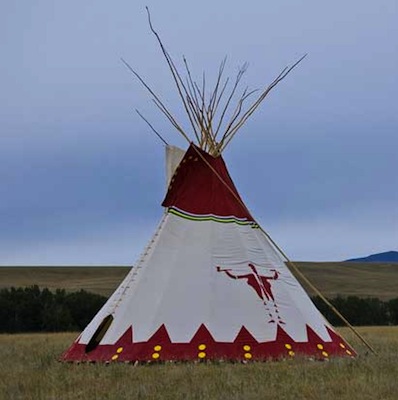 |  |
|---|
| TIPI (many Great Plains tribes) | WIGWAM (many Eastern Woodlands tribes) |
|---|
 Wounded Knee (Part 5 of PBS series We Shall Remain [YouTube]) Wounded Knee (Part 5 of PBS series We Shall Remain [YouTube]) |
|---|
Wounded Knee. Dir. Stanley Nelson. Part 5 of We Shall Remain. American Experience/WGBH International, 2009. DVD. The section shown before class was 31:50-39:25; during class (the boarding school flashback): 39:02-45:27. |
 TH, Feb. 17th:: TH, Feb. 17th::
| * "Impressions of an Indian Childhood" [1900]--continued (AIS 25-45) |
|---|
| | IV. "The Coffee-Making" (25-29) | | | | —two separate tales again, of the poor "haunted" fellow (25-26) and Za-S's untoward attempt at hospitality (27-29) | | | | —Z-Ša's fear of the "crazy man," Wiyaka-Napbina [Lakota: wiyaka (WEE-yah-khah) = feather(s); wanap'in (wah-NAH-p'ee[n]) = necklace)], whom her mother says really should be pitied, having been "overtaken by a malicious spirit" (25-26) | | | | —Z-Ša's coffee-making = "muddy warm water" for the visiting old man (27-29)—and the others' polite respect for her efforts, nonetheless: "But neither she [her mother] nor the warrior, whom the law of our custom had compelled to partake of my insipid hospitality, said anything to embarrass me" (28). | | | | —NOTE: "How!" (28) now more commonly (and less confusingly) spelled "Hau!"—Lakota/Dakota word of both greeting ("hello") and assent ("you betcha"). | | | V. "The Dead Man's Plum Bush" (30-33) | | | | —Name note: "Wambdi" (30) = Lakota wanbli (wah[n]BLEE): eagle | | | | —"Chaperon" custom for young women (31) | | | | —Z-Ša & mother on their way to a communal feast—characteristically stopping on their way to give food to a sick old woman (31-32); her mother's story of the plum bush whose "roots are wrapped around an Indian's skeleton, and Z-Ša's attempts to hear the "strange whistle of departed spirits" (32-33). [Hmmm: but later, Z-Ša will NOT listen to her mother's warnings about ANOTHER "forbidden fruit" (32)!] | | | VI. "The Ground Squirrel" (34-38) | | | | —Character description of aunt, who's more jovial than her mother (34-35) | | | | —Z-Ša's daily "sharing" of corn with the ground squirrel, that "little stranger": "I wanted very much to catch him and rub his pretty fur back" (36)! | | | | —Strange(?) comment that she has "few memories of winter days" from her SoDak childhood; recounts her confusion of river ice with the missionaries' marbles (37). . . . | | | | —word choice again: "many a moon" (38; see also 74)!? | | | VII. "The Big Red Apples" (39-45) | | | | —Apples as the (Biblical) "forbidden fruit"—the "temptation of assimilation" (D&N xxx) (Also, "apple" = Indian slang for someone "red on the outside but white on the inside.") | | | | —The "paleface missionaries": "come to take away Indian boys and girls to the East"—mother agin' it! . . . Z-Ša hears promises of "a more beautiful country," a "Wonderland" (39, 40). [= Oz!?—"You won't be in Kansas—er, SoDak—anymore!"] | | | | —Dawée having already studied there, even Z-Ša's mother has become a bit assimilated, now living like "a foreigner, in a home of clumsy logs" (40). | | | | —But mother's WARNINGs: beware the "'white man's lies. Don't believe a word they say. Their words are sweet, but . . . their deeds are bitter. . . . Stay with me, my little one!'" (41). | | | | —Notice Z-Ša's "retrospective" statement: "Alas! They came, they saw, they conquered" (41)—which not only is pregnant with the pain of her future experiences back East, but expresses her later assimilation in her very use of a quot. from Western Civ. (Julius Caesar's veni, vidi, vici). | | | | —word choice: "iron horse" (42; etc.) | | | | —Judéwin's details regarding the "red, red apples" (41-42) | | | | —1st inkling of the eventual "theme" of disobedience (cf. Genesis!): "so unwilling to give up my desire that I refused to hearken to my mother's voice" (43). | | | | —Finally, her mother's grudging assent—and her pessimistic reason: "'She will need an education when she is grown, for then there will be fewer real Dakotas, and many more palefaces.'" Her hope for justice?: "'The palefaces, who owe us a large debt for stolen lands, have begun to pay a tardy justice in offering some education to our children.'" BUT: "'I know my daughter must suffer keenly in this experiment'" (44). | | | | —Oh!—any symbolism here, as Z-Ša leaves for the East?!: "I saw the lonely figure of my mother vanish in the distance" (44). | | | | —Z-Ša's immediate (and premonitory?) "regret": "I felt suddenly weak. . . . I was in the hands of strangers whom my mother did not fully trust. I no longer felt free to be myself, or to voice my own feelings." And a final "animal" simile (and the "wild"): "I was as frightened and bewildered as the captured young of a wild creature" (45). |
| * "The School Days of an Indian Girl" [1900] (AIS 47-80) |
|---|
| | I: "The Land of the Big Red Apples" (47-51) | | | | —The "journey to the Red Apple Country"—on the "iron horse" (47)—it all sounds so "mythic"! | | | | —The white man's/colonizer's gaze ("glassy blue eyes" [47])—& the women's, and children's—upon our young Dakotas, to Z-Ša's embarrassment, even humiliation (47-48) | | | | —Humorous crack about the "low moaning" of the telegraph pole: "I used to wonder what the paleface had done to hurt it" (48; an innocuous aside that may have deeper resonances, given the later motif of the "machines" of Western Civ.). | | | | —Arrival at the school per se (White's Manual Institute, in Indiana)—to (the image/motif of) LIGHTS & whiteness: "lights"; "brightness"; "strong glaring light"; (even the) "whitewashed room" (49) and "white table" (50) | | | | —Caught and tossed in the air by the "rosy-cheeked paleface woman," Z-Ša "frightened and insulted": "My mother had never made a plaything of her wee daughter" (50). [Word choice: note "wee" as synonym for "little," another common self-reference motif.] | | | | —And so, like Babe the movie pig: "I want my mom!" [er, "mother!"]—and sobbing herself to sleep, with the phrase "wonderful land of rosy skies" sounding a little less glorious now. . . . | | | II. "The Cutting of My Long Hair" (52-56) | | | | —Initial setting = mood: "bitter-cold," "bare" trees, the "constant clash of harsh noises" (52; say that last phrase aloud!) | | | | —morning breakfast & prayer (52-54) = "eating by formula" (54) | | | | —Judéwin warns her of the hair-cutting to come; and "when Judéwin said, 'We have to submit, because they are strong,' I rebelled" (54). . . . so runs and hides, under a bed, in a "dark corner" (55) | | | | —Note the cultural differences, here ignored by the educators: shorn hair, among the Dakota, "only [for] unskilled warriors who were captured" and for "mourners" (54). [Ironically, she is in mourning, isn't she!?] | | | | —Found and "dragged out . . . kicking and scratching" (55)—and her hair finally cut: "Then I lost my spirit" (like Samson?!); oh, the indignity: "now I was only one of many little animals driven by a herder" (56; see buffalo comparison [10]; see also 45). | | | III. "The Snow Episode" (57-61) | | | | —Making body patterns in the snow forbidden (why?!); but the three Dakotas forget, and disobey (57). | | | | —Judéwin's ill-fated language lesson: just say "No"—which they practice on their way to questioning (57). . . . Oops, bad idea, for Thowin, anyway, who unknowingly answers "no" to the wrong questions—and a spanking (58-59). | | | | —Language/cultural barrier: "[M]isunderstandings as ridiculous as this . . . frequently took place, bringing unjustifiable frights and punishments into our little lives" (59). | | | | —Z-Ša's (first act of) REVENGE: the turnip (over-)mashing episode (59-61): "I felt triumphant in my revenge . . . . I whooped in my heart for having once asserted the rebellion within me" (60, 61). [Word choice: not the first time whoop has appeared; why use such a racially loaded term?!] | | | IV. "The Devil" (62-64) | | | | —The novelty of Christian dualism (God vs. Satan): "I never knew there was an insolent chieftain among the bad spirits"—the picture of which she is shown ("the white man's devil") (62). | | | | —And the threat: "this terrible creature roamed loose in the world" to torture "little girls who disobeyed school regulations" (67-68)! | | | | —DREAM of the devil and her mother (63-64): (humorous aside?:) "he did not know the Indian langauge [sic: typo]" (63) . . . . How do you "interpret" the dream's ending?: just as the devil was about to attack her, "my mother awoke from her quiet indifference, and lifted me on her lap. Whereupon the devil vanished, and I was awake" (64). | | | | —Another revenge—now, on the devil: in a book called The Stories of the Bible, "I began by scratching out his wicked eyes" (64). [Hmmm: remember other "eyes" in this narrative?] | | | V. "Iron Routine" (65-68) [aka Pink Floyd's "Welcome to the Machine"!?] | | | | —The title establishes an imagistic motif that "clangs" its way through this chapter of a "paleface day" of machine-like regimentation: the "loud-clamoring bell" (65; see also the "loud metallic voice" of the bell on p. 52); the pencil ticks of roll call: "It was next to impossible to leave the iron routine after the civilizing machine had once begun its day's buzzing" (66). | | | | —"Tamed ANIMAL": And so "I have many times trudged in the day's harness heavy-footed, like a dumb sick brute" (66). | | | | —Critique of medical care (another "mechanical" activity) (66-67): "Once I lost a dear classmate"; crying at the deathbed, seeing the open Bible: "I grew bitter. . . . I despised the pencils that moved automatically, and the one teaspoon . . . dealt out . . . to a row of various ailing Indian children" (67; recall Levchuk's essay on Indian boarding schools). | | | | —Her anger strikes out even against Christian indoctrination, "inculcating in our hearts . . . superstitious ideas" (67; woh!). | | | | —The "machine" continues: "I was again actively testing the chains which tightly bound my individuality like a mummy for burial" (67; see narrative's end [p. 99], where she wonders if such an education is really "life" or "death"). | | | | —Concluding retrospective on this trauma—and the (curious) final figure of speech: "The melancholy of those black days has left so long a shadow that it darkens the path of the years that have since gone by. . . . Perhaps my Indian nature is the moaning wind which stirs them now for their present record. But, however tempestuous this is within me, it comes out as the low voice of a curiously colored seashell, which is only for those ears that are bent with compassion to hear it" (67-68). Why does her angry "tempest" become the "low voice" of a "seashell"? Enforced suppression? Conscious audience consideration? A fondness for "purple-prose" images of nature & the exotic? | | | VI. "Four Strange Summers" (69-74) | | | | —Return home after three years back East—not many details for "four strange summers" back in SoDak/among her people?!—to the "heart of chaos," and an "uneducated" mother who cannot understand her. . . . (69) | | | | —In sum, ALIENATION, from her mother, her tribal heritage, and "Nature" itself: "Even nature seemed to have no place for me. I was neither a wee girl nor a tall one; neither a wild Indian nor a tame one" (69). | | | | —Buckboard joyride episode (70-72), and her re-appreciation of the vastness & beauty of the Great Plains: "Within this vast wigwam[!?] of blue and green I rode reckless and insignificant" (70-71); impulsively chases coyote (71). . . . | | | | —Dawée won't take her to the party, of "jolly young people"—Dakotas, all, who "had become civilized"; and Z-Ša, too, as she complains about not being "properly[!] dressed" (72-73)? | | | | —Mother consoles her—with "the white man's papers" (Bible)!; but she greets even this, now, with "rejection" (73; not TOO spoiled, eh?). | | | | —Then perhaps the most pathetic part of the narrative: her "mother's voice wailing" outside, and—"I realized . . . she was grieving for me" (74). WHY? | | | | —Now, "schemes of running away" from the Rez—oh, the irony!; the "turmoil" felt at home "drove me away to the eastern school" (74)! | | | VII. "Incurring My Mother's Displeasure" (75-80) | | | | —But some traditionalism still evident: from a medicine man, she brings "a tiny bunch of magic roots" with her, a charm to get friends; "Then, before I lost my faith in the dead roots, I lost" them (the roots) (75). | | | | —High school diploma earned, she moves on to Earlham College (Indiana) "against my mother's will" (75). . . . Versus her mother's hints that "I had better give up my slow attempt to learn the white man's ways, and be content to roam over the prairies and find my living upon wild roots" (75-76). [Not good enough for yu', now!?] | | | | —So, "homeless and heavy-hearted," back to school to—(more) racism: "among a cold race whose hearts were frozen hard with prejudice" (76). | | | | —Remember the Chrystos poem in which survival = making "pretty things"? Z-Ša, too, tries spinning "reeds and thistles," "the magic design of which promised me the white man's respect" (76). | | | | —ORATORY (76-80): 1st place at Earlham, to the overt praise of her fellow students (77-78); then the state (of Indiana) contest (78-80), where she experiences "a strong prejudice against my people" (78), evidenced in shouted "slurs against the Indian" and the flag "with a drawing of a most forlorn Indian girl"—and the word "'squaw'" (79). | | | | —Oh, the "barbarian rudeness" (79): note how Z-Ša, the author, reinscribes ("reinvents"!?) the word's original intent, as denotative of those who are not part of (Western) "civilization." Here the "civilized" are the barbarians, at last. | | | | —(Oh—she wins 2nd place.) | | | | —Another fit of vengeful thoughts upon winning her prize ("the evil spirit . . . within me") (79-80) . . . but back alone in her room, thoughts of home—and guilt: "In my mind I saw my mother far away on the Western plains, and she was holding a charge against me" (80). |
 RESPONSE #2—Due TUES., 2/22 (uploaded to Canvas by midnight)—CHOOSE ONE (2 or more pages): RESPONSE #2—Due TUES., 2/22 (uploaded to Canvas by midnight)—CHOOSE ONE (2 or more pages):
—Don't worry about MLA formatting, headers, etc.; but do indicate which option you're doing, please.
a) As mentioned on the syllabus, one option is to turn in a do-your-own-thing "READER'S JOURNAL" that addresses a "goodly" range of the readings (that is, from Newcombe: "500 Years of Injustice" to Alexie's "Indian Education" [see below for full range]). (These should ideally be responses you wrote immediately after reading, so there's no danger of simply rehashing class ideas.)
b) Write your own evaluative "book review" of Z-Sha's 3-part boarding-school narrative (7-99). How well does she navigate the "caught between two worlds" dilemma spelled out on my intro PDF? (Alternative: write the review from the point of view of a well-intentioned [or not] east-coast Euro-American, circa 1901?!)
c) Alexie's "Indian Education" is a humorous 1990s short story written well after the heyday of boarding schools, land allotments, "Indian wars," and the like. Relate Alexie's story to at least TWO of our non-fiction/non-poem readings (from this range of readings), showing that the "historical trauma" of the Native experience is still evident in this humorous tale.
d) Rhetoric & TONE: obviously, there is a wide range of "tonal" choices available to the (Native or not) author writing about Native history and issues: discuss at least two of the authors (from this range of readings) in terms of their relative success in this regard. For example, "X's rehtorical choices are well done [and convincing, and/or moving], while Y's are an abject (& alienating) failure!"
e) Free (but focused) Response: develop your own topic-choice as a focused response on our historical/boarding school readings, dealing with at least three of the readings since Response #1 (that is, from Newcombe on; Z-Sha's 3-part memoir counts as only ONE text!).
f) [New/2022:] Compare and contrast the two boarding school narratives by Z-Sha (in American Indian Stories) and Standing Bear ("First Days at Carlisle"). You might consider tone, audience, etc., and of course the experiences themselves.
—Note: For all responses, please include p#'s in parentheses for any specific references to our texts. Also, please avoid simply rehashing ideas brought up in class or in my online outlines. Feel free to object to/expand upon these, of course, but above all, try to do "something else" that still demonstrates that you've done the reading.
—Note: The full range of texts for Response #2 is as follows: Newcombe: "500 Years of Injustice"; Wilkins: "A History of Federal Indian Policy"; Gonzales: "The Black Hills"; Eastman: "The Ghost Dance War"; Cook-Lynn: "New Indians, Old Wars"; Joy Harjo: "I Give You Back"; Louis: "Red Blues in a White Town the Day We Bomb Iraqi Women and Children" Zitkala-Sha: her 3-part autobiography (7-99; count as one text!), "America's Indian Problem" (185-195); Standing Bear: "First Days at Carlisle"; Devens: "'If We Get the Girls, We Get the Race'"; Giago: "Reservation Schools Fail"; Alexie: "Indian Education."
|
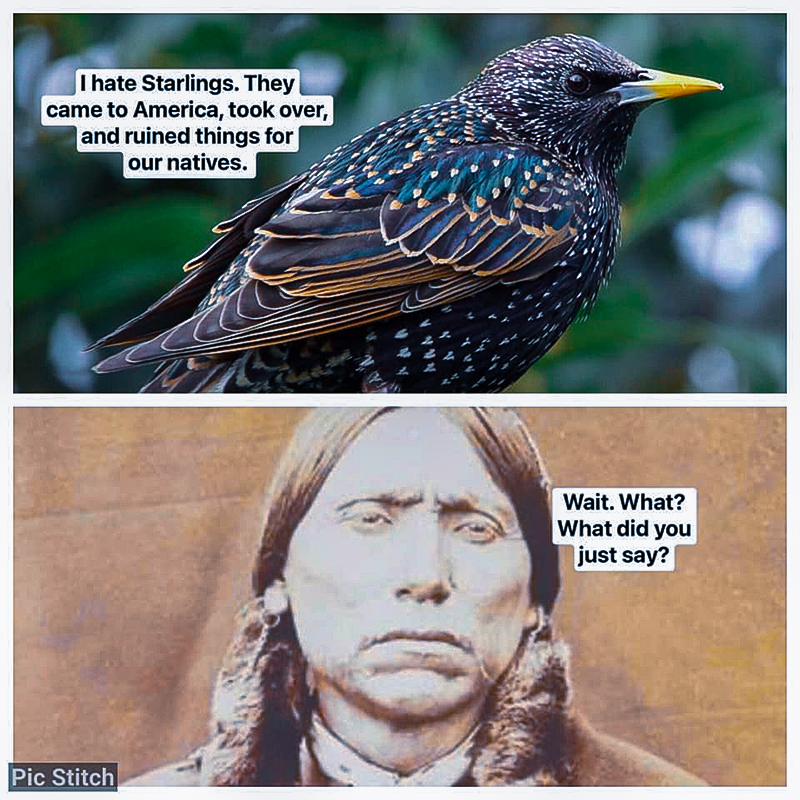 |
|---|
| —Found on Facebook today (2/19/22). The difference is that starlings didn't have a choice; they were imported by a Shakespeare aficionado, who wanted every bird mentioned by the Bard to have a presence in the "New World."(Of course, one might well argue that poor Euro-human immigrants didn't have much of a choice, either.) |
 XIT: "Reservation of Education" (YouTube) XIT: "Reservation of Education" (YouTube) |
|---|
| —XIT was a Diné band of the 1970's, whose often "radical" lyrics made them a favorite of AIMsters (and like-minded college undergraduates like me!) |
 TU, Feb. 22nd:: TU, Feb. 22nd::
| "An Indian Teacher Among Indians" [1900] (AIS 81-99) |
|---|
| | I. "My First Day" (81-84) | | | | —Though ill, Z-Ša refuses to go home, out of "pride," and the knowledge/guilt that her mother would say that "the white man's paper's were not worth the freedom and health I had lost by them" (81). | | | | —So further East ("toward the morning horizon" [81])—to Carlisle. . . . | | | | —Meets her "boss" (Richard Henry Pratt), who has heard of her oratory skills, but seems disappointed in her person ("a subtle note of disappointment" [83])—Why? | | | | —Ah: besides her physical illness, she's not a happy camper, with the "lines of pain on" her face, and a "leaden weakness" from "years of weariness" (84). | | | II. "A Trip Westward" (85-92) | | | | —Again, having ignored "nature's warnings," she's stuck in an "unhappy silence" (85). [This detachment from Nature will become a "theme."] | | | | —So(?) her employer's plan to turn her "loose to pasture," to send her back West—for more recruits (85)! | | | | —the home ENVIRONMENT again: the "vast prairie" whose clouds and grass "thrilled me like the meeting of old friends" (86) . . . | | | | —the white DRIVER, and Z-Ša's classist/elitist attitude towards him!?: his "unkempt flaxen hair," "weather-stained clothes," and "warped shoulders" (87) | | | | —Her mother's initial reluctance to run to greet Z-Ša issues from a mistaken assumption about the white fellow (88-89)—what is it? . . . Z-Ša clears things up: "'He is [just] a driver!" (89). | | | | —Z-Ša's mother's own assimilationist "compromises": e.g., her log cabin now has curtains (89)! | | | | —But to Z-Ša's suggestions that she make improvements(!), she tells of her extreme poverty, due to Dawée's loss of his job (90); we learn, in fact, that Dawée's been replaced by a white employee, and—irony—can no longer "'make use of the education the Eastern school has given him'" (90-91); and the reason for being fired?—speaking out, making trouble, trying "to secure justice for our tribe in a small matter"—oh, the "'folly'" (91)! | | | | —Z-Ša grows bitter at the news: to her mother's praying, she says, "'don't pray again! The Great Spirit does not care if we live or die! Let us not look for good or justice: then we shall not be disappointed!'" (92). [On one level, the Lakota/Dakota wakan tanka really doesn't "care"! But on another level, I suspect, Z-Ša is rebelling, at the moment, against some Christian/Native hybrid deity she has recently come to believe in, arriving here at a version of Stoic philosophy.] | | | | —"Taku Iyotan Wasaka" (92): taku (TAHkhoo) = something; iyotan (eeYOHtah[n]) = very, most; was[h]'aka (wash'AHkah) = strong | | | III. "My Mother's Curse Upon White Settlers" (93-94) | | | | —Z-Ša's mother complains of the "shrinking limits" of Yankton lands, because of a "whole tribe of broad-footed white beggars" whose lights she points out to her daughter (93); and so another warning: "'beware of the paleface,'" who "'offers in one palm the holy papers, and with the other gives a holy baptism of firewater'" (93-94)—[Vine Deloria never expressed it better!?]—who is "'the hypocrite who reads with one eye, "Thou shalt not kill," and with the other gloats upon the sufferings of the Indian race'" (94). [See the fate of the "The Soft-Hearted Sioux" for a similar irony.] | | | | —The mother's final gesture of a "curse," with "doubled fist" (94): rather too melodramatic, en'uh? | | | IV. "Retrospection" (95-99) | | | | —Z-Ša's final, earnest critique of Indian boarding schools; incl. her "indignation" about unqualified teachers—the "opium-eater," and the "inebriate" doctor who "sat stupid" while Indian students "carried their ailments to untimely graves" (95); the government inspection procedure, too, is inept; so at last, she concludes, "I was ready to curse men of small capacity for being the dwarfs their God had made them" (96)—what does she mean by this?! | | | | —Alienation/detachment from "Nature" encore—and traditional religion (and mother): "For the white man's papers I had given up my faith in the Great Spirit. For these same papers I had forgotten the healing in trees and brooks. On account of my mother's simple[?!] view of life, and my lack of any, I gave her up, also" (97). | | | | —Alienation continued—via remarkable TREE metaphor: "Like a slender tree, I had been uprooted from my mother, nature, and God. I was shorn of my branches. . . . Now a cold bare pole I seemed to be, planted in a strange earth. Still, I seemed to hope a day would come when . . . [I] would flash a zigzag lightning across the heavens" (97). Did this hope come true? | | | | —So—a "new idea": retirement from teaching (97-98); and the retrospective in earnest, thinking back on the "many specimens of civilized peoples," of "Christian palefaces" who were pleasantly surprised to see "the children of savage warriors so docile and industrious" (98; note, too, the emphasis on their "gazing"). | | | | —But finally, is this assimilationist education a good thing?—a question, she laments in the final sentence, that too few have pondered: "few there are who have paused to question whether real or long-lasting death lies beneath this semblance of civilization" (99). |
| "America's Indian Problem" [p. 1921, in The Edict] (AIS 185-195) |
|---|
| | —Z-Ša's well-chosen introductory examples: | | | | 1. The Jamestown Colony, and Captain Newport's erection of a "'cross as a sign of English dominion'"; and then his lie to Powhatan that the cross's "arms . . . represented Powhatan and himself, and the middle [of the cross] their united league" (185)! | | | | 2. DeSoto's forces stealing pearls from ancestral Native tombs [S. Carolina]—DeSoto says, "'to make rosaries of'"!; Z-Ša's source's hilarious commentary: "'We imagine if their prayers were in proportion to their sins they must have spent the most of their time at their devotions'" (186)! | | | —Z-Ša's conclusion (& complaint): "It was in this fashion that the old world snatched away the fee in the land of the new" (185). . . . Again she re-defines/inverts "barbarism" in the colonizers' "barbaric rule of might" (186). | | | —Appeal for Indian CITIZENSHIP/the VOTE: Natives, in contrast, are now but "legal victims," and "wards" instead of "citizens." . . . A CALL to ACTION—with the aid, you should note, of early-20th-c. feminist activism: "Now the time is at hand when the American Indian shall have his day in court through the help of the women of America" (186). . . . "Wardship is no substitute for American citizenship, therefore we seek his enfranchisement" (187). | | | —Point of View!?—who is the We in the bottom paragraph of 186?: "We serve both our government and a voiceless people . . . . We would open the door of American opportunity to the red man . . . " (186). . . . Then another PofV switch: "Do you know what your Bureau of Indian Affairs . . . really is?" (187)—NOW who's the you? | | | —The concluding lengthy quot., then, from the Bureau of Municipal Research report (1915): [This "story of the mismanagement of Indian Affairs" (193) reads like a nightmare from Kafka!] | | | | —"Prefatory Note" (188): while we spent a lot o' time on this report, it "is not available for distribution"! | | | | —"Unpublished Digest . . ." (188-): there has been no official govt. "digest of the provisions of statutes and treaties with Indian tribes governing Indian funds"—so we made one; but "it found its way into the pigeon-holes" of bureaucracy and remains "unpublished" (188-189). | | | | —"Unpublished Outline . . . (189-)": likewise, this "also found repose in a dark closet" (190)! | | | | —"Too Voluminous . . .[!]" (190): well, we coulda put a copy in the Library of Congress, "but the only official action taken was to order the materials be placed under lock and key in the Civil Service Commission"! | | | | —"Need for Special Care . . ." (190-)—because "in theory of law the Indian has not the rights of a citizen. He has not even the rights of a foreign resident. The Indian individually does not have access to the courts"; as a "ward" of the federal government, his "property and funds are held in trust" (191). [Note: besides Indian citizenship (1924), such government misgovernment led to the Indian Reorganization Act of 1934.] | | | | —"Conditions Adverse to Good Administration" (191-)!: translation—conditions are BAD!; lots of administrative misdeeds (192 ["fraud, corruption" (193)]). | | | | —"Government Machinery . . ." (192-): and lots of misappropriation of funds out of greed (192) | | | | —"Ample Precedents" (194-): Conclusion—"All the machinery of the government has been set to work to repress rather than to provide adequate means for justly dealing with a large population which has no political rights" (195). |
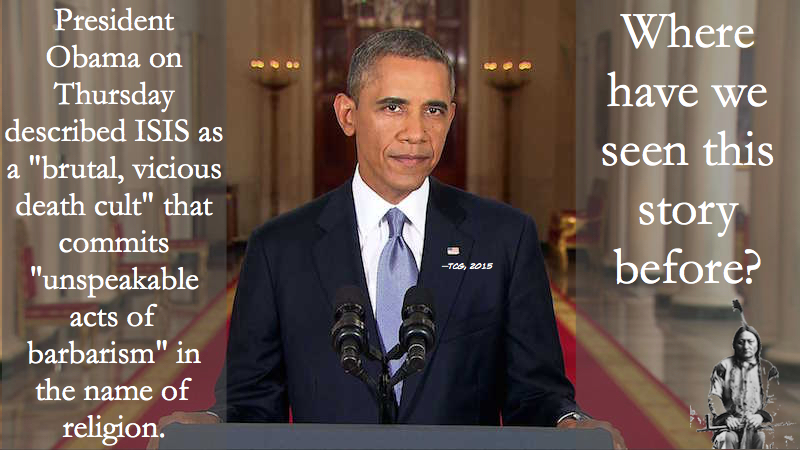 |
|---|
| At several points in her narrative, Zitkala-Ša reverses this civilization/barbarism binary. I also recall Silko claiming that both U.S. political parties play the "race card" ("The Border Patrol State" 121)—and here, the "primitivist" card. (Especially ironic when a POC does it.) Of course, the point above is how much (and how easily) the U.S. projects its own behaviors upon others. |
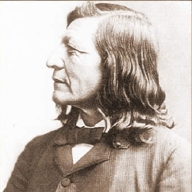 | Standing Bear: "First Days at Carlisle" (from My People, the Sioux [1928]) (Trout 598-610) |
|---|
| | ** Crucial (and usually sadly hilarious) passages: | | | | -*-Inception of the School: par. 7-9 | | | | -*-NAMING: 18-22 | | | | -*-WRITING: 23-25 | | | | -*-Clothes/Hair: 33-53 | | | | -*-Religion/Church: 55, 62-63 | | | | -*-Plate-painting: 60 (worth some $ now!?) | | | | -*-"Occupational therapy"—(and irony of trade as) tinsmith: 65-66 | | | | -*-(hilarious) Brass band episode: 68-71 |
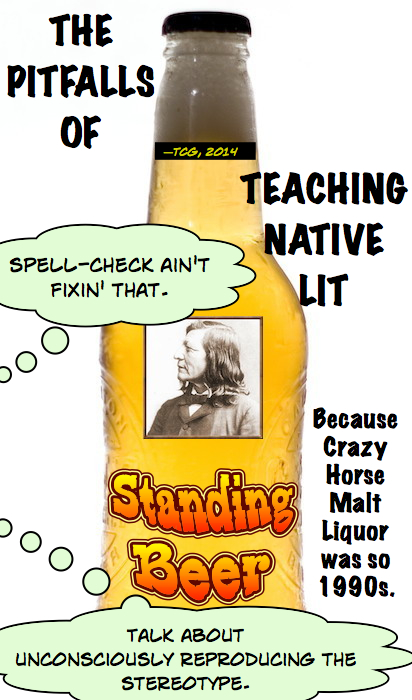 |
|---|
—my response to an old student paper that
misspelled "Standing Bear" throughout |
 Devens: "'If We Get the Girls, We Get the Race': Missionary Education of Native American Girls" (NAV 284-290) Devens: "'If We Get the Girls, We Get the Race': Missionary Education of Native American Girls" (NAV 284-290) |
|---|
| | • Note that the epigraph quot. (284) is from—a book and author we just read! For more Z-Sha, see 284A-B, 285B, 286B-287A, 287B-288A, 288B, 289A, 289B, 290B. Indeed, Z-Sha's autobiography seems to be Devens' main source, even though assuming that her retrospective memories of her childhood days are the gospel truth seems quite suspect, as I suggested in our class discussions. | | | • History speak with forked tongue!: "The history of mission schools is a troubling one in which stories of benevolent, self-sacrificing missionaries contend with accounts of relentlessly rigid discipline, ethnocentrism [often a euphemism for racism], and desperately unhappy children" (284B). | | | • 19th-c. missionaries "firmly believed in the linear progression of history and in their own elevated place on the ladder of civilization"—above all because they were Christians: "'We cannot be too grateful that God did not make us heathens'" (285A)! (Which begs the question: why DID a Christian God even make heathens?! Ah: to give good Christians something to do!?) | | | • Colonialist Psychology 101: "School, missionaries hoped, was a way to change Indians from 'others' into dusky versions of themselves" (285A). . . . Later: "By regarding their students simply as children rather than as Indian children, teachers essentially denied their very identities" (288B). | | | • Devens' essay title is from the words of a missionary: "'The girls will need the training more than the boys & they will wield a greater influence in the future. If we get the girls, we get the race'" (285B). | | | • However, against expectations, "'the men . . . have made far greater progress & have yielded more readily to civilizing forces than the women have'" (286A). Why this difficulty in getting Indian girls to go to the schools?: well, one "perceptive missionary . . . suggested that close ties between mothers and daughters were to blame—that women who maintained a traditional way of life were loath to relinquish control of their daughters' upbringing" (286B). | | | • "A young [Native] girl . . . was presented with an alien world view, behavior code, and language to which she was quickly expected to adhere. It was a confusing and frightening whirlwind of strangers, journeys, haircuts, and loneliness" (286B; of course, Z-Sha is immediately quoted for example). | | | • As for HAIRCUTS: one "Indian agent . . . reported that when new Lakota students at Pine Ridge reservation caught a glimpse of teachers giving haircuts, they feared that he intended to disgrace them, and all fled in alarm" (287A). | | | • Surprise: even the boarding-school textbooks "unabashedly proclaimed the Anglo-American vision of progress and morality subscribed to by the missionaries" (287A). | | | • According to Mary Crow Dog [in her fascinating memoir Lakota Woman]: "'It is almost impossible to explain to a sympathetic white person what a typical old Indian boarding school was like; how it affected the Indian child suddenly dumped into it like a small creature from another world, helpless, defenseless, bewildered, trying desperately and instinctively to survive at all.' Some young girls at the school killed themselves or attempted suicide to escape an unhappy situation beyond their control" (288A). | | | • Remember Standing Bear's useless tinsmith skills?: "The demoralizing effect of school programs was often rivaled by their futility. Most of the domestic instruction that girls received was virtually useless when their schooling ended and they returned to the village or reservation" (288A). | | | • As intimated in our Z-Sha reading: "In fact, schooling often did end in death . . . especially for children at boarding schools, where infectious diseases took a high toll" (288B). | | | • Helluva sentence: "Overworked, ill, and ethnocentric teachers were no substitute for the female network [back home] on which a girl's emotional, spiritual, and intellectual development depended" (288B). | | | • One missionary's attitude towards his Native students: "'Most of them have superior minds by nature but they are minds in ruins'"; moreover, his students were "'ragged, dirty, lousy and disgusting little objects'" (288B; woh! ). | | | • Another cultural difference in child-rearing methods: "Mission teachers . . . often were quite free with corporal punishment. Because such punishment was an accepted, even required, part of their own culture, beatings and other methods were frequently used" (289A; recall the "just say no" episode in Z-Sha). | | | • More cultural suppression: "it was difficult if not impossible for a girl at day or boarding school to engage in vision fasts or [ritual] menstrual seclusion, both for practical reasons of time and distance from women relatives and because of the missionaries' opposition to such practices" (290A). | | | • Summary statement: "Although missionaries were not overwhelmingly successful in achieving their goal of shaping a new generation of assimilated citizens, their programs did have a long-term and often devastating impact both on girls and on the daughter-mother-grandmother relationship" (290B). |
 TH, Feb. 24th:: TH, Feb. 24th::
 Tim Giago: "Reservation Schools Fail to Assimilate All Students" (NAV 291) Tim Giago: "Reservation Schools Fail to Assimilate All Students" (NAV 291) |
|---|
| | • The boarding school assimilationist policy has "failed for many reasons"—not the least of which is that, even with such an education, there is "no future" for a lot of reservation kids (291A). Again, recall Standing Bear's useless tinsmith skills. Well, today there are "more unemployed 'welders' and 'iron workers' on Indian reservations than anywhere else in the United States" (291B)! | | | • Great summary sentence regarding the boarding school system: "By including the destruction of a culture into the educational process using a hit-and-run approach, the Indian child became a human guinea pig and, therefore, fair game for every well-intentioned do-gooder and despot willing to give it a try" (291A). | | | • NEWs to me: not until the Indian Education and Self-Determination Act of 1975 were Native parents allowed to formally participate in their kids' education, via PTAs, school boards, etc. (291A)! | | | • The "Indian mission school on the Pine Ridge Reservation" (291B) can only be the one that I also attended, Holy Rosary Mission (now called Red Cloud Indian School). |
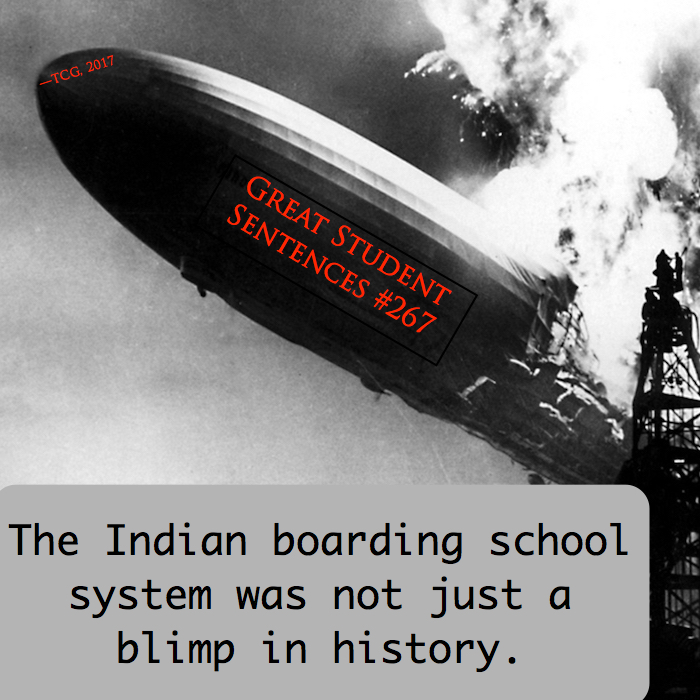 |
|---|
| —Relax—it wasn't from this class! |
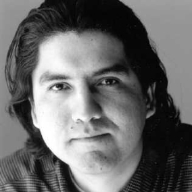 | Sherman Alexie: "Indian Education" (The Lone Ranger and Tonto Fistfight in Heaven 171-180) |
|---|
| | —One of my favorite stories, this one told from the point of view of Junior Polatkin, Alexie's persona in the book (The Lone Ranger & Tonto Fistfight in Heaven) who got his H.S. diploma, who had a chance to get ahead via his education, and who experienced more of urban life first-hand. . . . | | | —NOTE on the chant, "'It's a good day to die, it's a good day to die'" (172): another Crazy Horse connection (one of Alexie's obsessions?!). Tradition says that these were his words at the Little Bighorn—although it was a standard formulaic expression among Lakota warriors of the day. | | | —SECOND GRADE section (172-173) is a painful representation of one white woman's racial & cultural bigotry, especially her "'Tell me you're sorry.'"—for what?—for "'Everything'" (172)! . . . In the same section [(old) student question:], "Why does Alexie play with the capitalization of 'Indian' (173)?" (Notice who is speaking, in the different uses of "indian" vs. "Indian.") | | | —[Great (old) student question:] "What does Junior mean when he says, at the end of the THIRD GRADE, 'I am still waiting' (174)?" | | | —TENTH GRADE section (178): Why do even the best&brightest from the Rez often fail? (Speaking from own feelings of "half-breed" inferiority and feelings of failure from low self-esteem as a kid,) could it be because of the realizations Junior has in this section? E.g.: "we look in the mirror, see the history of the entire tribe in our eyes, taste failure in the tap water, and shake with old tears . . . . Believe me, everything looks like a noose if you stare at it long enough." | | | —TWELFTH GRADE: By now, sadly, Indians learn how to "play" their expected roles, as Junior tries "to remain stoic" as he poses for his valedictorian photo (179), and his fellow Native graduates on the Rez also pose—"as they look back to tradition" (180). Final question: is it a true binary/opposition, between assimilated success and rez failure? |
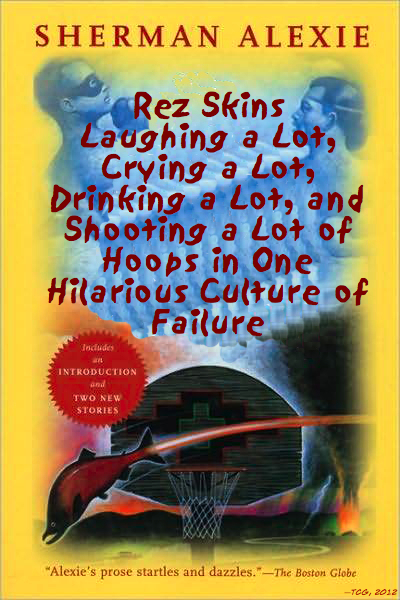 |
|---|
| My satire on the famous book cover of Alexie's first short story collection (The Lone Ranger & Tonto Fistfight in Heaven, which includes "Indian Education"); indeed, Alexie has come under fire for his pessimistic portrayal of rez life as nothing but laughing, drinking, "Indian tears," and failure. |
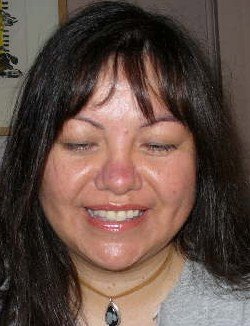
Tiffany Midge: "Mount Rushmore & the Arm of Crazy Horse"(from Outlaws, Renegades and Saints, 1996) |
|---|
| | | —Thematic contrasts: "sacred hills," "god," "warrior's / arm," "simpler / truth"—vs. "stone white faces," "white colonial freedom fighter," "amway-loving friends" | | | —Juxtaposed to the "stone-white faces" of Mount Rushmore—and the "colonial freedom fighter" and the narrator's "amway-loving friends"—is the "simpler truth" (and irony) of the still-in-progress Crazy Horse Monument (also in the Black Hills): and that final stunning image of "just an arm . . . pointed toward / battle. Just an unfinished tribute to an unfinished war." (No further commentary necessary?!) |
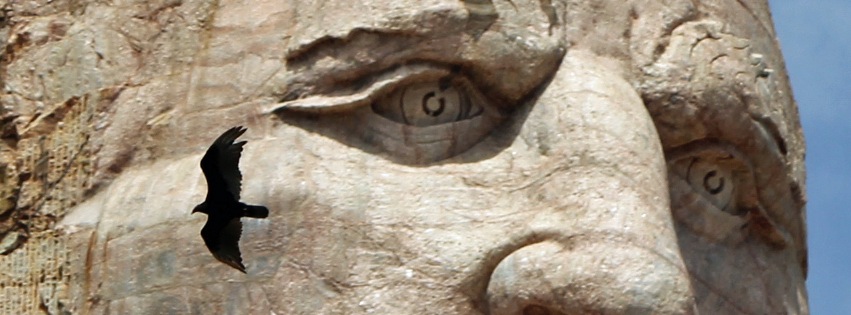 |
|---|
| —my photo: Turkey Vulture at Crazy Horse Monument, 2011 (no symbolism there!?) |
 TU, March 1st:: TU, March 1st::

Vine Deloria, Jr.: "A Simple Question of Humanity: The Moral Dimensions of the Reburial Issue"(For This Land 187-202) |
|---|
| | —controversy regarding the return of the remains (& burial offerings) of some "two million Indians" (187) | | | —N.B.: UNL one of the first enlightened "major institutions" regarding this issue (187-188) | | | —in contrast, for U.S. government agencies and anthropologists, such remains are a "resource" (188; see also 187 and thruout), bringing up the question . . . | | | —ARE INDIANS HUMAN?!— | | | | —example of children's reader with animal pictures, including an "Indian mother" & child; sports-team mascot names (189) | | | | —famous 1550 debate between Catholic clergymen Sepulveda (who divided humankind into the "civilized" and the "brute or barbarian") and Las Casas (whose more empathetic view included "cultural relativism") (189-190) . . . But Sepulveda carried the day, for the most part, and the "genocide" of Natives were henceforth continually "justified by appeals to Christianity and civilization" (190). | | | | —Sure: Nazi Germany's Holocaust, etc., were bad, but at last, Native Americans were the only people whose remains have been deemed official "property" (191). | | | —VD's fine argument on the mainstream "schizophrenic" attitude: either "Indian religions are a real tradition" whose culture that should be "valued," even learned from—ergo anthropologists' interest in the remains; or, "if Indian religions are not valuable," then they don't need the remains: return them, then! (And by the way, his argument runs, if the first choice is true, they should also be returned, since it admits that Native religious views, including the deep regard for the dead, are "valuable"!) (192) | | | **—VD's Swiftian "modest proposal": let's take scientific inquiry to its logical extreme and start "digging up the family graveyards of the first families of Savannah," etc.; "Exhumation" for all "racial, ethnic, and economic" groups (194-195)! . . . then, regarding burial artifacts, a comparably hilarious call to dig up Euro-Americans' prayer books, medallions, wedding rings, etc. (199)—for science, of course . . . "[S]cientists and museum directors," especially, should "volunteer the graves and bodies of their relatives," for the "dedication to science should start at home" (201-202)! | | | —U.S. officials' unfair demand that "Indians prove that their burial practices are central to their religious beliefs and practices" (196; see also 211)—why, again, the only group to be required to do so? . . . Indeed, it is secular & Christian America that has an "impersonal, callous" regard for the dead, and a repressive attitude towards all thoughts of death (197-198). | | | —finally, the obvious call to action: return of remains, "the cessation of exploitation of American Indian dead" (202) |
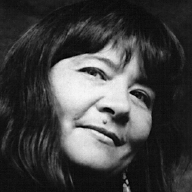 Leslie Marmon Silko: "The Border Patrol State" (Yellow Woman 115-123) Leslie Marmon Silko: "The Border Patrol State" (Yellow Woman 115-123) |
|---|
| | —Native Americans "patriotic," and "proud citizens" (115)—until the Border Patrol's new policies & tactics? | | | —main anecdote, of Silko and Gus, stopped at night on way to Tucson (116-118) | | | | —"'looking for trouble'" attitude of officers (116) | | | | —comparison to Argentina's "'dirty war'" (117)! | | | | **—dog (female German Shepherd)—who "hated" the officers and "would not serve them" (117); S. & the dog exchange "looks" (117-118); the dog "refuses to accuse" them, since "she had an innate dignity that did not permit her to serve the murderous impulses of those men. I can't forget the expression in the dog's eyes"; even though S. had "a small amount of medicinal marijuana," the dog "refused to expose" her (118) [Note how, as in the "Native ecofeminism" of Linda Hogan, Natives, women, and animals seem to have a natural alliance.] | | | —then "THESIS": "Since the 1980's, on top of greatly expanding border checkpoints, the Immigration and Naturalization Service and the Border Patrol have implemented policies that interfere with the rights of U.S. citizens to travel freely within our borders" (118) | | | —but this all-inclusive "we" is really largely limited to people of color, or whites who fit the "profile" of political radicalism; note, too, Silko's emphasis that much of the oppressed poor of Latin America are "Native American or mestizo [mixed-blood]" (119) | | | —more, 2nd-hand, examples of this injustice (120-121)—and the effective parallelism of the repeated "Never mind" (120) | | | —At last: "This is the police state that has developed in the Southwest United States since the 1980's." . . . stunning statistics regarding the denizens of South Tucson (121) | | | —"Manifest Destiny" has now become a closed-door immigration policy, with "'Immigration'" a political buzzword by which to scare the electorate (121) . . . unjustly, U.S. policy "has continually attempted to sever contact between the tribal people north of the border and those to the south" (121) | | | —irony of the "Iron-Curtain"-esque plans for a steel wall across the border with Mexico . . . but—"It's no use; borders haven't worked, and they won't work, not now, as the indigenous people of the Americas re-assert their kinship and solidarity with one another. A mass migration is already underway" (122-123). . . . that kinship a cultural one, with "shared cosmologies" that include—"Quetzalcoatl [KETzulKWAHTul], the benevolent snake" (123; aka the "plumed serpent," part snake, part bird) | | | —"Deep down . . . the so-called Indian Wars . . . have never really ended. . . . The Americas are Indian country, and the 'Indian problem' is not about to go away"; and, as if in fulfillment of her prophecy, the final anecdote of "dark young men" coming north; as the old Aztec story says, "they will return" (123). |
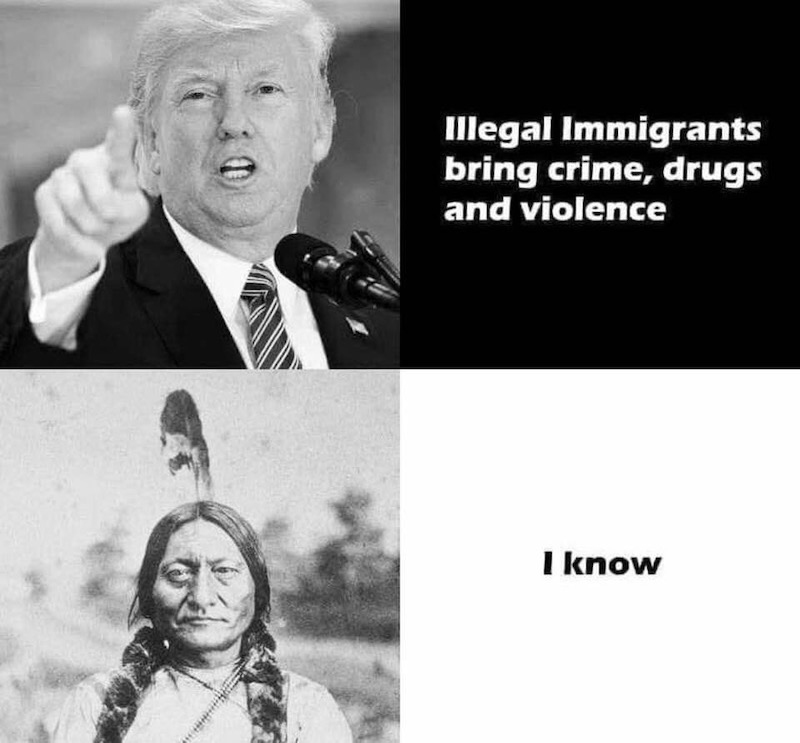 |
|---|
| —variation on a recurring social-media meme/theme, of course |
 Weaver: "Indigenous Identity" (NAV 28-35) Weaver: "Indigenous Identity" (NAV 28-35) |
|---|
| | • Weaver identifies "three facets of identity": "self-identification, community identification, and external identification"; she will also consider "how internalized oppression/colonization is related to identity" (28A). | | | • Identity, however, is both a social construct and intersectional: "Identities are always fragmented, multiply constructed, and intersected in a constantly changing, sometimes conflicting array" (28B). . . . "identities do not exist before they are constructed" (29A). . . . In fact, even "meaning is constructed through language" (29B) | | | • "The Big Game" is an allegory for the misapplication of questionable Native identity "standards"—e.g., facial hair, skin color, language, and tribal enrollment (29A-B). . . . Such bogus "issues of authenticity permeate the story 'The Big Game' as players try to exclude others from the competition. Indeed, identity is always based on power and exclusion. Someone must be excluded from a particular identity in order for it to be meaningful" (30B). . . . In sum: "Searching for the 'right' criteria is both counterproductive and damaging" (32B). | | | • Identity is not only constructed, but it is based upon "difference" (from other ethnicities, etc.): "Thus, there was no Native identity prior to contact with Europeans" (29A). | | | • Since language "shape[s] identity"—"Native people often learn about themselves and their culture in English and therefore adopt some stereotypes and distorted meanings" (internalized racism). Note that "'Indian'" itself is a construct, "constituted in the act of naming" (29B). | | | • Such distorted (and ultimately racist) "misrecognitions" are damaging "distortions," especially "if the people or society around them mirror back to them a confining or demeaning or contemptible picture of themselves. . . . This misrecognition has oppressed Indigenous people and has imprisoned them within a false 'Indian' identity" (30A). | | | • Self-Identification: "a climate filled with discrimination may lead an individual to reject a Native identity, whereas a climate in which a Native identity is seen as fashionable and perhaps financially profitable may lead an individual to assert a Native identity" (30B). | | | • Community Identification: In addition to the traditional tribal community, with its "traditional homeland" and culture (31A)—for "some Indigenous people, a sense of community identity comes increasingly from intertribal or pan-Indian groups." In part thanks to Native activism, especially "the Red Power movement" of the 1960s and 1970s, "Indigenous people began to see Native heritage as a valuable part of personal identity and as a foundation for pan-Indian solidarity" (31B). | | | • External Identification: as we saw in K&V and elsewhere, the "federal government has asserted a shaping force in Indigenous identity by defining both Native nations and individuals. Federal policy makers have increasingly imposed their own standards," such as enrollment and blood quantum, "in spite of the fact that this is in direct conflict with the rights of tribes/nations" (31B). . . . "External, nonIndigenous validation of Native identity, unlike community validation, is not grounded in a reasonable foundation" (32B). | | | • "Stereotypes have a powerful influence on identity. Popular notions of Native identity are stereotypical and locked in the past"; for example, "[n]onnative people may view Indigenous people as having a harmonious relationship with nature and possessing an unspoiled spirituality. Sometimes Indigenous people are viewed as tourist attractions, victims, and historical artifacts. . . . NonIndigenous people do not want to see aspects of Native people that do not support their own ideas and beliefs, thus leading to a perpetuation of stereotypes" (32A). | | | • "Measuring Identity": "Identity is expressed as a measurable or quantifiable entity far more for Indigenous people than for any other group ." For instance, the "federal government and most tribes use some form of blood quantum measurement" (32B). However, Natives also have "the highest rate of intermarriage of any group (75%)"!—and so "Native people seem to be on a course of irresistible absorption into the larger U.S. society" (see Alexie's "Class"! ). Note "that the federal government has an interest in the statistical extermination of Indigenous people, thereby leading to an end to treaty and trust responsibilities" (33A). | | | • However, "most attempts to measure identity are of questionable adequacy and accuracy: 'Indianness means different things to different people'" (33A-B). | | | • "Internalized Oppression/Colonization": "Sometimes these stereotypes" about Natives "are held by other Native people who make assumptions about cultural identity based solely on physical appearance" (34A). | | | • "In today's climate, in which New Age spirituality has become popular and so much cultural appropriation has happened, there is a fear of the ultimate cultural appropriation: the usurpation of Native cultural identity" (34A). | | | • Names (tribal, etc.) ("I'm Native American and Lakota" versus "I'm Indian and Sioux"!): "Indigenous people who attempt to dictate to other Indigenous people what they should call themselves replicate the oppression that has been imposed on them" (wow). "In recent years many native nations have begun to return to their traditional names" (34B; i.e., Lakota vs. Sioux). | | | • Weaver's final criticism is directed towards some Natives—"the self-appointed 'identity police' . . . who divide communities and accuse others of not being 'Indian' enough"; these folks may be "a much bigger threat to Indigenous continuity" than non-Native fakers and poseurs (34B). Thus, "[t]hrough internalized oppression/colonization, we have become our own worst enemy" (35A). . . . What's "colonization" got to do with this? Ah: "Actions and reactions born of internalized oppression and colonization are themselves acts of colonization that mirror the oppressors' acts" (35B). |
 New/2022: A More Concise Summary-Outline of Weaver's Essay: New/2022: A More Concise Summary-Outline of Weaver's Essay: |
|---|
| 28(A-)B: | • intersectionality (identity is an intersection of "race,"" class, gender, et al.) |
|---|
| 29A-B: | • constructivism (identity is a construction that takes place in language and that is always in flux) |
|---|
| 30A->32A: | • (white) stereotypes (role in Native identity) |
|---|
| 30B->34A: | • why adopt/embrace a Native identity?—it's "fashionable""?! |
|---|
| 31B: | • "community" identities incl. a pan-Indian ~ |
|---|
| 33A: | • intermarriage (& the government!?) |
|---|
| 34A: | • cultural appropriation |
|---|
| 34B-35B: | • "identity police" (intratribal) |
|---|
| |  Joseph Bruchac—"Ellis Island" (Trout 408-409)— Joseph Bruchac—"Ellis Island" (Trout 408-409)—
—ll. 1-17: about his "Slovak" grandparents leaving the "sickness[!], / the old Empires of Europe" for a new land, epitomized by that "tall woman, green / as dreams of forests and meadows" . . . (What is this "sickness"? Who/what is the "woman"?)
—ll. 18-27: the CONTRAST (cf. Hogan's poem "The Truth Is"): "Another voice speaks / of native lands"—"Lands invaded / when the earth became owned, "Lands of those with . . . knowledge of the seasons / in their veins." (What cultural contrasts are implied here?) |
|
|---|
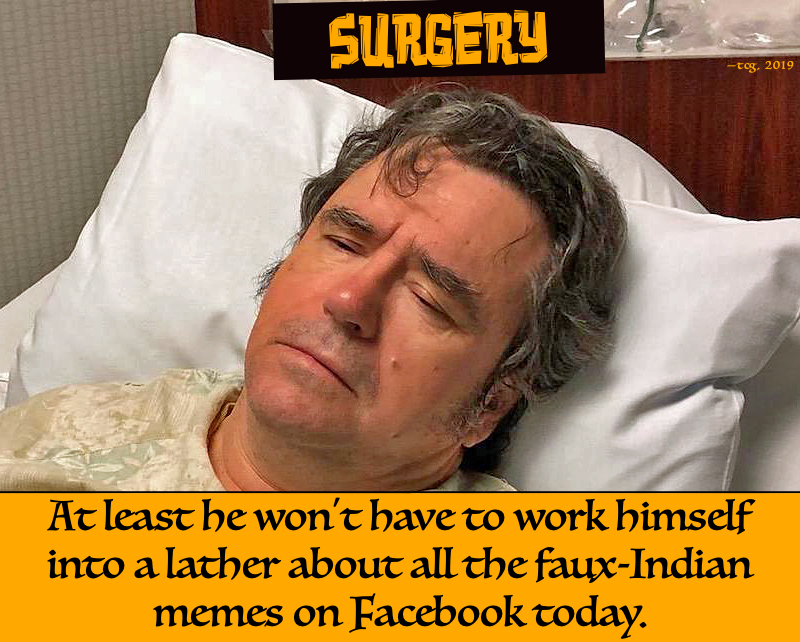 |
|---|
| "It's a burden, believe me." (BTW, the surgery went fine.) |
|
|---|
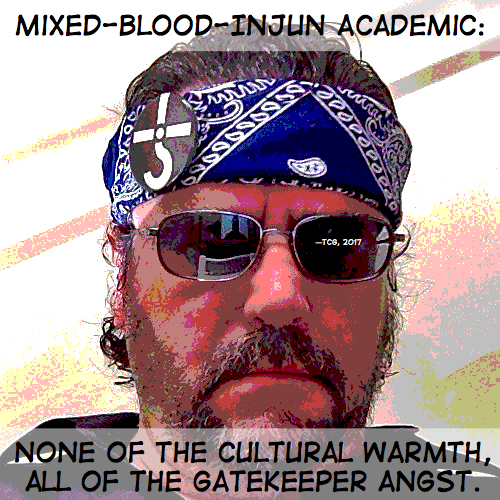 |
|---|
| ("No comment.") |
 Half of Anything (YouTube) Half of Anything (YouTube) |
|---|
Half of Anything. Dir. Jonathan S. Tomhave. Native Voices (U of Washington Native Studies Program), 2006. VHS. Short film on Native identity, including Alexie's famous reply to the question, "What is a real Indian?" The Sherman Alexie sections shown in class were 1:30-3:40 and 8:36-12:30; John Trudell is at 4:36-5:31 and 16:15-19:57. |
 TH, March 3rd:: TH, March 3rd::
| | 
Adrian C. Louis: "Degrees of Hydrophobia"(from Among the Dog Eaters, 1992) |
|---|
| | —controlling metaphor of the canine as the wild, the savage, who "stains all the rugs of the world" . . . irony of the Alexie epigraph & Louis's own situation, teaching the "language of the enemy" . . . "slapstick" humor: "Coyote is simply a dog without Alpo"; "the Redskins won!" . . . serious/"spiritual" finale (end of section III, section IV)—and again, the conflation of Native and canine: conjuring "a time long ago / when words had meaning / when language had value / when both men and dogs / were strong silent hunters" (4.7-11). |

Tiffany Midge: "Written in Blood"(from Outlaws, Renegades and Saints, 1996) |
|---|
| | **** A tour de force based on the tensions/ironies of the "two worlds": Midge claims/wants to be writing a poem of Native outrage about the slaughter at Wounded Knee (stanza 2), but she must use the "language of the enemy"—including "his" thesaurus! This reference work has "betrayed" her because she finds, as synonyms for "murder[er]"—"savage, Apache, redskin" (212). (Okay, it was a 1961 edition, to be sure!) | | | —strophe 1: what does she mean in confessing a "crime" of "meta-innuendo"? | | | —st. 2-4: the "why" of her thesaurus/poetry efforts ("three-hundred" dead—guess what event she's referring to!) | | | —st. 3: "language of the enemy" = a buzz-phrase, now, of course, from Alexie, Harjo, et al. | | | —st. 5-7: but she admits to having "failed"—"betrayed" by a language itself that includes such "synonyms for murder" as "savage, Apache, redskin." |
 | Sherman Alexie: "Indian Education" (The Toughest Indian in the World 35-56) |
|---|
| —(Socio-economic) CLASS— | | • | The title (35) pretty much states the "theme" of the story, that sometimes (or maybe more often than not)—in terms of the intersectionalities of race, class, & gender—CLASS overrides ethnicity. | | • | As in several other stories this semester (often set in the 19th century!), the ostentatious sociality of the upper-class lifestyle is fairly nauseating—to me, anyway! The first two years of Edgar & Susan's marriage consist of "thirty-seven cocktail parties, eighteen weddings, one divorce, seven Christmas parties, two New Year's Eve parties, three New Year's Day parties, nine birthday parties . . . six opera performances, nine literary readings[!], twelve museum openings, one museum closing, three ballets . . . one spouse-swapping party . . . and thirty-two films" (42). | | —Alexie: Master of Humorous Dialogue/Clever BANTER— | | • | The initial interchange between Edgar Joseph (Eagle Runner!) and his future wife Susan is one of the most notably hilarious examples of Alexie's talent in this regard, especially the deadpan exchange about her one bad eye (36-37). | | —INDIAN Ethnicity/Identity I— | | • | Alexie humorously points out a common "racial" fact in American culture, that minority group members often have an inferiority complex when it comes to the dominant "race": Edgar's habit is to have relatively low standards and thus to pursue "the tenth most attractive white woman in the room" (37)! And WHY a white woman? In much of Alexie's fiction, there is the ubiquitous Indian male who has a "thing" for white women. (I'd explain this, in part, as the result of internalized racism.) | | • | Speaking of internalized racism, EJ's own mother seems ashamed of her indigenous blood: "When asked, my mother told white people she was Spanish, not Mexican, not Hispanic, not Chicana, and certainly not Spokane Indian with a little Aztec thrown in for spice, even though she was all of these things" (40). | | • | Conversely, EJ also has a great need to (re?-)identify with his Native heritage, including his apparently recent name change: "'I'm Edgar Eagle Runner,' I said, though my driver's license still read Edgar Joseph" (39). | | • | Like many an Alexie main Native character, Edgar has—the urge to "go home," to return to his ethnic roots. It's first evidenced in the story via the prostitute: "'Do you employ any Indian women?,'" he asks the call-girl agency; moreover, we learn that he's "never had intercourse with an Indian woman" (43). Of course, the woman turns out to be a mockery of Indian "authenticity." Her (fake) name is "Tawny Feather"; she shows up wearing "a string of fake pearls," with "[d]reamcatcher earrings, turquoise rings, [and] a stainless-steel eagle pinned to her lapel" (44-45)! Worst (or best) of all: "She was also a white woman wearing a black wig over her short blonde hair"! EJ says, "'You're not Indian'"; she says, "'But you are.'" He replies, "'Mostly'" (45)! | | —"We're a SALMON People"— | | • | Alexie's frequent reference to his salmon-fishing salmon-fishing tribal background is played out here, with some pretty sad overtones of human tribal cultural loss & extinction. Susan: "'What kind of Indian are you?' 'Spokane.' 'Never heard of it[?!—she's from Seattle/Washington state?!]. —'We're a small tribe. Salmon people.' 'The salmon are disappearing,' she said. 'Yes,' I said. 'Yes, they are'" (39). | | —Overt RACISM— | | • | As for their wedding: "Susan's handsome brother and parents stayed away as a protest against my pigmentation" (39). | | —(Genetic) ASSIMILATION— | | • | Another commonly voiced "theme" (& fear) in Alexie is the possibility of Indian extinction via intermarriage. EJ's own mother even becomes a spokesperson in favor of that possibility here: "Velma, my dark-skinned mother, was overjoyed by my choice of mate. She'd always wanted me to marry a white woman and beget half-breed children who would marry white people who would beget quarter-bloods, and so on and so on, until simple mathematics killed the Indian in us" (40). | | —(Other) Indian STEREOTYPES— | | • | EJ: "I don't drink alcohol, never have, mostly because I don't want to maintain and confirm any of my ethnic stereotypes, let alone the most prevalent one, but also because my long-lost father, a half-breed, is still missing somewhere in the bottom of a tequila bottle" (47). (Note that this may be a response to the accusation, after his first collection The Lone Ranger & Tonto was published, that he largely had played into the Indian-as-drunk stereotype in his character portrayals.) | | —INDIAN Ethnicity/Identity II— | | • | EJ's climactic encounter with the Indians in the "Indian bar" leads to an identity crisis in which racial identity is confronted head-on by economic class. Tellingly, the big Indian guy—Junior—asks EJ, "'who the hell do you think you are'" (49)? Exactly. Junior makes the class (& urban vs. reservation) distinction explicit: "'Fucking urban Indians in your fancy fucking clothes. Fuck you. Fuck you.'" EJ even thinks, he's right!: "I looked like a Gap ad"! Junior continues: "'Why don't you just get in your BMW, that's what you drive, enit?'" Then one of the funniest lines in the story: "I didn't drive a BMW; I drove a Saab" (50)!! (And later, Sissy the bartender asks him, "'What, you think you're a lawyer now?' 'Actually, I am a lawyer'" [53]!) | | • | Oh, and about that intermarriage thing—Junior continues: "Just drive back to your fucking mansion" in "whatever white fucking neighborhood you live in. Drive back to your white wife. She's white, enit? Yeah, blonde and blue-eyed, I bet" (50; ouch—MY 1st wife!). | | • | Probably the most famous line in the story (see "Crazy Horse" & "warrior" in my vocab. table above): "Deep in the heart of the heart of every Indian man's heart, he believes he is Crazy Horse" (53)—even (or especially?!) mixed-bloods who drive Saabs!? | | • | The story's "thematic" (& emotional?) climax comes when Sissy asks him the central question: "'Why'd you come here?' . . . 'I wanted to be with my people,' I said. 'Your people?' asked Sissy. 'Your people? We're not your people.' 'We're Indians.' 'Yeah, we're Indians. You, me, Junior. But we live in this world and you live in your world.' 'I don't like my world.' 'You pathetic bastard . . . . Do you know how much I want to live in your world? Do you know how much Junior wants to live in your world?' Of course I knew. For most of my life, I'd dreamed about the world where I currently resided" (55). . . . "'Junior and me,' she said. 'We have to worry about having enough to eat. What do you have to worry about? . . . Fuck you, fuck you. I have to worry about having enough to eat'" (56). | | —A Marriage on the Rocks?— | | • | Between the prostitute scene & the Indian bar scene, EJ has an epiphany that his wife has probably never ever really loved him: "I looked into her eyes, her blue eyes, and saw that her good eye held no more light in it than her dead eye. . . . She'd just stopped seeing me. I was startled by the sudden epiphany that she'd been faking her orgasms all along . . . probably since the first time we'd made love" (46). | | • | At the end of the Indian bar episode, Sissy tells EJ, "'Just go home,'" but his final "going home" to his wife seems bittersweet & resigned at best. His last words, to Susan: "'I was gone,' I said. 'But now I'm back'" (56). This is a reversal of the usual Native-going-home-to-his/her-culture, a "victory" of CLASS over "RACE," as he seems to finally "settle" for a loveless marriage of bourgeois respectability. |
 | Standing Bear: "At Last I Kill a Buffalo" (Trout 423-29)
(from My Indian Boyhood [1931]) |
|---|
| |
-*-eight years old; Ota K'te (Plenty Kill [better: Many Kills]; the childhood "nickname" comes from his father's exploits, actually!)
-*-Preparation the day & night before: par. 1-9; the weapons prep., the orderly quiet, the anticipation (and quiet) of even the horses! ("It is . . . natural that the Indian and his animals understand each other very well both with words and without words" [par. 3; see also 12].) . . . SB's worry about such a "character" test: "Would I be brave . . . . ?"
-*-the Hunt: par. 10-24
—the BUFFALO (& animal Other!): "When they saw us, they all ran close together as if at the command of a leader"! (14)
—N.B.: animals-rights vs. hunting-culture controversy
—the initial charge—and fear: "I was in the midst of the buffalo, their dark bodies rushing all about me and their great heads moving up and down to the sound of their hoofs beating upon the earth" (16).
—the Calf: "about my size": the kill, subsequent pride; but it took him "five arrows" (18)!?
—the Temptation (& morality tale): take out two arrows, and lie? . . . but father arrives, Ota K'te "could never lie" to him, and Dad finishes skinning the calf (19). . . . "thesis"/gist: "I am more proud now that I told the truth than I am of killing the buffalo" (21). (Note that this "tagged-on" moral feels very much directed towards his white audience.)
-*-Elegiac finale: "It lives only in my memory, for the days of the buffalo are over" (24). |
| | 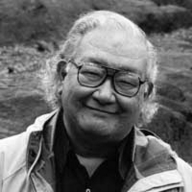
N. Scott Momaday: "Introduction" from The Way to Rainy Mountain (Trout 367-373)
*—par. 1: amazing imagery/natural descriptions!
*—story of Kiowa history & journey in general (Montana->Black Hills->Oklahoma) (368-371)
*—his grandmother Aho, "who knew "from birth the affliction of defeat, the dark brooding of old warriors" (369)
*—Tai-me, "the sacred Sun Dance doll" (369; origin of "sun worship"?—geography/climate/"place": "The sun is at home on the plains"; "there" it has the "character of a god" [Don' we KNOW it!]) (370)
*—Devil's Tower and the legend of the seven sisters and their brother—er, bear (370)
*—last (consummated) Kiowa Sun Dance: 1887 (grandmother 7 yrs. old); stopped by U.S. soldiers in 1890: "deicide" (371)
*—par. 10: amazing personal description of his grandmother before her death (371)
*—last few paragraphs: understated yet moving elegy to a culture! . . . ends up at his grandmother's grave, and—in true Momaday fashion—a place with "dark stones and ancestral names" (372-373) |
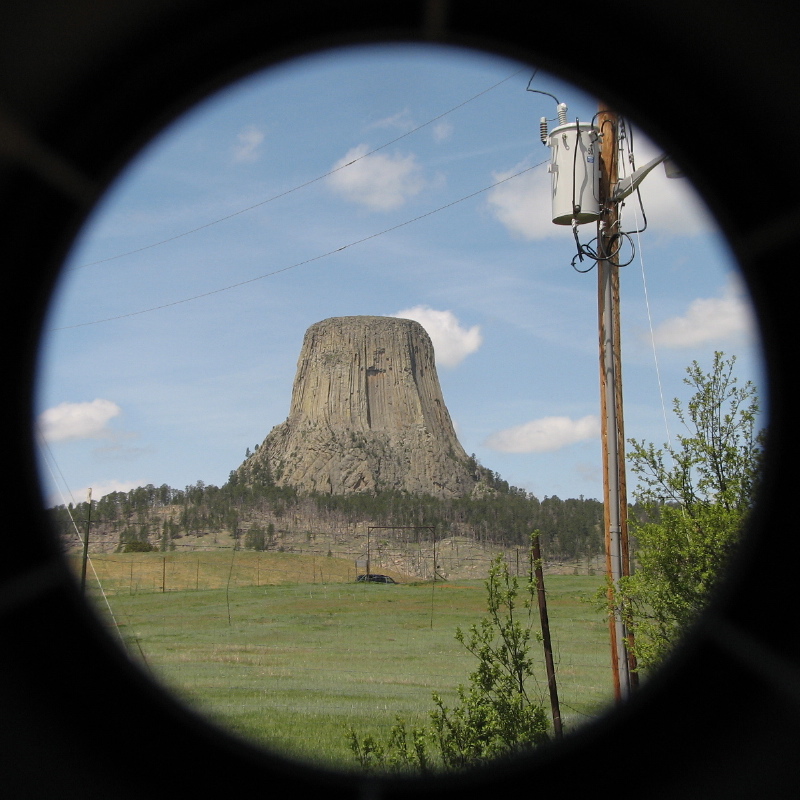 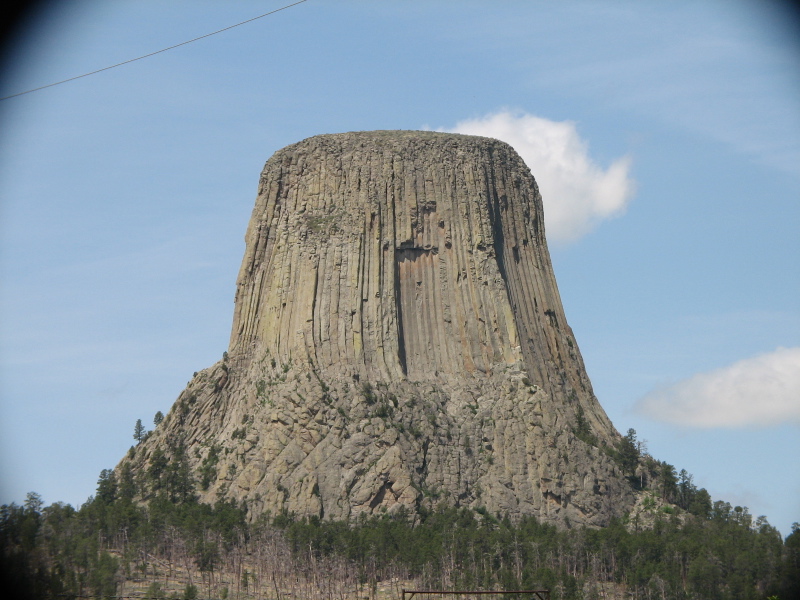 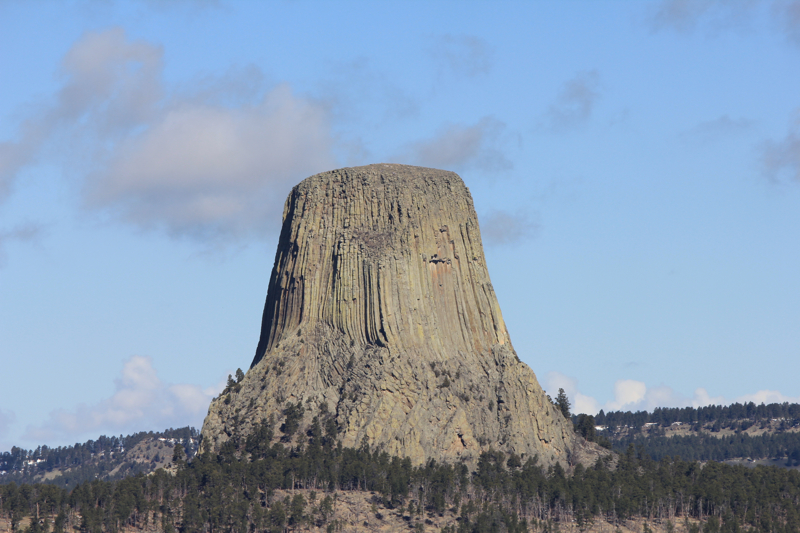 Devil's Tower, Wyoming
(TCG, 2009, 2011; click photos to enlarge)
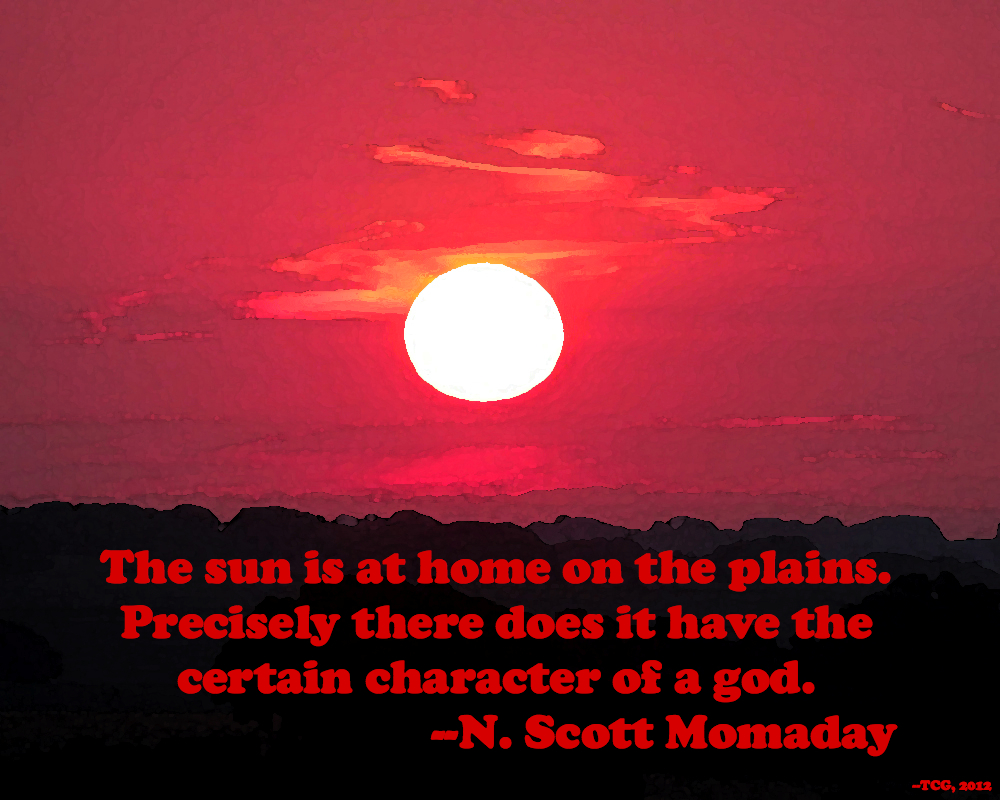 |
|---|
—my 1st attempt at a schmaltzy college-dorm-room-poster meme
(my photo: Branched Oak Lake, 2012) |
 RESPONSE #3—Due TUES., 3/8—CHOOSE ONE (2 or more pages)—80 points: RESPONSE #3—Due TUES., 3/8—CHOOSE ONE (2 or more pages)—80 points:
—Don't worry about MLA formatting, headers, etc.; but do indicate which option you're doing, please.
a) As mentioned on the syllabus, one option is to turn in a do-your-own-thing "READER'S JOURNAL" that addresses a "goodly" range of the readings (see list below).
b) Weaver's "Indigenous Identity" is the most "academic" discussion of Native identity in this set of readings. Relate her social-scientific discussion to at least THREE other texts from this range of readings, showing that her theoretical musings and other more creative Native treatments of "identity" actually have some relationship. (For instance, how do her "three facets" of Native identity apply to, say, Alexie's "Class" versus, say, Silko's "Yellow Woman"?)
c) "Top Five" Poems: Discuss five of the poems from this range of readings, ranking them from first- thru fifth-best. (Feel free to throw in the ones you HATE the most as, say, 4th- & 5th-best!) Most importantly: Why did you rank them so? Criteria can include aesthetic worth, certainly, but since this is class is ETHN 201, your criteria should also include their success at Native "representation" (which I use in the broadest sense of the word!). You could even try applying K&V's FOUR MAIN "THEMES" of "Indian Lit" (103)?! [To speed your decision, I've asterisked(*) the poems in the list below.]
d) Free (but focused) Response: develop your own topic-choice as a focused response on ONE of this unit's themes—"Tribal Sovereignty" or Native Identities" or "Native Communities" or "Native Stereotypes"—dealing with at least three of the readings from this range of texts.
—Note: For all responses, please include p#'s in parentheses for any specific references to our texts. Also, please avoid simply rehashing ideas brought up in class or in my online outlines: do "something else" that still demonstrates that you've done the reading. (New add: also avoid lengthy/straight plot summaries: your audience is someone who has also read these texts [me]; (brief) plot references should only be used in support of your own arguments.)
—Note: The full range of texts for Response #3 is as follows: Vine Deloria, Jr.: "A Simple Question of Humanity"; Silko: "The Border Patrol State"; Midge: "Mt. Rushmore & The Arm of Crazy Horse"*; Weaver: "Indigenous Identity"; Bruchac: "Ellis Island"*; Louis: "Degrees of Hydrophobia"*; Midge: "Written In Blood"*; Alexie: "Class"; Standing Bear: "At Last I Kill A Buffalo"; Momaday: Introduction to The Way to Rainy Mountain; Silko: "Yellow Woman and a Beauty of the Spirit"; Momaday: "The Delight Song of Tsoai-talee"*; Million: "The Housing Poem"*; Trout: "Images and Identities"; Suzan Shown Harjo: "Good Indian, Bad Indian"; Allen: Introduction to he Sacred Hoop; Green: "The Pocahontas Perplex." |
 TU, March 8th:: TU, March 8th::
 Leslie Marmon Silko: "Yellow Woman and a Beauty of the Spirit" (Yellow Woman 60-72) Leslie Marmon Silko: "Yellow Woman and a Beauty of the Spirit" (Yellow Woman 60-72) |
|---|
| | —S.'s hybridity, her "different" appearance, accepted by the old Laguna, versus modern/Euro-American racism (60-61, 64-65): to the "old-time people," "a person's appearance and possessions did not matter nearly as much as a person's behavior" (61) | | | —memories of times with great-grandmother ("Grandma A'mooh") (61-63) | | | —oft-repeated story of the tourist who waves her out of the picture of "Indian kids" (63; 105-106) | | | —redux of Thought Woman & Creation—incl. a moral relativism: "there is no absolute good or absolute bad; there are only balances and harmonies" (64) | | | —S.'s own cultural binary, à la Deloria ("There was the white people's way and there was the Laguna way" [65]): | | | | —the Pueblo: "communal" and "egalitarian"—no social hierarchy, sharing of "resources"; "beauty" based upon behavior, especially "one's relationship with other beings"; in contrast, Western "definitions of beauty" are "really codes for determining social status" (65)! | | | | —Pueblo women in particular: traditionally "strong" and "sturdy"; no sexism (indeed, a matrilineal culture) . . . also, no ageism (66) | | | | —at last, since "identity" itself "always" in "flux"[!] (66-67), all gender identities are possible—and tolerated, including cross-dressing, homosexuality (for "we are all a mixture of male and female"); indeed, differences tolerated, even "celebrated," as at last sound ecology (= biodiversity within a culture/species!): allows greater chance for the group's survival (67) . . . also tolerated: extramarital affairs, unwed mothers (67-68); at last, "To be different, to be unique was blessed and was best of all" (68) | | | —other species: transformation into ~ via ceremonial clothing and masks ultimately "to reaffirm the urgent [species inter]relationships" (68-70); thus a long Pueblo tradition of eco-consciousness underlies the many human-and-animal "myths"; example: story of the Green Bottle Fly "messenger" (69) | | | **—Yellow Woman (Kochininako) (70-72; "part 2" of essay): | | | | —"represents all women in the old stories" (70; see also 72); note: the "Yellow" refers to the "ritual color of the east," not the color of her skin (as Silko would apparently prefer!) (71) | | | | —most importantly, WHY Silko identifies so much with her: "she dares to cross traditional boundaries of ordinary behavior during times of crisis in order to save the Pueblo; her power lies in her courage and in her uninhibited sexuality" (70); her stories made Silko "aware that sometimes an individual must act despite disapproval [e.g., publishing Almanac!?], or concern for . . . what others might say. From Yellow Woman's adventures, I learned to be comfortable with my differences" (71) |
 Running on the Edge of the Rainbow: Laguna Stories and Poems (U of Arizona) Running on the Edge of the Rainbow: Laguna Stories and Poems (U of Arizona) |
|---|
| —A charming video (w/ transcript) of Leslie Marmon Silko as a young "storyteller" (Words & Place series, U of Arizona, 1978); shown before class: 0:00-9:35; for her beautiful (& cryptic) poem about, and from the point of view of, Yellow Woman ("Indian Song: Survival"), see 21:00-27:58 (the end). |

N. Scott Momaday: "The Delight Song of Tsoai-talee"(from In the Presence of the Sun, 1992) |
|---|
| * "" (orig. from Angle of Geese, 1974; search for the video A Man Made of Words for NSM's reading of this poem: his long intro begins at 7:24, the poem itself at 11:45) | | | [—note: Tsoai-talee is NSM's Kiowa name; it means "Rock Tree Boy" (and "Rock Tree" = Devil's Tower).] | | | —"ORAL TRAD. form: incantatory" incremental repetition thruout ("I am," "I stand"—though one might also claim the influence of Walt Whitman here?!); and the second strophe has a circular frame, via the repetition of the 1st line as the last ("You see, I am alive, I am alive") | | | —"I am" all these other various aspects/beings of nature (incl. several images of light), until the grand monistic (& Walt-Whitman-like) gesture: "I am the whole dream of these things" (18); ergo, "I stand in good relation to the earth" . . . (then the pleasingly personal penultimate line, in contrast to the general mystical expansiveness: I'm also in good with the chief's "daughter"!) |
 A Man Made of Words: N. Scott Momaday (UCSD [YouTube]) A Man Made of Words: N. Scott Momaday (UCSD [YouTube]) |
|---|
| —Momaday reads from a number of his works—and talks at length about his Kiowa heritage. His long intro to "The Delight Love Song of Tsoai-talee" begins at 7:24, the poem itself at 11:45. |
| Dian Million: "The Housing Poem" (Harjo & Bird 164-166) |
|---|
| | * Biog. intro is a lament about forced adoptions, the "whole history of the attempt to destroy our families" (163-164). | | | * Semi-humorous, semi-poignant, poem of an extended family (Lakota: tios[h]paye) that gets larger and larger, and happier—until the landlord wants to evict them, with the final play on the meaning of "single-family occupancy" (Harjo & Bird 166) as revelatory of cultural differences/misunderstandings . . . |
| Lawana Trout: "Images & Identities" (Trout 1-3) |
|---|
| | (Hey: a summary/review of key ideas from the semester is good thing!) | | | Perhaps the most interesting passage: "The identity issue is crucial for Native American authors. Again, no one [identity] model and no single definition exists. Most have mixed heritages, and it is not surprising that many of the most poignant self-images and powerful characters in Indian literature express the anguish of defining Indian selves" (3) |
 Suzan Shown Harjo: "Good Indian, Bad Indian" (Shoot the Indian 43-47) Suzan Shown Harjo: "Good Indian, Bad Indian" (Shoot the Indian 43-47) |
|---|
| | • Harjo's talk, she declares, is about stereotypes (43); the first she'll talk about is— | | | • "Redskins," or "the 'R' word": "why did they choose that term?" Because it "referred to the actual practice of skinning Indians," of "providing Indian pelts, Indian skins," as evidence to collect bounties (43). (I'm more familiar w/ the theory of V Deloria & others that the term referred specifically to Indian scalps, and the blood on the "skin" side.) Harjo admits that "a lot of folks who are called 'Indian experts' dispute'" this etymology, due to lack of "paper" (written evidence)—which leads to her next topic— | | | • "oral histories": "although" [as we saw in K&V] the U.S. federal courts used to show "great deference to Native peoples' oral histories," that respect "has changed over time" (44). For instance— | | | • "Kennewick Man" (44): a nine-thousand-year-old skeleton discovered in Washington state in 1996; even after V Deloria's essay that we read and NAGPRA, the discovery resulted in another battle between scientists and Natives regarding what to "do" with it; it took congressional legislation to finally return it in 2016 for reburial by the tribes of the Columbia Basin. | | | • Of course, U.S. mainstream culture is all about the "written word": "Everyone likes paper" (44). | | | • But this whole "oral history" discussion is really a segue to Harjo's jab at Native academics' continual use of words like "story" and "myth and legend" (note that the title of the conference she's at is "Hear Our Story"!). "A story is [just] an opinion": if "you mean history," then "say history." And don't use "myth and legend" when you actually mean Native religious ceremonies and beliefs! Hell, "a myth is . . . almost a lie" (44; as with Elizabeth Cook-Lynn, Suzan Shown Harjo is not a woman you wanna be on the bad side of! ). | | | • The mythos of the word "legend" leads to another stereotype: "Legend is so associated with Native peoples. We don't even skip or run or jump. We roam. Indians are roamers" (44)! | | | • Another stereotype: Indians = [other] Animals. Thus all the images and discourse in which Natives are equated with "herds of animals" (see Z-Sha!?). "I don't mind being associated with animals, but it means something" else to the "people look[ing] at us as something less than human" (44; see Indian mascots in this regard!). | | | • (The par. on the top of p. 45 is an oblique reference to another stereotype, the "Indian giver.") | | | • "Abramhoff [sic] scandal" (45): Jack Abramoff was a corrupt lobbyist convicted, in 2006, of trying to bribe U.S. congressmen—on behalf of a Native tribe's casino interests (the Mississippi Choctaw)! | | | • Harjo now broaches her ultimate call to action, for Natives to be proactive about such stereotypes: "We are our own best advocates"—or can be, if not for low self-esteem from internalizing negative stereotypes, "a by-product of the terms of diminution [reduction] that have been used about us, and used by us so many times, and used in the press to characterize us to the point where we believe it ourselves. . . . We are people who believe in our own victimhood, unfortunately, and who . . . live out that scenario" (45; see also 47 below). | | | • In sum, it is essential "to understand that these words and images about us are directly tied to our future and the way that people treat us" (45; including, I would add, the very existence of Indian mascots). | | | • "And we have to tell the American media, 'You don't get to tell these bad stories anymore.'" . . . Even the New York Times—probably "our best paper"—while beyond its old 19th-century stereotyping, still practices a "white glove racism" (46)! | | | • "the killing of Black Kettle" (46): Custer's dawn-raid massacre of Black Kettle's Cheyenne people at the Washita River (Oklahoma) in 1868; we've at least seen it mentioned in Louis's "Red Blues" poem. | | | • "white-glove racism"? Can you give us an example, Suzan? Well, for instance, "the American media will elevate the people who are pretending to be Native peoples so that some of our most famous Indians are not Indian at all"—including Ward Churchill and Jimmy Durham (46; both of whom claimed CHEROKEE, BTW!). | | | • "the person who wrote 'The Education of Little Tree'" (46): that is, Asa Carter, aka "Forrest Carter" (whom I may have mentioned before in class), another Indian faker who turned out to be a KKK leader! | | | • Why does the mainstream media (and culture) do this? "Because they're so much like them. They" are seeing "themselves"! The media "always gravitate to either the good Indians or the non-Indians who are pretending to be Indians, and elevate them, and try to separate the hostiles from the good Indians" (46). | | | • Harjo then refers to the Civilization Regulations Act, which, "from 1880 until the mid-1930s" divided the "good" from the "bad" Indians by law: "you would be declared a hostile . . . if you didn't behave like a civilized person, which meant Christian, English, short hair, no dancing" (46)! The Act also criminalized Natives who left the rez; you weren't a "good" Indian "if you roamed off the reservation... it actually says, no roaming off the reservation" (47; HA!)! | | | • And so (and explaining the essay's title): both stereotypes and laws have "set up this bad Indian–good Indian paradigm that we are still suffering from" (47). | | | • [internalized racism again:] "We are people who oftentimes live out our stereotypes and pander to the worst stereotypes about us"—and "think there are only two choices." Choice #1: "the good stereotype of the stoic Indian" traveling "down the trail of defeat so you have the Indian slumped over the horse"—that is, "the end of the trail Indian." (See photo of sculpture; note that this is the "good" Indian, accepting the "defeat" of assimilation. Sadly, even ironically, my mom chose this famous image for her tombstone, unaware of its ideological overtones.) Choice #2: "the drunk in the gutter" (47). | | | • HOWEVER, "there is a middle ground": one doesn't "have to be one stereotype or another." Those who can't realize that are victims of internalized racism, the "internalizing of our own oppression and suppression and colonization that can manifest itself so easily." So, finally, "remember, there's no such thing as a good stereotype. For the Indians, don't be a good Indian. For the non-Indians, pay attention to what the hostiles say" (47). |
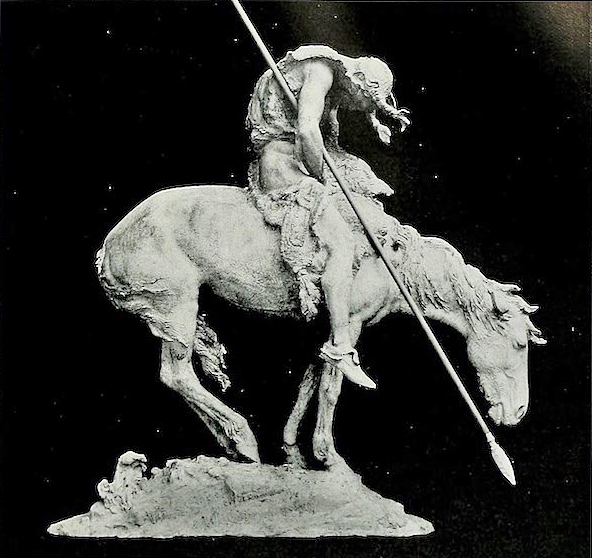 |
|---|
—James Earle Fraser's End of the Trail (1915):
see S. S. Harjo's "Good Indian, Bad Indian" (47). |
 TH, March 10th:: TH, March 10th::
 | Paula Gunn Allen: Introduction to The Sacred Hoop (1986) |
|---|
| | * Origin of Sacred Hoop title/motif: via her mom, and Black Elk Speaks, Allen learns that "animals, insects, and plants" deserve the "respect" given to humans, that life is a "circle," a "sacred hoop" (1). . . . . later: "the complementary nature of all life forms" (3) | | | * Allen's 7 "major themes" of Native American Lit.: | | | | 1) "Indians and spirits are always[?!] found together" (2). [Later:] "the inevitable presence of meaningful concourse with supernatural beings" (3) | | | | 2) SURVIVAL: "Indians endure" (2). | | | | 3) "Traditional tribal" cultures were "gynocratic," "never patriarchal"; moreover, such a "gynocratic" view—based "on ritual, spirit-centered, woman-focused"—is in line with, and fine support for, current "activist movements" (2). . . . . "the centrality of powerful women" (3) . . . . Definition of "gynocracies": "woman-centered tribal societies" (3)—including "female deities of the magnitude of the Christian God" (4) | | | | 4) The genocide of Native Americans by Western colonization stems largely from the latter's patriarchal fear of the former's matriarchal basis: thus an attempt at cultural erasure "to ensure that no American and few Native Americans would remember that gynocracy was the primary social order of Indian America prior to 1800" (3). [Note: my—uh—reservations regarding Allen's anthropological theories were expressed in class. Allen herself later admits that various tribes are "as diverse as Paris and Peking" (6).] | | | | 5) "There is such a thing as American Indian Lit"[!]—and a nice [Western academic!] breakdown thereof: a) traditional lit.: i) ceremonial [sacred] and ii) "popular" [non-sacred]; b) contemporary lit, incl. many Western genres, plus an emphasis on "autobiography, as-told-to narrative, and mixed genre works"—but still incorporating "elements from the oral tradition" (4). [Notes: Allen's "main"(?!) reason for studying NA lit—'cuz it helps us understand Anglo-American writers?! (4)—seems rather peripheral; 2ndly, her conception of "American Indian literature" as a unified "body," a "dynamic, vital whole" (4) smacks of a pan-Indian essentialism that this Lakota resents!] | | | | 6) Western interpretations of NA cultures inevitably "erroneous" (4), based as they are on the bipolar (+/-) stereotypes of the "noble savage"—that "guardian of the wilds and . . . . conscience of ecological responsibility"!—and the "howling" or "hostile savage"—the stereotypical image "most deeply embedded in the American unconscious" (4-5) | | | | 7) Native American cultures based on "sacred, ritual ways" are similar to many (heck, most) other non-Western cultures of the world—partaking, indeed, in a "worldwide culture that predates western systems derived from the 'civilization' model" (5; what deep ecologists Devall & Sessions have dubbed the "perennial philosophy"); thus NA peoples have shared with those of the Third World the "outrages of patriarchal industrial conquest and genocide" (6). | | | * Allen's personal-autobiographical finale: her ideas originate from a "Laguna Indian woman's perspective . . . . unfiltered[?!] through the minds of western patriarchal colonizers" (6; and yet several of her later notions derive specifically from the European psychology of Carl Jung!). | | | | —Like Leslie Silko, she identifies with the Laguna Pueblo goddess, Yellow Woman: she is "'Kochinnenako in Academe'" (6). | | | | —Native-identity assertion: Allen's "self who knows what is true of American Indians because it is one" (6). | | | | —But she is both Native and Western-Civ., at last? ("somewhat western and somewhat Indian")—both reflective & observational (Western), but also "metaphysical," evidenced in her "guidance from the nonphysicals and the supernaturals"—including the "Grandmothers"; and so her "New Age-y"/Eco-Indian coda, in which she thanks the elements of nature, the "sticks and the stars" for the best "training" that she has garnered (7). |
|
|---|
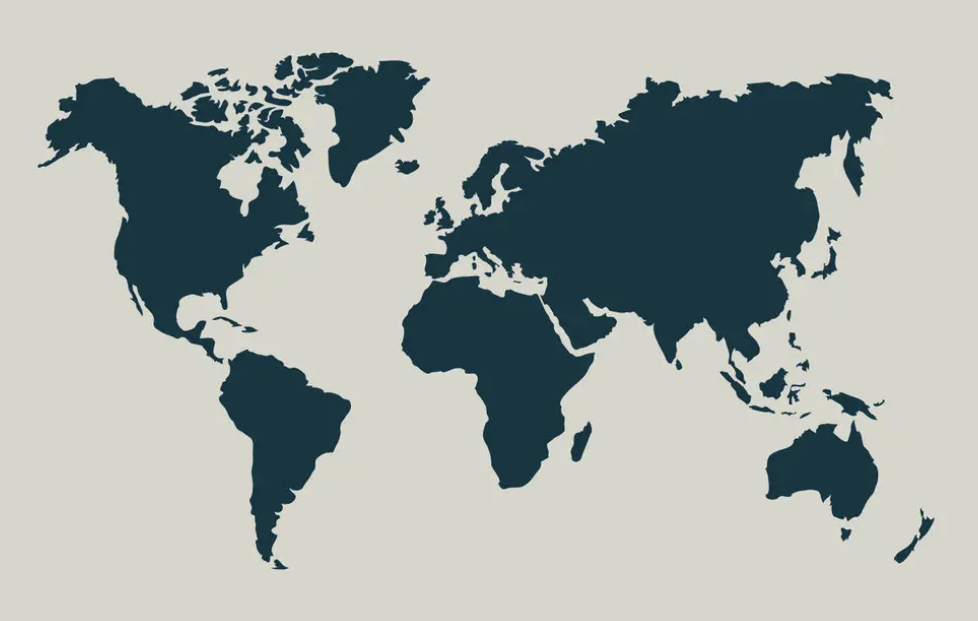 |
|---|
| Europe is just a peninsula of Asia (see P. G. Allen 6)? WTF? Well, just LOOK at a world map without political lines—withOUT Eurocentric bias!And "we" thought Geography was an objective science?! (Also, there is no "objective" reason for the North Pole/northern hemisphere to be on top: the globe/world map could just as well be turned "upside down." Now THERE's a metaphor.) Indeed, how many other "objective facts" do "we" take for granted that are really Euro(-American) biases? |
 Rayna Green: "The Pocahontas Perplex" (NAV 159-165) Rayna Green: "The Pocahontas Perplex" (NAV 159-165) |
|---|
| | • The old narrative trope of a Euro-"adventurer" travelling "to a strange, foreign land" and falling for a "darker but more beautiful Princess" is actually much older than the "Pocahontas–John Smith rescue tale" [which occurred in 1607]: "the elements of the tale appealed to Europeans long before Americans had the opportunity to attach their affection for it onto Pocahontas" (159A-B). . . . Later: "The misnamed Indian was the native dweller, who fit conveniently into the various traditional folkloric, philosophical and literary patterns characteristic of European thought of the time" (160B). | | | • But that's not to deny "the impact the story has had on the American imagination": "the image of her body flung over the head of our hero constitutes a major scene in national myth." But of course such images usually involve "ignorance about the Powhatan Indians of Virginia—often portraying them in Plains dress[!]," and so "one quickly comes to understand that it is the mythical scene, not the accuracy of detail that matters." And Pocahontas's purported saving of Smith "set up one kind of model for Indian-White relations that persists," a "model for the national understanding of Indian women. . . . With her darker, negatively viewed sister, the Squaw . . . the [Indian] Princess intrudes on the national consciousness" (160A; note how this is the gendered version of Harjo's "good" v. "bad Indian" and PG Allen's "noble" v. "hostile savage"). | | | • "Pocahontas Perplex" (160B): Green is presumably playing on psychological complex and perplexing/perplexity—that is, something complicated and problematic. Whatever the case: "Americans had a Pocahontas Perplex even before the teenage Princess offered us a real figure to hang the iconography on. The powerfully symbolic woman, as Queen and Princess, has been with us since 1575 [see painting] when she appeared to stand for the New World." The "Indian" woman became the "symbol with which to identify this earthly, frightening, and beautiful paradise." (Ecofeminists have also noted that, Indian or not, the land that was the "New World" was inevitably cast as feminine, as in "virgin land" and even "the lay of the land.") This "Indian Queen [see painting] began to appear as the sole representative for the Americas in 1575. And until 1765 or thereabouts, the bare-breasted, Amazonian Native American Queen reigned. . . . She was the familiar Mother-Goddess figure—full-bodied, powerful, nurturing but dangerous—embodying the opulence and peril of the New World" (160B). | | | • The "Pocahontas" prototype per se: "Her daughter, the Princess, enters the scene" about the time of U.S. "independence, and she becomes more 'American' and less Latin [American] than her mother"—and less "barbarous" (160B). (Green then confusingly—I think—conflates this Indian Princess with the more Euro-American figure of Liberty, or Columbia, in the least convincing part of the essay [160B-161A].) | | | • Then, "when real Indian women—Pocahontas and her sisters [what a wonderful phrase!]—intruded . . . the responses to the symbol became more complex, and the Pocahontas perplex emerged as a controlling metaphor in the American experience" (161A). | | | • BUT—the "DARK SIDE": "The dark side of the Mother-Queen figure is the savage Squaw" (161A). | | | • the PATRIARCHY: "Both her nobility as a Princess and her savagery as a Squaw are defined in terms of relationships with male figures." For the Princess, she is only a "good Indian" because she "rescues and helps white men"; but, for a real Native woman, this is absurd: "To be Mother, Queen, and lover is . . . impossible" (161A). "The Indian woman finds herself burdened with an image that can only be understood as dysfunctional" (161B). | | | • The various images of "Pocahontas": "Always called a Princess," she "has to violate the wishes and customs of her own 'barbarous' people . . . often out of 'Christian sympathy.' . . . The Princess is 'civilized'": "most pictures portray her as white, darker than the Europeans, but more Caucasian than her fellow natives" (161B). | | | • SUICIDE: often "the Princess is allowed the even grander gesture of committing suicide"; "To be 'good,' she must defy her own people, exile herself from them, become white, and perhaps suffer death" (161B). | | | • Green then studies a number of old folk songs (161B-162A), which "add to the exotic and sexual, yet maternal and contradictorily virginal image of the Indian Princess"; "As long as Indian women keep their exotic distance or die . . . they are permitted to remain on the positive side of the image" (162B; in general, the "dying Indian" was a dominant narrative trope of 19th-c. American literature). | | | • The SQUAW: "But who becomes the white man's sexual partner? . . . It cannot be the Princess, for she is sacrosanct. . . . The Princess' darker twin, the Squaw, must serve this side of the image" (163A; note that the Princess v. the Squaw fits into the general Western patriarchal/sexist dichotomy of the Virgin v. the Whore). Here "no heroines are allowed. Squaws share the same vices attributed to Indian men—drunkenness, stupidity, thievery," etc. (163A-B). Squaws "are shamed for their relationships with white men, and the males who share their beds—the 'squaw men' . . . share their shame." Squaws are often imaged as "fat, and unlike their Princess sisters, dark and possessed of cruder, more 'Indian' features" (163B). | | | • As for real Native women?: "The Indian woman is between a rock and a hard place. . . . her image is freighted with such ambivalence that she has little room to move." Green then reminds of us of Vine Deloria's point that "many whites claim kinship with some distant Indian Princess grandmother, and thus try to resolve their 'Indian Problem' with such sincere[!] affirmations of relationship" (164B). | | | • "Such claims make it impossible for the Indian woman to be seen as real. . . . As some abstract, noble Princess tied to 'America' and to sacrificial zeal, she has power as a symbol. As the Squaw, a depersonalized object of scornful convenience, she is powerless. . . . As the Squaw, her physical removal or destruction can be understood as necessary to the progress of civilization even though her abstracted sister, the Princess, stands for that very civilization. . . . As symbol and reality, the Indian woman suffers from our needs, and by both race and sex stands damned. Since the Indian so much represents America's attachment to a romantic past and to a far distant nobility, it is predictable but horrible that the Indian woman should symbolize the paradoxical entity once embodied for the European in the princess in the tower and the old crone in the cave. It is time that the Princess herself is rescued and the Squaw relieved of her obligatory service" (164B). | | | • At last, "Pocahontas' story . . . offers an intolerable metaphor for the Indian-White experience. She and the Squaw offer unendurable metaphors for the lives of Indian women" (165A). . . . "If we explore the meaning of Native American lives outside the boundaries of the stories, songs, and pictures given us in tradition, we will find a more humane truth" (165B). |
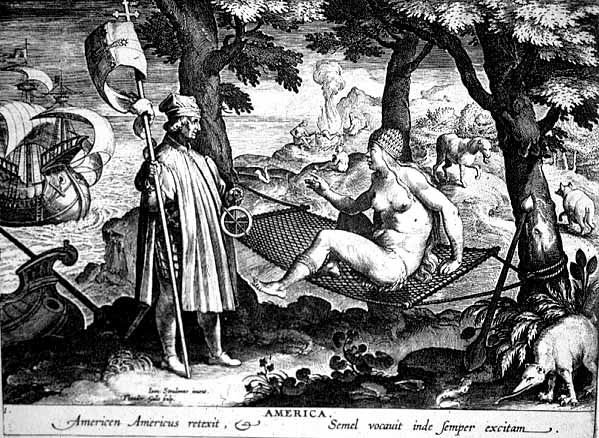 |
|---|
—Jan van der Straet's America (1575)—
Since, in her "Pocahontas Perplex," Green specifies the date 1575, this is obviously the painting she had in mind in her discussion of the "bare-breasted, Amazonian Native American Queen" (160B), precursor to the "Indian Princess." |
 "What Made the Red Man Red?" (Disney [YouTube]) "What Made the Red Man Red?" (Disney [YouTube]) |
|---|
| ——And why does the "Injun" ask "How?"; the racist (& sexist) tune from Disney's Peter Pan (1953); "Hana Mana Ganda," indeed: Why does he ask you, "How?"
Why does he ask you, "How?"
Once the Injun didn't know
All the things that he know now--
But the Injun, he sure learn a lot,
And it's all from asking, "How?" Hana Mana Ganda--
Hana Mana Ganda--
We translate for you--
Hana means what mana means,
And ganda means that too When did he first say, "Ugh!"
When did he first say, "Ugh!"
In the Injun book it say,
When the first brave married squaw,
He gave out with a big ugh
When he saw his Mother-in-Law-- What made the red man red?
What made the red man red?
Let's go back a million years
To the very first Injun prince--
He kissed a maid and start to blush,
And we've all been blushin' since-- You've got it from the headman--
The real true story of the red man,
No matter what's been written or said--
Now you know why the red man's red! |
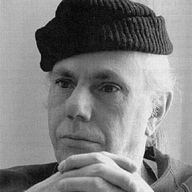
Maurice Kenny: "Reading Poems in Public" (Trout 4-6) |
|---|
| | —The poet speaks of real(?!) Native life and the "old stories," while his non-Native audience focuses on the superficial; their "Indian," at last, is still "Geronimo on the late show." |
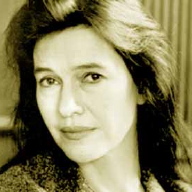
Louise Erdrich: "Dear John Wayne" (Trout 42-44) |
|---|
| | —Natives at a drive-in "whoop it up" sarcastically at a John Wayne movie; more seriously, the colonialist, Manifest-Destiny urges that John Wayne epitomizes are indicted: "Everything we see belongs to us." (Note: the final two lines refer to the disease that killed John Wayne—cancer: itself a metaphor here for "take it all" colonialism.) |

Sherman Alexie: from "The Unauthorized Biography of Me"(from One Stick Song, 2000) |
|---|
| | —Here Alexie takes pot-shots both at the publishing industry and at Anglo & mixed-blood authors who are privileged in such a system. Targets include an audience still infatuated with Natives as the past and as the prototypical Sioux plains warrior; Anglo/mixed-blood writers who are most likely to use "obvious Indian names, such as Eagle Woman" and use such verbiage as "Great Spirit"; and book covers with unbelievably "mythic" animal iconography. Finally, remember: "If a book about Indians contains no dogs, then it was written by a non-Indian or mixed-blood writer." (Thank the gods, Alexie's poem now contains at least one canine!) |
 White Shamans & Plastic Medicine Men (Native Voices Public Television, 1995 [YouTube]) White Shamans & Plastic Medicine Men (Native Voices Public Television, 1995 [YouTube]) |
|---|
| —regarding fakers ("pretendians") w/ names like "Eagle Woman and Pretty Shield"; of course, the great glory of this film is the ironic hilarity created by the white practitioners' blithe unconsciousness of how foolish they would look in the context of the movie as final product! . . . shown before class: 0:00-4:09 |
 | Sherman Alexie: "Dear John Wayne" (The Toughest Indian in the World 189-208) |
|---|
| • | The first part of "Dear John Wayne" (189-195) consists of an hilarious "interview" between a "cultural anthropologist" Spencer Cox and a 118-year-old Spokane Indian woman, Etta Joseph, in the year 2052. (The interview includes many seconds of uncomfortable silence!) While Cox is a supposed expert on the Spokane tribe, on powwows, etc., Etta's trickster banter reveals that much of what the anthropologist "knows" is based upon bookish stereotypes. For example, Spencer's current "profound study" is "on the effect of classical European ballroom dancing on the indigenous powwow—a revolutionary text" (193; ha!). Etta even explodes the cliché of the "oral tradition": "Don't give me that oral tradition garbage. It's so primitive. It makes it sound like Indians sit around naked and grunt stories at each other" (193). Also, Etta has read all the "Great Books" of Western culture; her point?: "I know so much more about you than you will ever know about me." She then refers to the "three minutes an hour" she gets to just be Indian. When Spencer asks about those, she replies, "Oh, no, no, no. Those three minutes belong to us. . . . You've colonized Indian land but I am not about to let you colonize my heart and mind" (194). |
|---|
| • | We learn at the end of this part that, as a young woman, Etta lost her virginity to John Wayne during the making of The Searchers (195). The second half of the short story feels like another story altogether (196-208), less hilarious (in my opinion) and almost surreal in presenting a John Wayne—er, Marion Morrison—who is more human, loving, tender, who knows how to cry—and who is even understanding of his kids' cross-dressing (202-203)! (Can you imagine the "real" John Wayne saying, "'gender is mostly a social construction'" [203]?!) This portrait is patently absurd, and the reader is discombobulated. WHY is Alexie doing this? Is he seriously combatting the stereotype, the MYTH, of the macho Indian-killer persona of John Wayne? Is he just playing with the audience to the point of absurdity? |
|---|
| • | Another great one-liner (I've refrained from listing most of my favorites): When Cox says, "How oxymoronic," Etta replies, "Yeah, kinda like saying Native American. There's an oxymoron for you" (206). |
|---|
| • | Finally, the ending: "Was the story [of Etta's affair] true or false?" As in a lot of (whitestream) postmodern stories of the last 40-50 years, the reader is left hanging (and even wondering what the last sentence even means?!) (208). |
|---|
 from Alexie's "Dear John Wayne" (Canvas) from Alexie's "Dear John Wayne" (Canvas) |
|---|
| —Alexie reads the first half of his short story "Dear John Wayne," to copious laughter. (If the link doesn't work, the .mp3 is on Canvas, in the "03 NATIVE STEREOTYPES" ƒ.) |
 "John Wayne's Teeth" (from Smoke Signals [YouTube]) "John Wayne's Teeth" (from Smoke Signals [YouTube]) |
|---|
| —Victor's mocking improv here about John Wayne is much more characteristic of Native attitudes towards the famous actor than the truly odd portrayal in Alexie's "Dear John Wayne." (Impromptu and satirical, the song might be considered a 49er.) |
 RESPONSE #4—80 points: RESPONSE #4—80 points:
DUE DATES & CHAPTERS—Find the chapter/page range assigned to your last name; then devise 3-6 "good" discussion questions, with potential "student" answers (put the latter in square brackets):
A-C: "Violence" (15-51) —uploaded to Canvas as a WORD .doc by M, 3/21, midnight
Po-S: "Representation" (52-108) —uploaded to Canvas as a WORD .doc by M, 3/21, midnight
T-W: "Athletics" (109-135) —uploaded to Canvas as a WORD .doc by W, 3/23, midnight
E-K: "Technology" (136-182) —uploaded to Canvas as a WORD .doc by M, 3/28, midnight
L-Ph: "Music" (183-223) —uploaded to Canvas as a WORD .doc by M, 3/28, midnight Note: the order was determined by "drawing lots" (TU, 3/8, at beginning of class). NOTES: Put your "Possible student answers" in square brackets, right after each question. These answers will no doubt make up the bulk of your 2 pages (or more). Example (for Standing Bear's "At Last I Kill A Buffalo"): We saw several places in Z-Sha's early childhood narrative where it became obvious that she was writing from an adult, more assimilated point of view. Where do you see this happening here in Standing Bear's chapter?
[Possible student answers: Early on, Standing Bear refers to his own "little brown body" (425), a self-racializing and self-exoticizing rhetorical move similar to Z-Sha's first self-description. (A Euro-American author writing for his/her own culture would see no need to do this.) An even better answer involves his ride back after the kill, like a "king" riding "in state" (428). (Kings/monarchs are obviously a Euro- thing.) Finally, some clever students might even see the whole moralistic ending about "telling the truth" as a "tagged-on" moral very much directed towards his white Christian audience and/or a result of his later religious boarding school training.] | |
Your "Possible answer(s)" could also be your own brilliant idea that might never occur to others: "Ah, I see why Deloria is using this obscure, weak & boring, example! Now I'll just frame it in the form of a question." Note (as I've said before) that "WHY . . . ?" is often a great way to frame a good discussion question: "Why is Deloria . . . ?" Another effective tack: "Which example from this chapter . . . ?" Of course, here your "Possible student answers" likely should list several "good" choices, defending each. . . . But of course you might also want to address your chapter's main argument; e.g. (in the "Violence" chapter): "Deloria argues that the dominant whitestream notion (or ideology, or discourse!) of Native "violence" and war moved to one of "pacification" and containment pretty rapidly, in the space of a few years, in fact. Do you find Deloria's argument here convincing?" In this case, you'll probably want to have developed your own opinion about it to even ask the question. So another way to thing about this assignment: come up with your "answers" first (that is, opinions, impressions) and work backwards to the questions?! Finally, put p. #'s in parentheses for any specific references to the text (see my example above), to demonstrate that you own (have access to) the actual book. |
| Extra Credit Opportunity: Write a one-page-or more summary of/response to Ms. Sans Souci's talk, for a max of 10 extra credit points (due as email attachment by SU, March 13th, midnight). Note that they ask you to "RSVP": there's a working link to the RSVP page in the graphic below:::: | 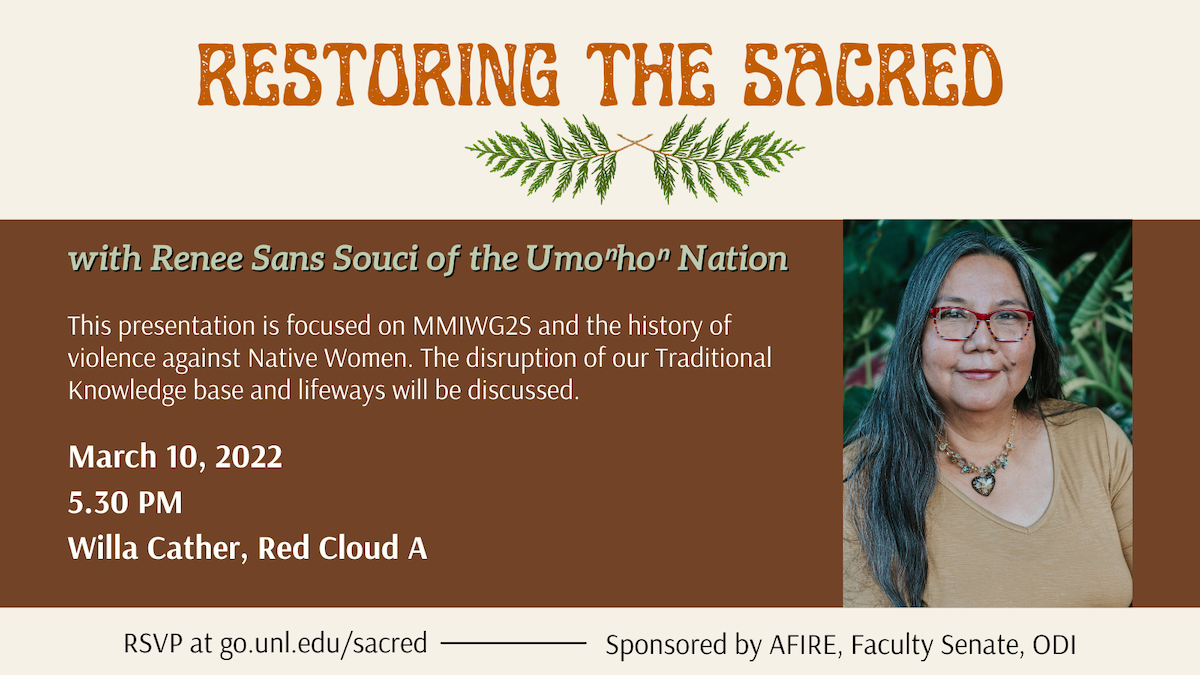 |
|---|
| Extra Credit Opportunity: Write a one-page-or more summary of/response to both the documentary and panel discussion, for a max of 10 extra credit points (due as email attachment by SU, March 20th, midnight). Note, again, that they ask you to "RSVP," to view the film:::: | VIRTUAL FILM & DISCUSSION: March 15, 6 p.m.:
A Look Inside the Bring Her Home Documentary:"The U.S. is facing a human rights crisis known as the Missing and Murdered Indigenous Women epidemic. Out of the 5,712 Missing & Murdered Indigenous Women counted in 2016, only 116 were logged in a Department of Justice database. Join panelists for a discussion about this epidemic in anticipation of the national PBS broadcast of Bring Her Home—a new feature documentary directed by Leya Hale (Dakota/Diné) and produced by Sergio Rapu (Rapanui). This event is co-hosted by Vision Maker Media and the Center for Great Plains Studies. A private link to the film will be made available to attendees that RSVP prior to the event." [RSVP link]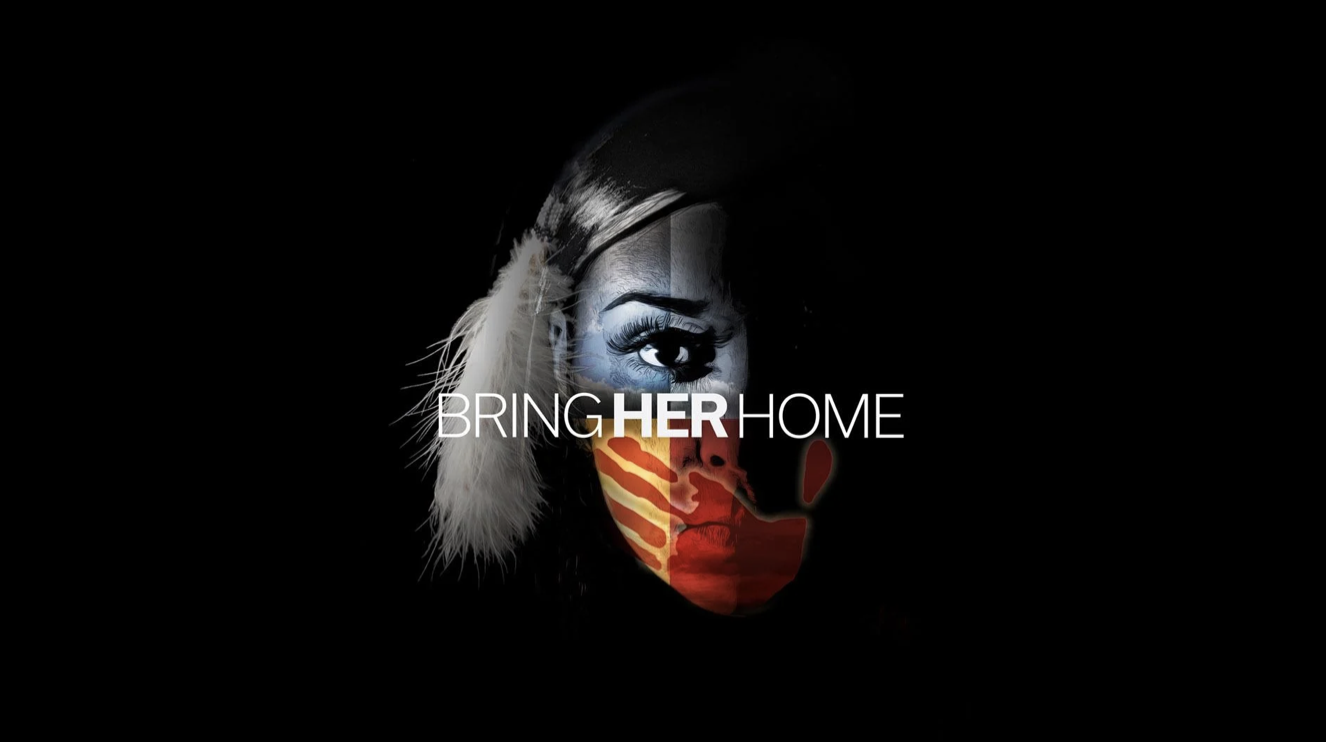 |
 TU, March 22nd:: TU, March 22nd::

Philip J. Deloria: "I Am Not a Mascot" (Trout 45-48) |
|---|
| | * Thesis: NatAmer sports icons = "the most consistently popular [human!?] mascot in American athletic history" (45). | | | | —historical advent in early 20th century (45-46) | | | * WHY?:: | | | | —early "twentieth-century primitivist nostalgia" (cf. the visual and literary arts of the period) (46) | | | | —end of Manifest Destiny; ergo, need to DISPLACE the frontier enterprise/spirit into the sports arena, which thereby became a "metaphor" for the American identity (46) | | | * NatAmer responses (47): | | | | —even some NatAmer claim such mascots as an "honoring"?! | | | | —protests against ~: e.g., AIM (Russell Means & Dennis Banks) | | | * CALL TO ACTION: "Indians need to exert some control over . . . any and all ways they are represented in public discourse." | | | **** FINALLY, note the following film, which deals largely with the Fighting Illini mascot: | | | | In Whose Honor?: American Indian Mascots in Sports. Dir. Jay Rosenstein. New Day Films, 1997.
—Note: You can now "purchase" the vid as a digital download (90-day streaming) at New Day Digital for $4.99? | | | | ** Local Schools:
—UNIVERSITY OF NEBRASKA-OMAHA INDIANS—until 1971
—OMAHA MILLARD SOUTH INDIANS—until 1999 |
|
 Tim Giago: "Indian-Named Mascots" (NAV 172-173) Tim Giago: "Indian-Named Mascots" (NAV 172-173) |
|---|
| | • "Two baseball teams with American Indian symbols and mascots are" playing in "the World Series" (172A). (Given the essay's date—1996—it must be the Atlanta Braves vs. the Cleveland Indians!) | | | • Mainstream media has finally started paying attention to Native protests against such names and mascots, although Giago's "newspaper, Indian Country Today, started the campaign against Indians as mascots more than 13 years ago" (172A). | | | • "If there is an Indian in America who can watch" such teams "and see the actions of the mostly white, often inebriated sports fan, head adorned with turkey feathers, faces painted with streaks, and not feel insulted, they are not true Indians" (172B)!? (Well, can't one be a true—but ignorant—Indian?! [This also smacks of Weaver's "identity police"!?]) | | | • The crux of Giago's argument: "It all boils down to self-esteem and self-respect. . . . If we cannot respect ourselves or if we have low self-esteem, we turn to things that make us forget," such as "drugs and alcohol." Moreover, "if the white society thinks of us as nothing more than mascots for their fun and games, they will not respect us on matters that are more important to our lives" (173A). | | | • Giago's best example/reason: Native children—as he reports of a conversation at a "reservation home" during a Redskins game, and of one child asking, "'Dad why are those wasicus (white people) making fun of us? '" (173A). | | | • Again: "Watch the red-painted faces. Watch the fanatics in the stands wearing . . . feathers in their hair. Watch the fools doing the tomahawk chop and singing that horrible chant." And THEN IMAGINE "that section of fans supporting a team called the African Americans" (173B). | | | • So finally: "Self-respect and self-esteem": "Is that so much to ask? After all, you have taken so much from us. Please return these two important things" (173B). |
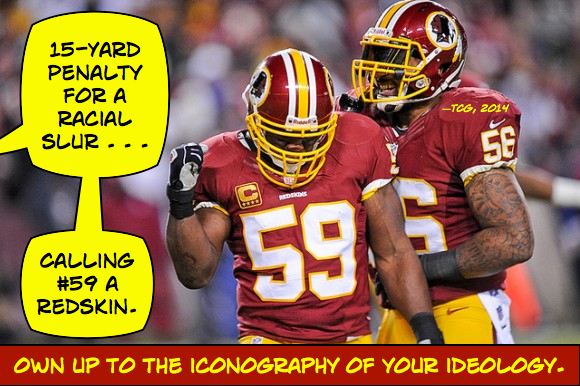 |
|---|
—meme created when the NFL made calling a fellow player
the N- word a 15-yard penalty (2014) |
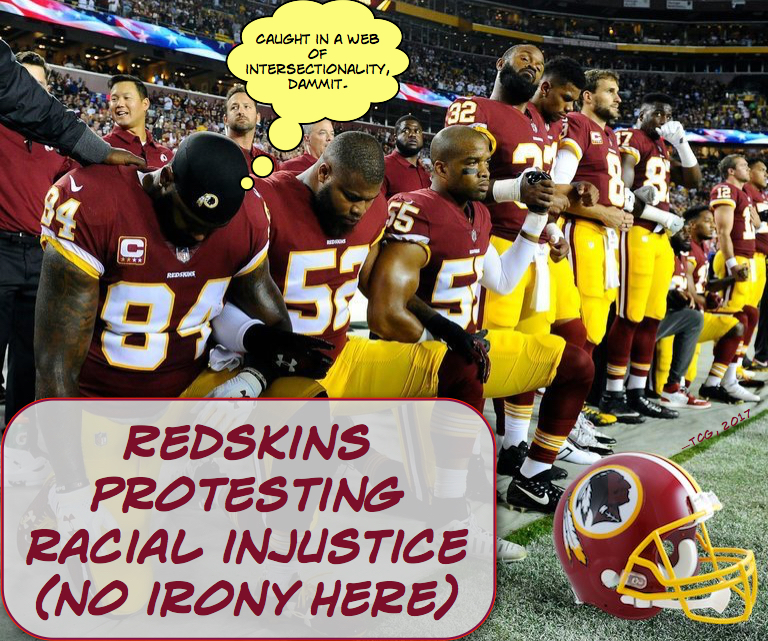 |
|---|
| —no comment necessary— |
 |
|---|
| "My anti-Redskins memes finally won!" ;-} |
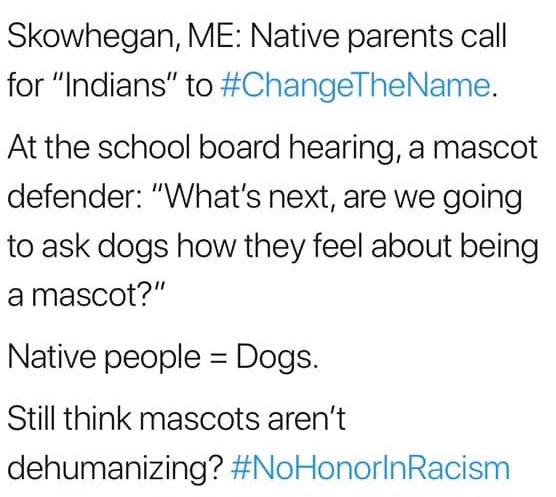 |
|---|
| —I'm making no claim regarding the veracity of this; just found it on Facebook. But it does rather stunningly rehearse the old trope & discourse of Indians = "animals." |
 [New/2022:] P. Deloria's Indians in Unexpected Places: [New/2022:] P. Deloria's Indians in Unexpected Places:
The CRITICAL THEORY Background
|
|---|
| CRITICAL APPROACH | A Few KEY FIGURES | A Few KEY TERMS | By Way of Explanation . . . |
|---|
| Structuralism | de Saussure, Barthes | discourse
sign/signifier/signified
binary
difference
code
trope
semiotics, poetics
narratology, narratemes | Language—or discourse—is a system of meaning, of signifiers (words, images, etc.) and signifieds (concepts) that create and affirm our "reality." In sum, any culture's "knowledge" is determined (structured) by its "linguistics," as it were, its systems of signs (semiotics). For example: stereotypical images (signifiers) immediately conjure their signifieds, or meanings, which are inevitably racist concepts. (E.g.: cigar-store wooden Indian [the image or verbal phrase] => [concept:] Natives are stoic, glum—and thus probably unintelligent.) But, as PD often details, these signs can be contested (leading us to New Historicism [see below]). Finally, language also creates meaning through difference and oppositions—aka binaries—e.g., the noble savage/heathen redskin binary we've been discussing all semester. . . Ah, PD even broaches the subset of structuralism called "narratology": his analysis of the repeated stock plots and characters—which might be dubbed narratemes—in early films about Natives is another characteristic structuralist methodology.
(See, for example, Deloria 5, 10 / 16, 29, 30, 33, 35 / 60, 83, 97, 98 / 113, 122, 124 / 138, 141-143, 144, 165, 166, 167-168, 179 / 184, 192, 196, 205, 219, 220, 221, 222 // 243n14.) |
|---|
Poststructuralism
(≈Social Constructivism;
≈Deconstruction) | Derrida, Foucault, Barthes | deconstruction
constructivism
binary (reversal)
supplementarity
undecidability, indeterminacy
relativism, subjectivism,
perspectivism
(anti-)essentialism | Poststructuralism pushes structuralism to its extreme, contending that reality is not only determined by language (constructivism), but that concepts (including all grand "Truths" and the "Self" itself) never fully mean, are never "whole," since they depend upon their binary opposites to supplement their meaning. Thus "man" does not mean what it thinks it means(!) by itself: it really relies on its opposite ("woman") to "fully" mean. And if all language is based upon such "difference" and relativity, discourse itself becomes a slippery thing, and meaning—including self-identity—is always in flux. (Recall the beginning of Weaver's essay: she was obviously very much influenced by poststructuralism.) For literary scholars, this means that a "text" can never really mean just one thing, especially since binary oppositions can be reversed and an alternative, "opposing" meaning arrived at. . . . Relevant examples: Is there such a thing as a pure concept of "white-ness"? No, poststructuralists argue, since it depends upon the racial Other to even exist. How about the civilization v. barbarism binary? Many historical documents' "main messages" can be reversed by asking, "Who is the real barbarian here?"!? (An act we've performed in class on more than one occasion.) . . . (Note: this skepticism towards absolute truths and the notion that meaning can be a "battle" of oppositions leads directly to New Historicism [below], in which "meaning" is always a contested battlefield.)
(See, for example, Deloria 5, 8-9 / 35, 47, 49 / 64, 67, 96-97, 98, 99, 100 / 122 / 138, 156, 164, 164, 169 / 183 / 232 [via Native "representational acts . . . primitivism and modernity were juxtaposed and revealed to be false categories"—that is, false oppositions], 234, 235, 240 . . . In general, whenever PD "complicates" any of the various structural oppositions he's discussing, one might argue that he's "deconstructing" them, demonstrating that they aren't really pure binary opposites.) |
|---|
| (Neo-)Marxist Theory | Marx, Althusser, Eagleton | class(ism)
ideology
hegemony
bourgeoisie/proletariat
superstructure/base
false consciousness
alienation
commodification
interpellation | Marxists claim that human social reality is largely determined by economic class; at present, capitalism has established the oppression of the upper classes (bourgeoisie) over the lower/working class (proletariat); the former retain their power largely through ideological discourse that naturalizes the status quo and forces the workers to unconsciously accept their fate as cogs in the economic machine (false consciousness). Marxist theory is of interest to "race" theorists because people of color have a much higher poverty rate than whitestream folks—and Native Americans are the poorest of all. . . . (Note, finally, that "ideology" is used by most recent scholars—including PD— in a sense that transcends sheer capitalist economics.)
(See, for example, Deloria 9-10 ["ideology" is best defined on p. 9] / 17, 22, 35, 44, 48 / 55, 56, 58, 61, 69, 71, 92, 106-107 / 124-125, 131 / 136, 141, 146, 148, 150, 152-153, 163, 164, 171, 177, 178, 182 / 225, 230, 231-232, 233 [ideological superstructure "over" the material base], 237) |
|---|
New Historicism
(≈Cultural Materialism) | Foucault, Bakhtin
(and
Philip
Deloria!) | power
discoursescoercion, containment
(versus)
subversion, resistance contestation, negotiation | New Historicism might be called a "footnote" to Foucault, since it's an American critical theory that took French philosopher Foucault's notion of discourse (and "knowledge") as POWER and applied it to texts. For the New Historicist, a "text" (which can be anything: a poem, a bumper sticker, a baseball card, a Native w/ headdress sitting on the hood of a car) is always a reflection of social power at work. (As we see in PD, such ideological power can work upon class, and/or gender, and/or "race"/ethnicity. Note also that, as in PD, a "text" is often a material artifact, like a statue or an automobile.) But then things get complicated: the "text" is not just ONE ideology or "message," but a multitude of competing ideologies or "voices." (The Russian philosopher of language Bakhtin called this "dialogism"—versus "monologism"; New Historists simply claim that all texts are dialogic.) Thus one text can contain dominant "voices" of containment, that reassert the dominant (think white colonial!) power; and yet the texts inevitably "voice" competing messages of resistance, of subversion. (In theory, anyway; going back to poststructuralism, this is another way of saying that all texts deconstruct themselves.) The "text," then, becomes a battlefield of competing ideologies, of incongruous discourses. . . . Note that PD does this immediately in his reading of the photo of the Native woman under the hair dryer (3-6). Also, whenever PD talks about the "secret Indian histories" in which Natives engage with whitestream culture and modernity, these can be read as "submerged," competing discourses that contest the dominant cultural-historical narrative. (Yes: think of "history" itself as a "text." Woh.)
(See, for example, Deloria 5-6, 7, 8-9, 11, 13, 14 / 20, 21, 25, 26 [the first full par. is straight Foucault], 27, 34, 35, 41, 43 [note also that the entire "Violence" chapter's preoccupation with "containment" and "resistance" is a thoroughly New Historicist move] / 53, 60, 63, 64, 65, 67, 68, 69, 71, 85, 93, 94, 99, 101, 104, 107 / 113, 114, 118, 119, 122-123, 131, 133, 134 / 136, 138, 143, 144-145, 153, 157, 162, 163, 164, 167, 168, 169, 176, 177, 178, 180 / 188, 210 / 225, 230, 231, 233 // 245n26.) |
|---|
Postcolonial Theory
(aka Colonial Discourse Theory;
incl. Settler Colonial Theory) | Said,
Bhabha,
Spivak | colonialism, decolonization
"race"
(the Self/)the Other
colonizer/colonized
Orientalism
cultural hybridity | Postcolonial (or "poco") theory, in its simplest definition, is the analysis of texts (written by either the colonizers or the colonized) against the backdrop of the history of Western colonialism and its effect upon both the colonizers and colonized—but especially the latter, of course. Note immediately that "race" is inextricably involved in poco theory. The first major poco-theory book was Edward Said's Orientalism (1978), which made the audacious claim that ALL 19th-century Europeans who spoke of, thought of, Asian and Middle-Eastern peoples were racist! WTH?! Why? Well, because the entire ideological discourse of the European writers, social scientists, travelers, etc., of the day repeated the same old stereotypes of the "Oriental" as lazy, as sensual, as culturally backwards, etc. (Hey, where have we heard THAT before?!) Many of PD's analyses trace a similar ideological racism, from the late 19th- thru the 20th century.
(Of course, I could list almost every page as at least dealing indirectly w/ poco theory; but see, for example, Deloria 6, 7-9, 12, 13, 14 / 17, 18, 20, 24, 25-26, 27, 28-29, 32, 34, 35, 43, 44, 45, 46, 47, 48, 49-50 / 52-53, 55, 58, 60, 61, 62, 65, 67, 71, 72, 78, 80, 82, 83-84, 84-85, 87, 88-89, 91, 92, 96, 99, 100, 103, 104, 105, 107 / 109, 112, 113-114, 116, 120-122, 123, 124-125, 126, 130, 131 / 136, 138, 139, 141, 143, 144-145, 146, 147,150, 151, 152, 153, 156, 166, 167, 168-169, 177, 178, 180-181, 182 / 183-184, 185, 186, 191-192, 194, 195, 196, 197, 198, 199, 201, 202, 203, 204, 205, 207, 210, 215, 216-217, 221, 222, 223 / 224-225, 229-230, 231, 232, 233, 234, 235, 236, 237, 240 // 245n24, 246n29, 280n41, 286n10.) |
|---|
• Other critical theories that PD at least nods to could have also been included, such as feminism—note the many discussions of gender, "masculinity," and "femininity" (see below!)—and psychoanalytical theory. Notice that neither PD or I mention "Critical Race Theory"!—although its key concept, institutional racism, is certainly implicit in PD's discussion of ideology, etc., and many of its assumptions about the centrality of racism have already been major concerns of postcolonial theories (since, as intimated above, the "colonized" have by and large been people of color).
| [Later Add:]
Feminist Theory | (See, for example, Deloria 4, 5, 7, 11, 13, 14 / 19, 20, 48 / 65, 84-88, 96 / 118, 124-125, 131 / 138, 146, 156, 164-165, 173 / 216-217 / 233, 240 // 267n16, 272n53.) |
|---|
|
|---|
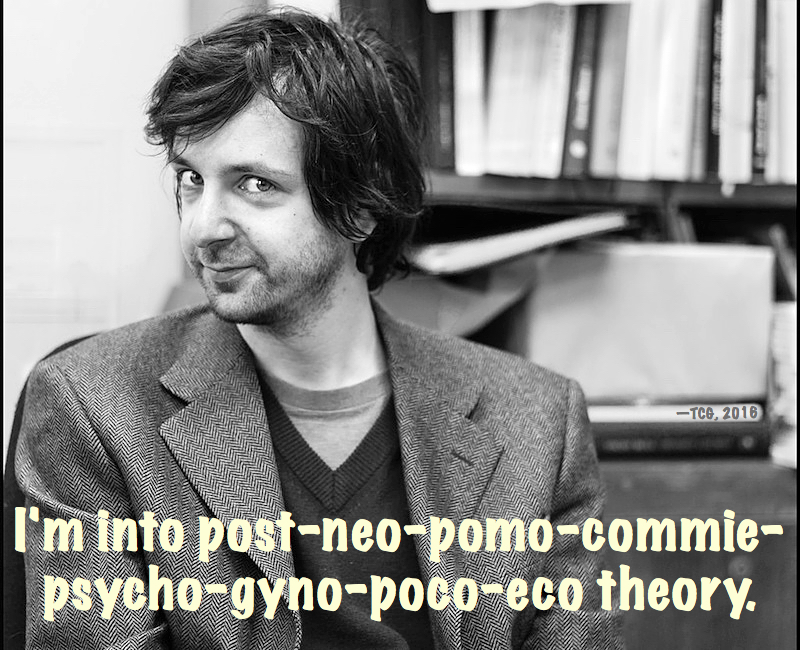 |
|---|
| Of course, nowadays, most lit-crit-theory folks are eclectic in their critical methodologies. |
| * * * * INDIANS IN UNEXPECTED PLACES —Philip J. Deloria, 2004 * * * * |  |
|---|
 P. Deloria: "Introduction: Expectation and Anomaly" (3-14) P. Deloria: "Introduction: Expectation and Anomaly" (3-14) |
|---|
| "Chuckle" (3-4) |
|---|
| * Due to time considerations, my "notes" to this intro chapter will be pretty "bare bones," mostly indications of "significant" pages/paragraphs #'s ("contin." = continuing). | | | • the "traditional" Native woman under the hair dryer/at the beauty salon (photo) (2)! | | | • p. 4, 1st contin. ¶: PD's 1st summary of Native stereotypes | | "Expectation and Anomaly" (4-7) |
|---|
| | • 4, 1st ¶ of section, last sentence | | | • 6, 2nd full ¶: good summary/thesis statements | | | • 7, 1st contin. ¶, last sentence | | "Stereotype, Ideology, Discourse, and Power" (7-11) |
|---|
| | • PD makes some of these terms more complicated than they really are, so let me try to clarify them: |  stereotype—we know what this is; note that stereotypes, like racism in general, is integral to the maintenance of social power (8, 1st ¶; 9, 1st ¶; 11, 1st contin. ¶). The other three terms are from (mostly Marxist) critical theory:::: stereotype—we know what this is; note that stereotypes, like racism in general, is integral to the maintenance of social power (8, 1st ¶; 9, 1st ¶; 11, 1st contin. ¶). The other three terms are from (mostly Marxist) critical theory:::: |  ideology—a (largely) unconscious belief or set of beliefs accepted as true by a group of people (e.g., racism, religion, the American Dream); see 9, 2nd ¶, last sentence for PD's best definition; see also 9, 3rd ¶: "Ideologies . . . are not, in fact, true, but, as things [largely unconscious ideas] that structure real belief and action in a real world, they might as well be." Thus my statement in class a while back, that "race" may be an illusion, but racism as an ideology has still caused lots of real death and trauma for bodies of color for a good 500 years. . . . See also 10, 1st ¶; 11, 1st contin. ¶ ideology—a (largely) unconscious belief or set of beliefs accepted as true by a group of people (e.g., racism, religion, the American Dream); see 9, 2nd ¶, last sentence for PD's best definition; see also 9, 3rd ¶: "Ideologies . . . are not, in fact, true, but, as things [largely unconscious ideas] that structure real belief and action in a real world, they might as well be." Thus my statement in class a while back, that "race" may be an illusion, but racism as an ideology has still caused lots of real death and trauma for bodies of color for a good 500 years. . . . See also 10, 1st ¶; 11, 1st contin. ¶ |  discourse—any semiotic (meaningful) "language," especially that through which ideology can be disseminated (i.e., "discourses of power")—not only the written and spoken word, but graphic images, etc. (incl. the "redskin" on a football helmet; a Confederate flag[, hell, a U.S. flag!]; a cross . . .) discourse—any semiotic (meaningful) "language," especially that through which ideology can be disseminated (i.e., "discourses of power")—not only the written and spoken word, but graphic images, etc. (incl. the "redskin" on a football helmet; a Confederate flag[, hell, a U.S. flag!]; a cross . . .) |  power—through ideological discourse (or discourses of power), the dominant class, "race," culture, etc., exerts its power over the (groups of) oppressed, largely without having to fire a shot! (8, 1st ¶; 9, 1st ¶; 11, 1st contin. ¶) power—through ideological discourse (or discourses of power), the dominant class, "race," culture, etc., exerts its power over the (groups of) oppressed, largely without having to fire a shot! (8, 1st ¶; 9, 1st ¶; 11, 1st contin. ¶) | | | • 11, 1st full ¶, last sentence ("anomalous" v. "unexpected") | | "Essay" (11-14) |
|---|
| | • largely a summary of the book's chapters (13-14) |
 P. Deloria: "Violence: The Killings at Lightning Creek" (15-51) P. Deloria: "Violence: The Killings at Lightning Creek" (15-51) |
|---|
 P. Deloria: "Representation: Indian Wars, the Movie" (52-108) P. Deloria: "Representation: Indian Wars, the Movie" (52-108) |
|---|
 TH, March 24th:: TH, March 24th::
 P. Deloria: "Athletics: 'I Am of the Body': My Grandfather, Culture, and Sports" (109-135) P. Deloria: "Athletics: 'I Am of the Body': My Grandfather, Culture, and Sports" (109-135) |
|---|
.jpg)
|
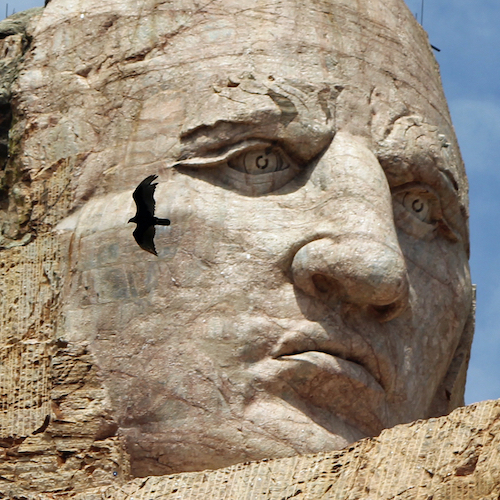



.gif)
.gif)
.jpg)
.jpg)
.jpg)
.jpg)
.jpg)
.jpg)
.jpg)
.jpg)
.jpg)